- Chapter 1 Exercise 1.1 Sequences and Series
- Chapter 1 Exercise 1.2 Sequences and Series
- Chapter 1 Exercise 1.3 Sequences and Series
- Chapter 1 Exercise 1.4 Sequences and Series
- Chapter 1 Exercise 1.5 Sequences and Series
- Chapter 1 Practice Test Exercise Sequences and Series
- Chapter 1 Review Exercise Sequences and Series
- Chapter 2 Exercise 2.1 Trigonometry
- Chapter 2 Exercise 2.2 Trigonometry
- Chapter 2 Exercise 2.3 Trigonometry
- Chapter 2 Exercise 2.4 Trigonometry
- Chapter 3 Exercise 3.1 Quadratic Functions
- Chapter 3 Exercise 3.2 Quadratic Functions
- Chapter 3 Exercise 3.3 Quadratic Functions
- Chapter 3 Review Exercise Quadratic Functions
McGraw Hill
McGraw Hill Pre Calculus 11 Student Edition Chapter 3 Review Exercise Quadratic Functions
Pre-Calculus 11 Student Edition Chapter 3 Quadratic Functions
Page 198 Problem 1 Answer
We have in the standard vertex form,
f(x)=(x+6)2−14.
Then we need to find the vertex, the axis of symmetry, the direction of opening, the maximum or minimum value, and the domain and range without graphing.
Compare y=(x+6)2−14 with y=a(x−p)2+q.
a=1,p=−6,q=−14
We observe that vertex is at (−6,−14) and axis of symmetry at x=−6.
And we have a=1>0 so the graph opens upward . Minimum value is -14 since the parabola opens upward
Domain of given parabola is (−∞,∞)& range is {y∣y≥−14,y∈R}.
The quadratic function has Vertex : (−6,−14). Axis of symmetry: x=−6.
Graph opens upwardMinimum value is −14.
Domain is (−∞,∞).Range is {y∣y≥−14,y∈R}.
Precalculus Textbook Mcgraw Hill Answers
Page 198 Problem 2 Answer
We have in the standard vertex form,f(x)=−2x2+19.
Then we need to find the vertex, the axis of symmetry, the direction of opening, the maximum or minimum value, and the domain and range without graphing.
Compare y=−2x2+19 with y=a(x−p)2+q.
a=−2,p=0,q=19
We observe that vertex is at (0,19) and axis of symmetry at x=0 .
And we have a=−2<0 so the graph opens downward.
Maximum value is 19 since the parabola opens downward.
Domain of given parabola is(−∞,∞) & range is {y∣y≤19,y∈R}.
The quadratic function has Vertex : (0,19) . Axis of symmetry:x=0
Graph opens downward.
Maximum value is 19.
Domain is(−∞,∞).
Range is{y∣y≤19,y∈R}.
Read and Learn More Precalculus Textbook Mcgraw Hill Answers
Page 198 Problem 3 Answer
We have in the standard vertex form,f(x)=1/5(x−10)2+100.
Then we need to find the vertex, the axis of symmetry, the direction of opening, the maximum or minimum value, and the domain and range without graphing.
Comparey=1/5(x−10)2+100 with y=a(x−p)2+q.
a=1/5,p=10,q=100
We observe that vertex is at(10,100) and axis of symmetry at x=10.
And we have a=1/2>0 so the graph opens upward . Minimum value is 100 since the parabola opens upward.
Domain of given parabola is(−∞,∞) & range is{y∣y≥100,y∈R}
Vertex :(10,100).Axis of symmetry:x=10 Graph opens upwards.Minimum value is 100.Domain is (−∞,∞) .Range is{y∣y≥100,y∈R}.
Page 198 Problem 4 Answer
We have in the standard vertex form,
y2=−6(x−4)2+0
We observe that vertex is at (4,0) and axis of symmetry at x=4
And we have a=−6<0, we have maxima at the point (4,0).
Since,maxima exists at the vertex, the parabola is an open down parabola.
Domain of y is (−∞,−∞), range is (−∞,0)
It is an open down parabola with vertex at (4, 0), Has axis of symmetry at x = 4 and maxima at x = 0and the maximum value is y = 0.
Precalculus Textbook Mcgraw Hill Answers
Page 198 Problem 5 Answer
We have the quadratic equation written in the standard vertex form:
f(x)=2(x+1)2−8
Therefore, we have a=2,p=−1,q=−8
We have the sketch of the graph:

We observe that the vertex exists at (−1,−8), with axis of symmetry on the line x=−1,
We see that the vertex is a point of minima. The domain of the graph is (−∞,∞) and range is [−8,∞)
Vertex is the minima, is at (−1,−8), we have domain as (−∞,∞) and range as [−8,∞)
Page 198 Problem 6 Answer
We have the quadratic equation given in the vertex form:
f(x)=−0.5(x−2)2+2
a=−0.5,p=2,q=2
We have sketch of the graph:
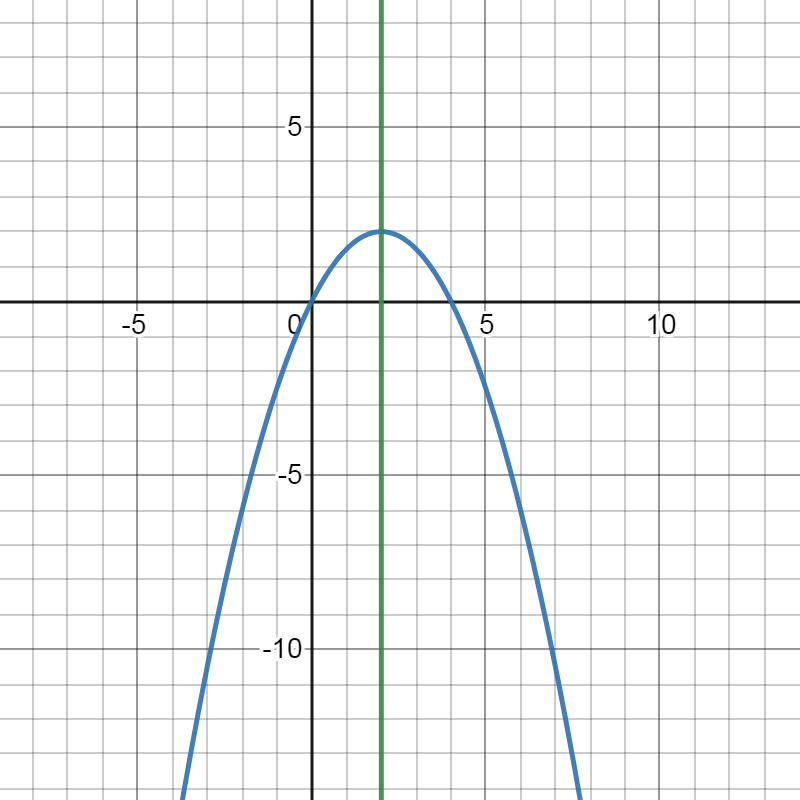
We observe that the vertex exists at (2,2) and the line x=2 is the axis of symmetry
Maxima exists at (2,2), the domain of the graph is (−∞,∞) rang is (−∞,2]
Vertex exists at (2,2), it is the point of maxima. Axis of symmetry is the line x=2.
Domain of the graph is (−∞,∞) range is (−∞,0]
Precalculus Textbook Mcgraw Hill Answers
Page 198 Problem 7 Answer
We have the equation : y=−3(x−5)2+20
Therefore a=−3,p=5,q=20
For x-intercepts we need
y=0=−3(x−5)2+20
⟹(x−5)2
=20/3 (x−5)=±√20/3
⟹x=±√20/3+5
For y-intercept we need x=0, therefore we have y=−3(−5)2+20⟹y=−55
Number of x-intercepts are two and there exists one y-intercept.
Page 198 Problem 8 Answer
We are given a parabola with domain and range conditions as follows:
Domain: (−∞,∞)
Range: [0,∞)
We need a parabola of the form
y=a(x−p)2+q with a>0 and q≥0
There exists one-intercept each at y and x-axes when q=0
There exists no x-intercept one y-intercept at (0,q) for q>0.
There exists one x and one y-intercept for q=0 at the origin. When q>0, we have only y-intercept at (0,q)
Page 198 Problem 9 Answer
We have the equation y=3x2+9
Therefore we have a=3,q=0,p=9,
We know that for q>0, there exists only one y-intercept at (0,q).
We have q=9>0, therefore the y-intercept of the parabola is at (0,9).
There exists no x-intercept.
There exists a y-intercept at (0,9), there is no x-intercept.
Mcgraw Hill Precalculus Textbook Answers
Page 198 Problem 10 Answer
Given a parabola with a vertex at(−4,−6)
We can determine the quadratic function in vertex form if know the coordinates of the vertex and at-least one other point.
We can determine the number of x-intercepts of a graph of a quadratic function using the value of a to determine if the graph opens upward or downward and the value of q to determine if the vertex is above, below, or on the x-axis.
But we have only coordinate of vertex so we can’t determine the quadratic function in vertex form and Also we can’t determine the number of x-intercepts of a graph of a quadratic function.
Because we don’t know the graph opens upward or downward.
We can’t determine the number of x-intercepts in a parabola with a vertex at(−4,−6)
Page 198 Problem 11 Answer
There is given a graph of a parabola.
It is asked to determine a quadratic function in vertex form.
The quadratic function can be found by finding the vertex and applying the vertex form of the parabola formula.
Firstly, we can find the vertex from the graph
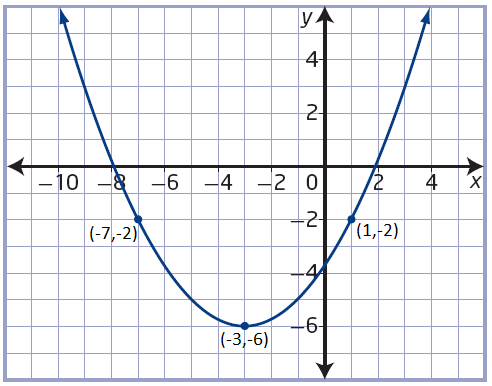
We know that vertex of any parabola is the point where the graph changes its shape.
The graph is changing shape at(−3,−6)
So, the vertex is(p,q)=(−3,−6)
Apply vertex form of the parabola formula:y=a(x−p)2+q
Plug vertex point into the formula
y=a(x+3)2−6 −−−−−(1)
Now, we can select anyone point and find a
The point is(1,−2)
Plug this point in equation (1) we get
−2=a(1+3)2−6
−2+6=a(4)2
4=16a
a=4/16
a=1/4
Plug this value into the formula (2) we get
y=1/4(x+3)2−6
which is required quadratic function.
The quadratic function in vertex form is y=1/4(x+3)2−6
Mcgraw Hill Precalculus Textbook Answers
Page 198 Problem 12 Answer
The given graph of the parabola is as following :-
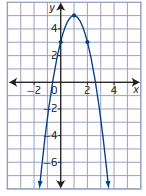
We have to find the quadratic function of the graph in vertex form.
Firstly we will find the vertex of the parabola from the graph and then use the vertex form formula for parabola.
From the above graph, we can see that the parabola changes its shape at point (1,5).
So the vertex of the parabola (p,q)=(1,5)
Apply the vertex form of parabola y=a(x−p)2+q, then we have :-
y=a(x−1)2+5.
Now consider a point of parabola . Let the point is (0,3). By putting this point in the above equation then we have :-
3=a(0−1)2+5
⇒3=a(−1)2+5
⇒3=a+5
⇒a=3−5
⇒a=−2
Put the value of a=−2, then we have :-
y=−2(x−1)2+5.
This is the required quadratic function of given graph in the vertex form.
The required quadratic form for the given graph in vertex form is y=−2(x−1)2+5.
Mcgraw Hill Precalculus Textbook Answers
Page 199 Problem 13 Answer
The cable of the bridge is a shape of a parabola.
The length of the complete bridge is 274m, the lowest point of the cable is 30m above the water surface, and the highest point of the bridge is 52m above the water surface.
The bridge looks like:

We know that, equation of a parabola with it’s vertices (p,q) is y=a(x−p)2+q.
We put the co-ordinate values of p and q to the quadratic to find the equation of the parabola at different locations of the origin.
(1) When the origin is at the minimum point of the cable:
The minimum point of the cable is the vertex of the parabola.
So, the graph of the parabola representing the curved cable will look like:

Therefore, the value of (p,q)=(0,0). Hence the equation of the parabola in this case will be
y=a(x−p)2+q
⇒y=a(x−0)2+0
⇒y=ax2
(2) a point on the water’s surface directly below the minimum point of the cables
The distance from the water surface to the minimum point of the parabola is 30m. Hence the graph of the parabola is as follows:
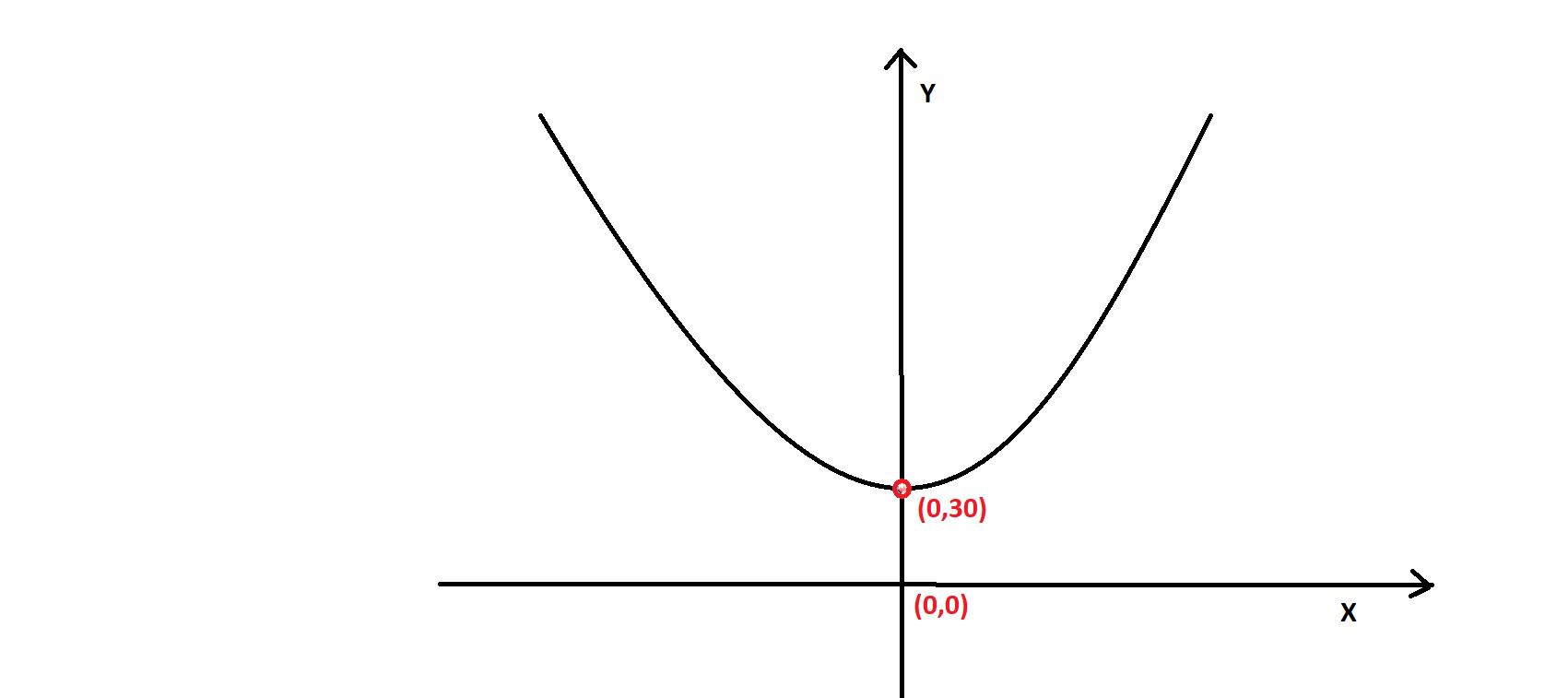
Hence, the vertex of the parabola is (0,30). So, (p,q)=(0,30).
The equation of the parabola will be
y=a(x−p)2+q
⇒y=a(x−0)2+30
⇒y=ax2+30
(3) When the origin is at the base of the tower on the left:
The horizontal distance of the vertex of the bridge from the base of the tower on the left is half the length of the bridge, i.e. 274/2=137m and the vertical distance is 30m.
So the graph will look like:
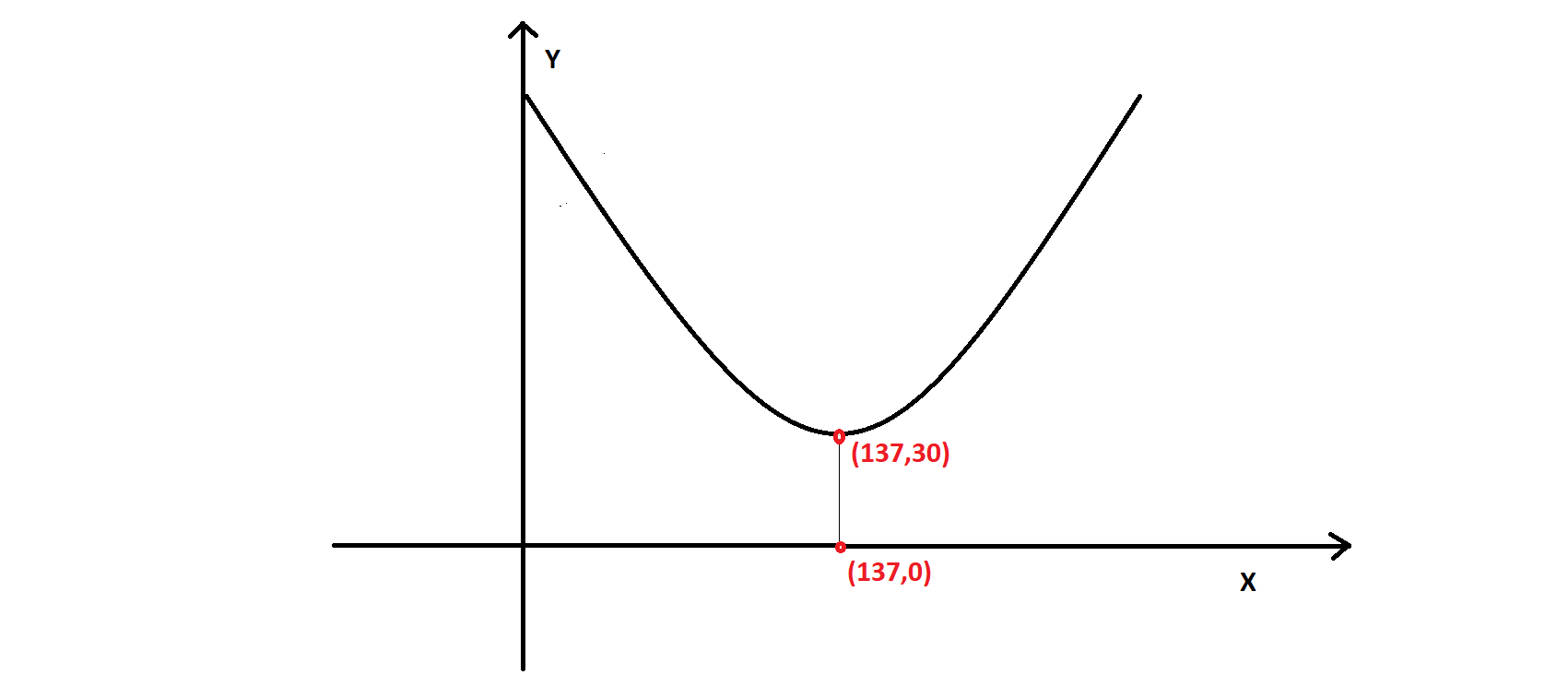
Hence, for this condition we have (p,q)=(137,30). So, the equation of the parabola will be
y=a(x−p)2+q
⇒y=a(x−137)2+30
⇒y=a(x2−2.x.137+18,769)+30
⇒y=ax2−274ax+18,769a+30
The equation of the shape of the cable when the origin is at
(1) When the origin is at the minimum point of the cable: y=ax2
(1) a point on the water’s surface directly below the minimum point of the cables: y=ax2+30
(3) When the origin is at the base of the tower on the left: y=ax2−274ax+18,769a+30
Mcgraw Hill Precalculus Textbook Answers
Page 199 Problem 14 Answer
Given: The distance between the towers is 274m.

Towers at a height of 52m above the surface of the water, and the lowest point of the cables is 30m above the water’s surface.
We have to explain Would the quadratic function change over the course of the year as the seasons change.
The shape is in Parabolic in nature, which is in the form of ax2+bx+c=0
So, The function will change as the seasons change with the heat or cold changing the length of the cable and therefore the function.
Hence, The function will change as the seasons change with the heat or cold changing the length of the cable and therefore the function respectively.
Page 199 Problem 15 Answer
We have given that :- The flea jumps 30cm high from the ground and 15cm away from his starting point.
The point from the flea is jumped is the origin.
We have to determine the quadratic function in vertex form to model the height of the flea compared to the horizontal distance traveled.
We will apply the formula of quadratic function in vertex form.
Here we have the the flea fly at the height 30cm and 15cm long horizontally from the starting point. The starting point is origin.
So the graph of his fly is as following :-
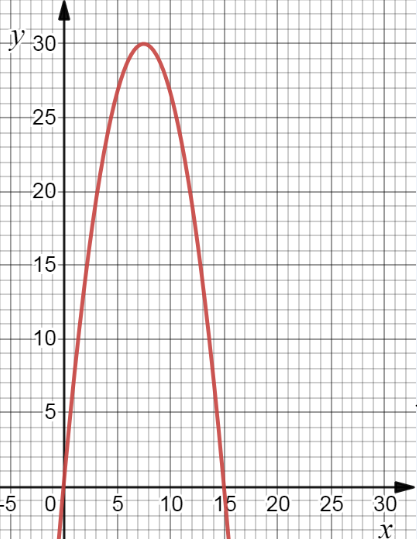
We can see that the vertex of the graph is (p,q)=(15/2,30)
Using the vertex form of parabola y=a(x−p)2+q, then we have :-
y=a(x−15/2)2+30
As (0,0) is the point of parabola. So it satisfies the above equation, then we have :-
0=a(0−15/2)2+30⇒0
=a(225/4)+30⇒225/4
a=−30
⇒a=−30⋅4/225
⇒a=−8/15
Put this value of a=−8/15, then we have :-
y=−8/15(x−15/2)2+30
⇒y=−0.534(x−7.5)2+30
This is the required quadratic function in vertex form.
The required quadratic function in the vertex form is :- y=−0.534(x−7.5)2+30
Mcgraw Hill Precalculus Textbook Answers
Page 199 Problem 16 Answer
The given graph of parabola is as following :-

We have to find the vertex, axis of symmetry, maximum or minimum value, direction of opening, domain and range and any intercepts.
The given graph is :-
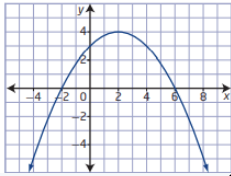
We can see that the curve changes its shape at point (2,4).
So the vertex of the graph is (p,q)=(2,4).
The graph is symmetric about the line x=2.
So the axis of symmetry is x=2.
The maximum value of the function is y=4 at x=2.
Also the function has no minimum value.
As the graph of parabola is closed from top and open from bottom.
So the graph is opens downward.
There exists a value of y for all values of x.
So the domain of the function is {x∣x∈R}.
As the graph is exist for all y≤4.
So the range of the function is {y∣y≤4,y∈R}.
As the graph cuts the x-axis at points x=−2,6.
So the x-intercepts are (−2,0) and (6,0) .
Also the graph cuts the y-axis at point y=3.
So the y-intercept is (0,3).
The required observations for the given graph are :-
The vertex of the graph is (2,4).
The axis of symmetry is x=2.
The maximum value of the function is y=4.
The graph is opens downward.
The domain of the function is {x∣x∈R].
The range of the function is {y∣y≤4,y∈R}.
The x-intercepts are (−2,0) and (6,0).
The y-intercept is (0,3).
Page 199 Problem 17 Answer
Given:
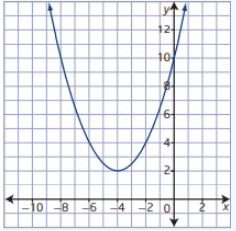
To identify the vertex, axis of symmetry, maximum or minimum value, direction of opening, domain and range, and any intercepts:
Use the definition of the upward parabola and find all the values based on this.
We have,

The vertex is lowest point on the graph which is(−4,2).
Axis of symmetry is the vertical line goes through the vertex and dividing the parabola into two equal parts.
So, we have x=−4.
For maximum and minimum value:
This is depend on the y−coordinate of the vertex.
If a>0 the vertex is the lowest point on the graph so the graph has a minimum value k.
Ifa<0, the vertex is the highest point on the graph so the graph has a maximum value k.
Here, 2>0
So, the graph has minimum value which is 2.
We knowa>0
So, the graphs open upwards.
Domain of the graph is(−∞,∞) and the range is[2,∞).
x−intercept: None
y−intercept:(0,10).
Hence, the values are Vertex: (−4,2)
Axis of symmter y:x=−4
Minimum value:y=2
Direction of opening: Upward
Domain:(−∞,∞)
Range:[2,∞)
x−intercept: None
y−intercept: (0,10)
Mcgraw Hill Precalculus Textbook Answers
Page 199 Problem 18 Answer
Given: y=7(x+3)2−41
To show why the given function fits the definition of a quadratic function:
Write the given function as ax2+bx+c.
Given:
y=7(x+3)2−41
Apply the formula(x+y)2=x2+y2+2ab
y=7(x2+32+2⋅x⋅3)−41
y=7(x2+9+6x)−41
y=7x2+63+42x−41
y=7x2+42x+22
Here, we can see that the equation is written in the form of y=ax2+bx+c.
Hence, it fits into the quadratic equation.
Hence, it has been showing that the given function fits the definition of a quadratic function.
Page 199 Problem 19 Answer
Given: y=(2x+7)(10−3x)
To show why the given function fits the definition of a quadratic function:
Write the given function asax2+bx+c.
We have, y=(2x+7)(10−3x)
Apply FOIL method:(a+b)(c+d)=ac+ad+bc+bd
y=2x⋅10+2x⋅(−3x)+7⋅10+7⋅(−3x)
y=20x−6x2+70−21x
y=−6x2−x+70
Here, we can see that the equation is written in the form of y=ax2+bx+c.
Hence, it fits into the quadratic equation.
Hence, it has been showing that the given function fits the definition of a quadratic function.
Page 199 Problem 20 Answer
Given: f(x)=−2x2+3x+5
To draw the graph of the function:
Use the graphing calculator to draw the graph of the function.
We have,
f(x)=−2x2+3x+5
Draw the graph:

Now, find the vertex
The parabola parameters are:
a=−2,b=3,c=5
xv=−b/2a
xv=−3/2(−2)
xv=3/4
Plug the value of xv in the given function:
yv=−2(3/4)2+3(3/4)+5
yv=49/8
Therefore the parabola vertex is (3/4,49/8)
Ifa<0, then the vertex is the maximum value.
So, the maximum value is y=49/8.
The Axis of symmetry is the vertical line that goes through the vertex and divides the parabola into two equal parts.
So, we have x=3/4.
We knowa<0.
So, the graphs open downwards.
The domain of the graph is(−∞,∞)
and the range is(−∞,49/8].
x−intercepts:(−1,0),(2.5,0)
y−intercept:(0,5)
Hence, the graph of the parabola is

Vertex:(3/4,49/8)
Axis of symmetry:x=3/4
Maximum value:y=49/8
Direction of opening: Downward
Domain:(−∞,∞)
Range:(−∞,49/8]
x−intercepts:(−1,0),(5/2,0)
y−intercept:(0,5)
Mcgraw Hill Precalculus Textbook Answers
Page 199 Problem 21 Answer
Given: f(x)=−2x2+3x+5
To explain the features of the graph:
First, draw the graph by graphing calculator then use the graph definition of the upward parabola to find the features.
We have, f(x)=−2x2+3x+5
Graph of the parabola:
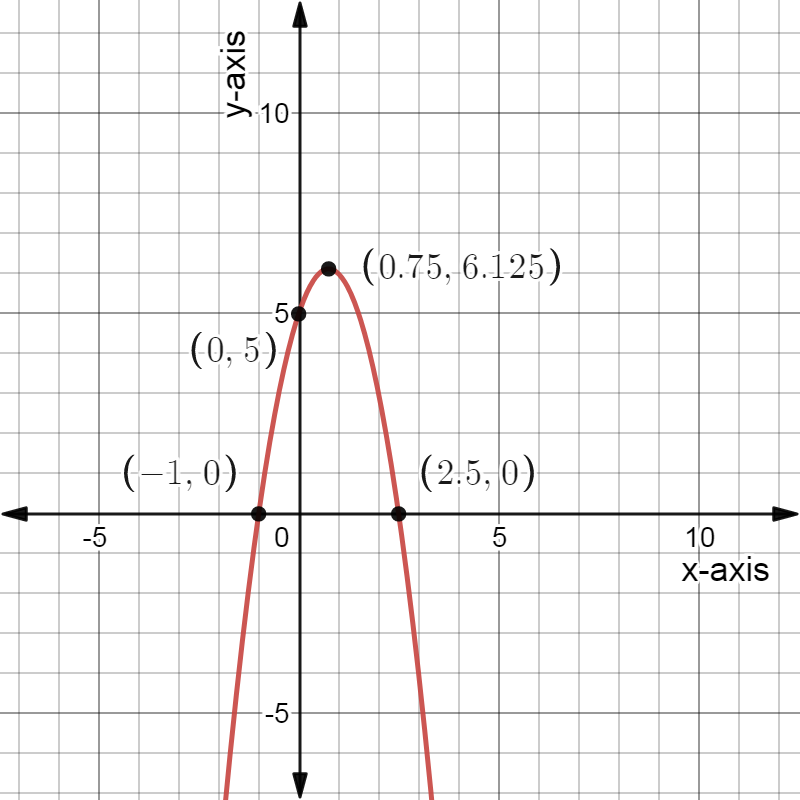
Vertex: The vertex of an up-down facing parabola of the form y=ax2+bx+c is(xv,yv)
where xv=−b/2a
So, we will compare the given function y=ax2+bx+c to finda,b, and c. Plug these values in−b/2a.
The axis of symmetry is x=h is the equation of the vertical line through the vertex.
The direction of the opening depends on a.
If a>0 graph upward and a<0 graph downward.
For maximum and minimum value: This depends on they−coordinate of the vertex.
Ifa>0 the vertex is the lowest point on the graph so the graph has a minimum value k.
Ifa<0, the vertex is the highest point on the graph so the graph has a maximum valuek.
The domain of the parabola is always(−∞,∞). and the range depends on the y−coordinate,k,
of the vertex and the orientation of the parabola.
x−intercept is the point wherey=0.
y−intercept is the point wherex=0.
Hence, the vertex of an up-down facing parabola is(xv,yv).
The axis of symmetry is x=h is the equation of the vertical line through the vertex.
The direction of the opening depends on a.
For the maximum or minimum value, this depends on they−coordinate of the vertex.
The domain of the parabola is always(−∞,∞) and the range depends on they−coordinate of the vertex.
x−intercept is the point where y=0. y−intercept is the point where x=0.
McGraw Hill Pre Calculus 11 Student Edition Chapter 3 Exercise 3.3 Quadratic Functions
Pre-Calculus 11 Student Edition Chapter 3 Quadratic Functions
Page 180 Problem 1 Answer
It is given that she sold mukluks for $400 per pair, and she sold 14 pairs.
She predicts that for every $40 increase in price, she will sell one fewer pair.
we have to complete the table by given information.
The completed table is shown as
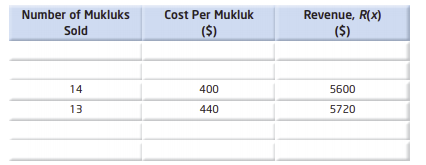
Revenue=16×320=5120
Revenue=15×360=5400
Revenue=14×400=5600
Revenue=13×440=5720
Revenue=12×480=5760
Revenue=11×520=5720

Therefore, we see that while increasing the price, we see that there is increase in the total revenue but at one point the total revenue is decrease when number of Mukluks sold is 11.

Page 181 Problem 2 Answer
Given: We are given that x represents the number of $40 increase
To find: We have to determine an expression to represent the cost of the mukluks.
We are given that
Mcgraw Hill Precalculus Textbook Answers
RevenueR(x)= (number of Mukluk sold)(Cost per mukluk)
Hence Cost of mukluk=Revenue/no.of.mukulksold
hence Cost of mukluk=Revenue/no.of.mukluksold
Read and Learn More Precalculus Textbook Mcgraw Hill Answers
Page 181 Problem 3 Answer
Given: RevenueR(x)= (number of mukluk sold)(cost per mukluk)
We have to determine an expression to represent the number of mukluks sold.
We are given that
RevenueR(x)= (number of mukluk sold)(cost per mukluk)
Hence Number of mukluk sold=Revenue/no.of.mukluksold
Hence the expression representing mukluk sold can be given as Revenue/no.of,mukluksold.
Page 181 Problem 4 Answer
Given: Last year, Adine sold mukluks for $400 per pair, and Adine sold 14 pairs. She predicts that for every $40 increase in price, she will sell one fewer pair.
We know that, revenue function is given by, R(x), where R(x) = (Number of Mukluks Sold)(Cost Per Mukluk).
Let x represents the number of increases to her price.
Adine sold mukluks for $400 per pair. So,Cost per Mukluk = $400+40x
Also, She predicts that for every $40 increase in price, she will sell one fewer pair. So,
Number of Mukluks Sold = 14−1x
Hence, the revenue function is given by,
R(x)=(14−1x)(400+40x)
Therefore, the required revenue function is R(x)=(14−x)(400+40x)
Mcgraw Hill Precalculus Textbook Answers
Page 181 Problem 5 Answer
From previous part of the problem, we already have the revenue function
R(x)=(14−1x)(400+40x)
We have to expand R(x) to give a quadratic function in standard form.
Given: R(x)=(14−1x)(400+40x)
Now we expand this expression.
R(x)=(14−1x)(400+40x)
=(−x+14)(40x+400)
=−x⋅40x−x⋅400+14⋅40x+14⋅400
=−40x2
−400x+560x+5600
=−40x2+160x+5600
Therefore, the required revenue function in standard quadratic function is R(x)=−40x2+160x+5600
Page 181 Problem 6 Answer
From previous part of the problem, we already have the revenue function R(x)=(14−1x)(400+40x)
We have to graph R(x).
The graph of the equation R(x)=(14−1x)(400+40x) is
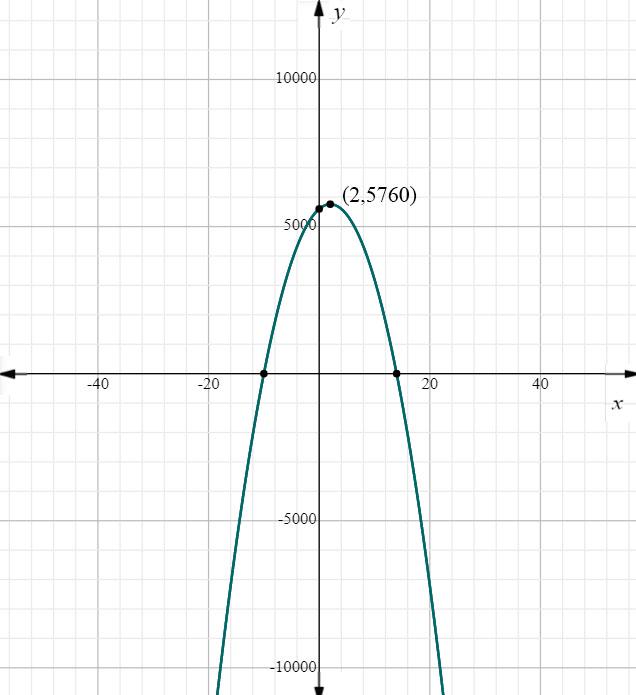
Therefore, the required graph of the revenue function R(x)=(14−1x)(400+40x) is

Page 181 Problem 7 Answer
From previous part of the problem, we already have the revenue function
R(x)=(14−1x)(400+40x)
where x represents the number of increases to her price. and graph of this function:
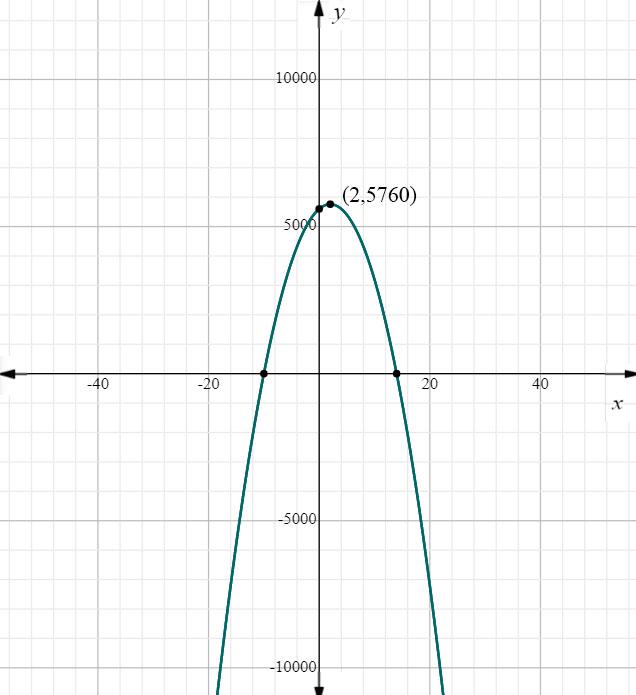
The graph of the given revenue function is a parabola which opens downwards.
Hence, the maximum value is corresponding to the x−coordinate of the vertex.
From graph, the vertex is (2,5760).
Hence, Maximum possible revenue is $5760.
Therefore, the maximum possible revenue can Adine expect is $5760.
Mcgraw Hill Precalculus Textbook Answers
Page 181 Problem 8 Answer
From previous part of the problem, we already have the revenue function
R(x)=(14−1x)(400+40x)
where x represents the number of increases to her price.
and graph of this function:
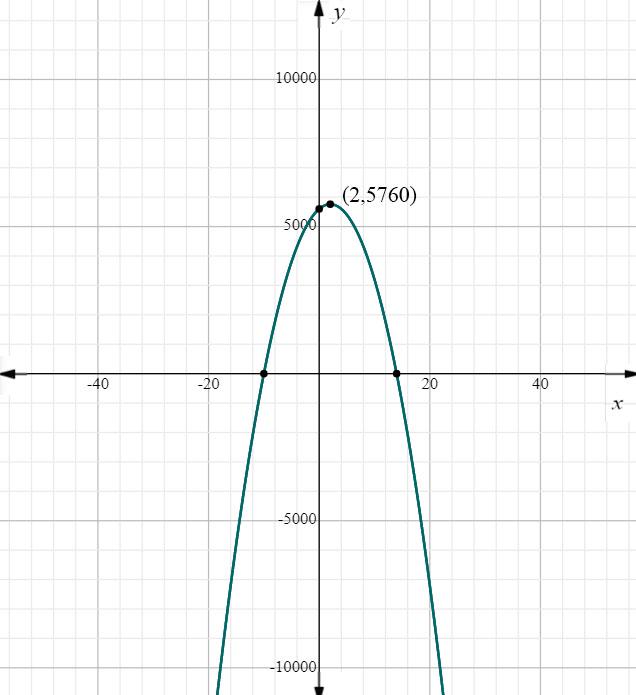
The graph of the given revenue function is a parabola which opens downwards.
Hence, the maximum value is given by the y−coordinate of the vertex.
From graph, the vertex is (2,5760).
Hence, Maximum possible revenue is obtained by 2 times increase in her price.
That is, Cost per Mukluk
=400+40x
=400+40(2)
=400+80
=480
Therefore, selling at $480 price would give her the maximum possible revenue.
Mcgraw Hill Precalculus Textbook Answers
Page 181 Problem 9 Answer
Given Function:
R(x)=−40(x−2)2+5760
From the previous problem, we have Adine’s function,
R(x)=(14−1x)(400+40x)
Now we expand the given functionR(x)=−40(x−2)2+5760
R(x)
R(x)=−40(x−2)2+5760
=40(−(x−2)2+144)
=40(−x2+4x−4+144)
=40(−x2+4x+140)
=40(−(x+10)(x−14))
=−40(x+10)(x−14)
=40(x+10)(14−1x)
=(40x+400)(14−1x)
=(14−1x)(400+40x)
On comparing this with Adine’s function, both are same.
Therefore, function given by Adine’s friend and function by Adine are both same.
Page 181 Problem 10 Answer
Given: – R(x)=−40(x−2)2+5760
To find out: – Determine the best price and maximum revenue.
Process used: – Vertex model form
R(x)=−40(x−2)2+5760
For best price, x−2=0
x=2 Maximum revenue R(x)=5760
Hence, Best price is 2 and maximum revenue 5760
Page 193 Problem 11 Answer
Given: The equation of quadratic function is f(x)=−2x2+12x−10.To get the vertex form y=a(x−p)2+q, complete the square.
For completing square, first out the leading coefficient as a common factor from first two terms and, then add and subtract the square of half of the coefficient of x-term to make a perfect square trinomial.
Take the leading coefficient that is −2 common out from first two terms.
f(x)=−2(x2−6x)−10
Now, coefficient of x is −6, and half of −6 is −3.
So, add and subtract the square of −3 that is 9 inside the bracket.
f(x)=−2(x2−6x+9−9)−10
Group the perfect square trinomial and simplify to get the vertex form.
f(x)=−2[(x2−6x+9)−9]−10
⇒f(x)=−2[(x−3)2−9]−10
⇒f(x)=−2(x−3)2+18−10
⇒f(x)=−2(x−3)2+8
So, the obtained vertex form is f(x)=−2(x−3)2+8.
Therefore, the vertex form of the given quadratic function is f(x)=−2(x−3)2+8.
Mcgraw Hill Precalculus Textbook Answers
Page 193 Problem 12 Answer
Given that the quadratic equation f(x)=−2x2+12x−10.
To verify the answer to the graph of the equation.
Consider the equation f(x)=−2x2+12x−10.
Substitute f(x)=0 and simplify the equation as follows:
−2x2+12x−10=0
x2−6x−5=0
x2−5x−x−5=0
x(x−5)−1(x−5)=0
(x−1)(x−5)=0
x=1,5
The graph of the equation is as follows:
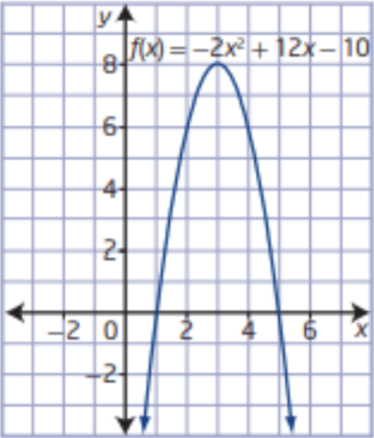
Since the values from the simplify the equation and the graph is x=1,5.
Thus the value of x=1,5.
Page 193 Problem 13 Answer
If a quadratic function is in the vertex form y=a(x−p)2+q , the vertex is (p,q).
Also at x=p,f(x) attain its maximum or minimum value.
Given quadratic function is y=−4x2+20x+37
=−4(x2+5x)+37
=−4(x2+5x+(5/2)2−(5/2)2)+37
=−4(x2+5x+(5/2)2)−(4)(5/2)2)+37
=−4(x+5/2)2+(4)(25/4)+37
=−4(x+5/2)2+62
Hence vertex is (p,q)=(−5/2,62). So the maximum value is attained at x=−5/2
The Maximum value for given quadratic function y=−4x2+20x+37 is 62.
The domain of y=−4x2+20x+37 is the possible values of x, which is −∞<x<∞,x∈R.
The range of y=−4x2+20x+37 is the possible y, which is −∞<x≤62,y∈R.
For the given y=−4x2 +20x+37, maximum value, domain and range of y are obtained.
Precalculus Textbook Mcgraw Hill Answers
Page 193 Problem 14 Answer
If the quadratic function is in vertex form y=a(x−p)2+q, then based on a, vertex (p,q) and the axis of symmetry x=p we can find maximum or minimum value , domain and range of f(x).
Given quadratic function is y=−4x2+20x+37 and its vertex form is y=−4(x+5/2)2+62, where a=−4, vertex is (p,q)=(−5/2,62).
Now since a<0 given quadratic function is open downwards, which attain maximum value only.
Also maximum value attain at axis of symmetry x=−5/2.
Domain is the possible value of x in f(x). Here no restriction for x in y=−4(x+5/2)2+62.So domain is −∞<x<∞,x∈R.
Range is the possible value of y . Here for any x value , maximum value of y is 62.
Hence the range of y is −∞<x≤62,y∈R
Strategies to find out maximum or minimum value, domain and range of y=−4x2+20x+37 are mentioned.
Page 193 Problem 15 Answer
If a quadratic function is in the vertex form y=a(x−p)2+q , the vertex is (p,q).
Given quadratic function is y=12x2−78x+126
=12(x2−78/12x)+126
=12(x2−13/2x)+126
=12(x2−13/2x+(13/4)2−(13/4)2)+126
=12(x2−13/2x+(13/4)2)−(12)(13/4)2+126
=12(x−13/4)2−507/4+126
=12(x−13/4)2−3/4
Hence vertex is (p,q)=(13/4,3/4)
For the given quadratic function y=12x2−78x+126 the vertex is (13/4,−3/4).
Precalculus Textbook Mcgraw Hill Answers
Page 194 Problem 16 Answer
If the coefficient of x2 is 1, no need to take that coefficient outside.
Make sure that symbols in between the terms are correct in all the steps.
Also we have to take the half of the coefficient of x carefully.
In the second line of given equations, 8x is wrongly write as 4x.
Also we have to add and subtract the square of half the coefficient of the x term.
Here 16 should be added not 4.
These are the mistakes.
Now correct vertex form is, V=x2+8x+30= (x2+8x+42−42)+30
= (x2+8x+16)−16+30
=(x+4)2+14
In the given conversion of vertex form for V=x2+8x+30,errors are identified and finally correct vertex form V=(x+4)2+14 is obtained.
Page 194 Problem 17 Answer
If the coefficient of is a, take that coefficient outside.
Make sure that symbols in between the terms in each step.
Take the half of the coefficient of x carefully.
We have add and subtract square of half of the coefficient x.
But in the second line of given equations, instead of (9/4)2=5.0625 they added 20.25.
Also in the last line coefficient of (x−4.5)2 is 2, which is disappeared.
These are the errors.
And the correct vertex form is f(x)=2x2−9x−55
=2(x2−9/2x)−55
=2[x2−9/2x+(9/4)2−(9/4)2]−55
=2[x2−9/2x+(9/4)2]−(2)(81/16)−55
=2[x−(9/4)]2−521/8
=2[x−2.25]2−65.125
Conversion of vertex form of 2x2−9x−55, errors are identified and finally correct vertex form is obtained.
and the correct quadratic equation is f(x)= 2(x−2.25)2−65.125
Precalculus Textbook Mcgraw Hill Answers
Page 194 Problem 18 Answer
Given Equations:

We have to Identify, explain, and correct the error(s) in the following examples of completing the square.
There is an error in the third line of the solution. You need to add and subtract the square of half the coefficient of the x−term.
The Correct solution is:
y=8x2+16x−13
y=8[x2+2x]−13
y=8[x2+2x+1−1]−13
y=8[(x2+2x+1)−1]−13
y=[(x+1)2−1}−13
y=8(x+1)2−8−13
y=8(x+1)2−21
Hence, There is an error in the third line of the solution.
You need to add and subtract the square of half the coefficient of the x−term.
The correct quadratic equation is: y=8(x+1)2−21 respectively.
Page 194 Problem 19 Answer
Given Equations:
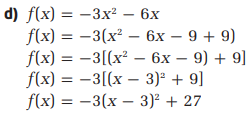
We have to Identify, explain, and correct the error(s) in the following examples of completing the square.
There are two errors in the second line of the solution.
You need to factor the leading coefficient from the first two terms and add and subtract the square of half the coefficient of the x−term.
There is also an error in the last line.
The −3 factor was not distributed correctly.
The Correct solution is:
f(x)=−3x2−6x
f(x)=−3[x2+2x+1−1]
f(x)=−3[(x2+2x+1)−1]
f(x)=−3[(x+1)2−1]
f(x)=−3(x+1)2+3
Hence, There are two errors in the second line of the solution.
You need to factor the leading coefficient from the first two terms and add and subtract the square of half the coefficient of the x−term.
There is also an error in the last line.
The −3 factor was not distributed correctly.
The correct quadratic equation is: f(x)=−3(x+1)2+3 respectively.
Precalculus Textbook Mcgraw Hill Answers
Page 194 Problem 20 Answer
Given quadratic function is y=−6x2+72x−20.
We need to identify, explain and correct any errors in the solutions of Austin and Yuri.
Convert the given quadratic function into vertex form by completing the square.
Austin made a mistake in writing the remaining factors after taking−6 as common factor from first two terms of the given function.
He has written+12x, it should be−12x.
Also he forgotten to square the quantity(x+6) in the last step.
The correct answer should bey=−6(x−6)2+196.
Yuri has written−216 after multiplying−6 by−36. It should be 216 to get the correct answer.
The correct answer should bey=−6(x−6)2+196.
The correct way of getting vertex form of given quadratic function is,
y=−6×2+72x−20
⇒y=−6(x2−12x)−20
⇒y=−6(x2−12x+36−36)−20
⇒y=−6((x−6)2−36)−20
⇒y=−6(x−6)2+216−20
⇒y=−6(x−6)2+196
The correct vertex form is y=−6(x−6)2+196.
Page 194 Problem 21 Answer
Given quadratic function is y=−6x2+72x−20.
Austin’s solution is y=−6(x+6)+196 and Yuri’s solution is y=−6(x−6)2+236.
We need to show several methods that they could have used to verify their solutions.
To verify the answers, either work backward from obtained vertex form to show the functions are equivalent or use graphing utility to show the graphs of both the functions are identical.
If their solution is incorrect, then working backward gives different function other than given function.
If their solution is incorrect, then the graphs of given function and obtained function in vertex form are not identical.
To verify the answers, either work backward from obtained vertex form to show the functions are equivalent or use graphing utility to show the graphs of both the functions are identical.
Page 195 Problem 22 Answer
Given that a particular parabolic microphone has a cross-sectional shape that can be described by the function d(x)=0.03125x2−1.5x, whered is the depth, in centimeters, of the microphone’s dish at a horizontal distance of x centimeters from one edge of the dish.
We need to use an algebraic method to determine the depth of the dish, in centimeters, at its center.
For this, find the vertex by completing the square and then substitute the x-coordinate of the vertex in the given equation.
Consider the given equation,
d(x)=0.03125x2−1.5x
⇒d(x)=0.03125(x2−48x)
⇒d(x)=0.03125(x2−48x+576−576)
⇒d(x)=0.03125((x−24)2−576)
⇒d(x)=0.03125(x−24)2−18
Now comparing with d(x)=a(x−p)2+q, we get a=0.03125,p=24 and q=−18.
Therefore vertex is(p,q)=(24,−18).
Now putx=24
ind(x)=0.03125x2−1.5x, we get
d(24)=0.03125(24)2−1.5(24)
=18−36
=−18
But the distance cannot be negative. Therefore,
The depth of the dish is 18 centimeters at its center.
The depth of the dish is 18 centimeters at its center.
Precalculus Textbook Mcgraw Hill Answers
Page 195 Problem 23 Answer
Given that a concert promoter is planning the ticket price for an upcoming concert for a certain band.
At the last concert, she charged $70 per ticket and sold 2000 tickets.
After conducting a survey, the promoter has determined that for every $1 decrease in the ticket price, she might expect to sell 50 more tickets.
We need to the maximum revenue that the promoter can expect and the ticket price will give that revenue.
For this, first find revenue function and then convert it into vertex form.
Letx be the number of price decreases. Then the new price is70−x and the number of tickets sold is2000+50x.
Now the revenue is,
R=price×quantity
⇒R(x)=(70−x)(2000+50x)
⇒R(x)=140000+3500x−2000x−50x2
⇒R(x)=−50x2+1500x+140000
Now by completing the square, we get
⇒R(x)=−50(x2−30x)+140000
⇒R(x)=−50(x2−30x+225−225)+140000
⇒R(x)=−50((x−15)2−225)+140000
⇒R(x)=−50(x−15)2+11250+140000
⇒R(x)=−50(x−15)+151250
Now comparing with R(x)=a(x−p)2+q, we get
p=15 and q=151250
Hence maximum revenue is$151250 and the ticket price is$70−$15=$55.
Maximum revenue is $151250 when the ticket price is $55.
Page 195 Problem 24 Answer
Given that a concert promoter is planning the ticket price for an upcoming concert for a certain band.
At the last concert, she charged$70 per ticket and sold 2000 tickets.
After conducting a survey, the promoter has determined that for every $1 decrease in the ticket price, she might expect to sell 50 more tickets.
We need to find the number of tickets that the promoter expect to sell at the price of $55.
For this, substitute x=15 in the equation representing the number of tickets sold.
Let x be the number of price decreases. Then the new price is70−x and the number of tickets sold is 2000+50x.
Now putx=15 in2000+50x, we get
2000+50(15)=2000+750=2750
Hence the promoter can expect to sell 2750 tickets.
Page 195 Problem 25 Answer
Given that a concert promoter is planning the ticket price for an upcoming concert for a certain band.
At the last concert, she charged$70 per ticket and sold 2000 tickets.
After conducting a survey, the promoter has determined that for every $1 decrease in the ticket price, she might expect to sell 50 more tickets.
We need to Explain any assumptions the concert the promoter is making in using this quadratic function to predict revenues.
The promoter can assume that the decrease in ticket prices determines the same increase in ticket sales as indicated by the survey.
The revenue may increase as the ticket price decreases.
The decrease in ticket prices determines the same increase in ticket sales as indicated by the survey.
McGraw Hill Pre Calculus 11 Student Edition Chapter 3 Exercise 3.2 Quadratic Functions
Pre-Calculus 11 Student Edition Chapter 3 Quadratic Functions
Page 164 Problem 1 Answer
The three possible paths for football will look like

The three possible paths for football will look like
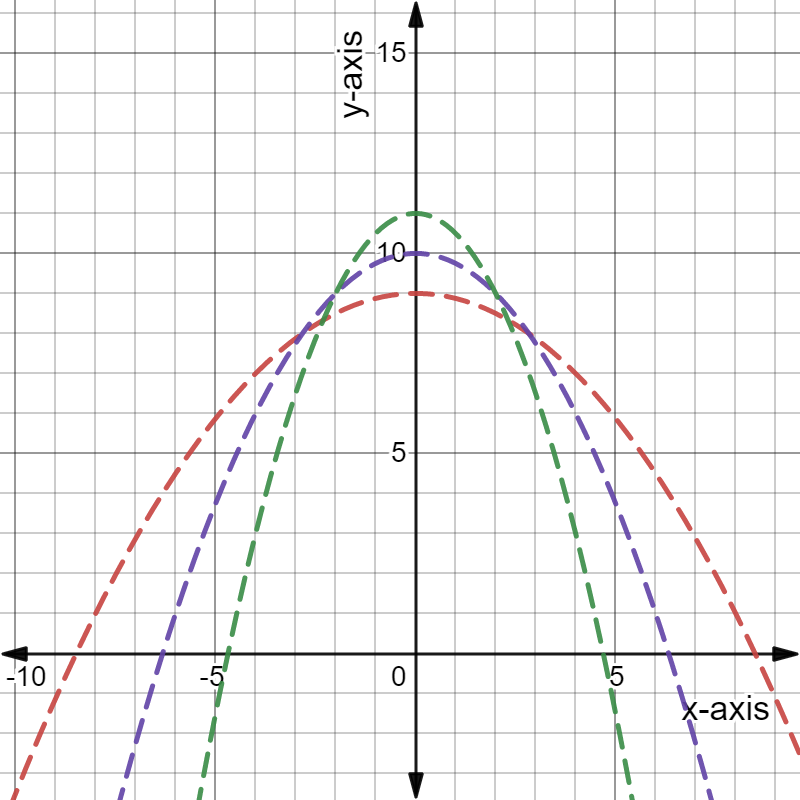
Page 164 Problem 2 Answer
The path of football goes up, creates an downward U shape and come back.
The distance and shape of path covered before and after the maximum height remains same for the football.
The shape of the path covered by football is known as a parabola.
The path of a projectile under the influence of gravity follows a curve of this shape.
The shape created by path of football is a parabola.
Read and Learn More Precalculus Textbook Mcgraw Hill Answers
Page 164 Problem 3 Answer
The maximum and minimum height is the value on y-axis, where x=0
Hence, the height of graph is the constant term c in equation y=ax2+bx+c
The maximum or minimum height is the distance covered on y-axis where x=0
Hence, the height is the constant term c of equation y=ax2+bx+c
Page 168 Problem 4 Answer
The given quadratic function is y=x2+6x+5.
Let, f(x)=x2+6x+5.
Here, the coefficient of x2 is positive.
So, the parabola is open upward.
From the given function, a=1,b=6,c=5.
Therefore, the x-coordinate of the vertex is 6/2=3.
Substitute x=3 in f(x).
f(x)=x2+6x+5
f(3)=32+6(3)+5
f(3)=9+18+5
f(3)=32
Therefore, the co-ordinate of the vertex is (3,32).
The minimum value is the y-coordinate of the vertex.
Therefore, the minimum value is -4.
The equation of the axis of symmetry is x=−b/2a.
Therefore, the axis of symmetry is x=−3.
Substitute x=0 in y=x2+6x+5 yields y=5.
Substitute y=0 in y=x2+6x+5.
x2+6x+5=0
x2+x+5x+5=0
(x+5)(x+1)=0
Therefore x-intercepts are x=−5,−1.
Domain: All real numbers.
Range: 7⩽y⩽∞.
The required properties of the quadratic functions are,
The parabola is open upward.
Therefore, the co-ordinate of the vertex is (3,32).
Therefore, the minimum value is -4.
Therefore, the axis of symmetry is x=−3.
Therefore x-intercepts are x=−5,−1.
Domain: All real numbers.
Range: 7⩽y⩽∞.
Mcgraw-Hill Textbook Answers
Page 168 Problem 5 Answer
The given quadratic function is y=−x2+2x+3.
Let f(x)=−x2+2x+3
Here, the coefficient of x2 is negative.
So, the parabola is open downward.
From the given function, a=−1,b=2,c=3.
Therefore, the x-coordinate of the vertex is −2/−2=1.
Substitute x=1 in f(x).
f(x)=−x2+2x+3
f(1)=−(1)2+2(1)+3
f(1)=−1+2+3
f(1)=4
Therefore, the co-ordinate of the vertex is (1,4)
The maximum value is the y-coordinate of the vertex.
Therefore, the maximum value is 4.
The equation of the axis of symmetry is x=−b/2a
Therefore, the axis of symmetry is x=1
Substitute x=0 in y=−x2+2x+3 yields y=3.
Substitute y=0 in y=−x2+2x+3.
−x2+2x+3=0
x2−2x−3=0
x2−3x+x−3=0
(x−3)(x+1)=0
x=3,−1.
Therefore x-intercepts are x=3,−1
Domain: All real numbers.
Range: −∞⩽y⩽4
Mcgraw-Hill Textbook Answers
The required properties of the quadratic functions are,
The parabola is open downward.
The co-ordinate of the vertex is (1,4).
The maximum value is 4.
The axis of symmetry is x=1.
Therefore x-intercepts are x=3,−1.
Domain: All real numbers.
Range: −∞⩽y⩽4
Page 172 Problem 6 Answer
Given: There is 160 m of rope available to create the perimeter.
To write a quadratic function in standard form to represent the area for the stroller parking.
Simply do some algebraic operations.
The perimeter is 160 m.
P=2(L+W)
160=2(L+W)
80=L+W
W=80−L
The required area is:
A=L⋅W
A=L(80−L)
A=80L−L2
Hence, the required quadratic equation is A=−L2+80L.
Mcgraw-Hill Textbook Answers
Page 172 Problem 7 Answer
Given: There is a 160 m of rope available to create the perimeter.
What are the coordinates of the vertex? What does the vertex represent in this?
Simply use a graphing utility to graph the function.
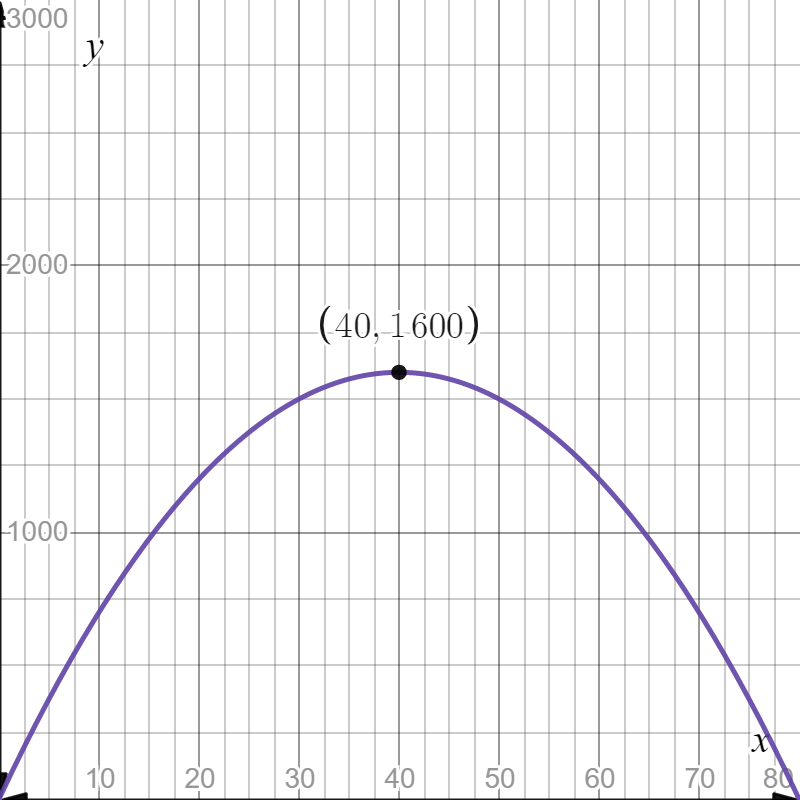
The required quadratic function is A=−L2+80L.
The required vertex is (40,1600).
The vertex means the maximum area of 1600m2 occurs when the length is 40 m.
Hence, the required coordinate of the vertex is (40,1600) and the vertex means that the maximum area is 1600m2 occurs when the length is 40 m.
The required graph is:
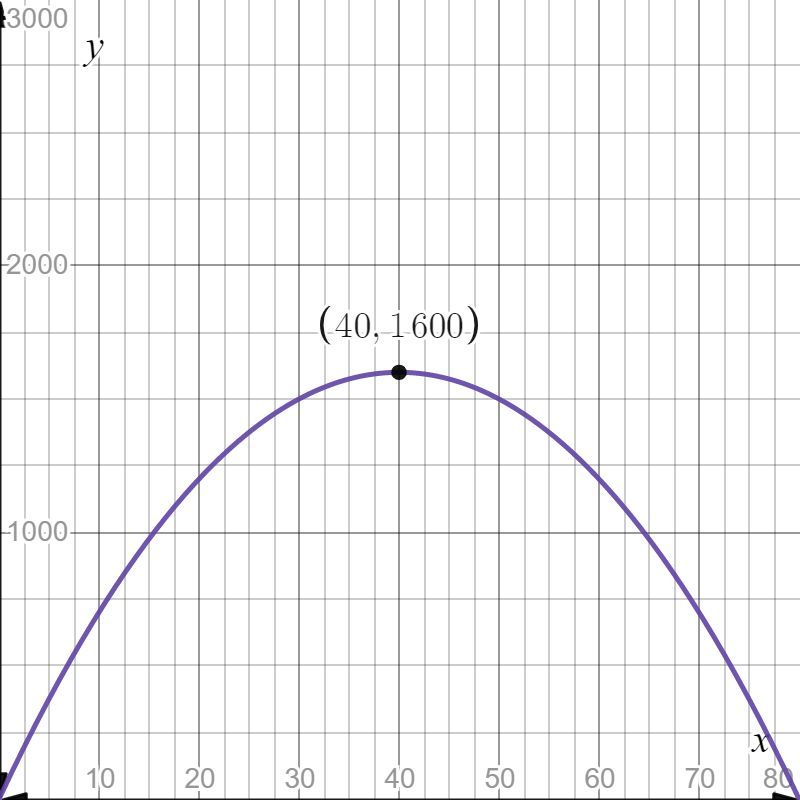
Page 172 Problem 8 Answer
To sketch the graph for the function in part (a).
The required quadratic equation is A=−L2+80L.
Simply use a graphing calculator to sketch the graph.
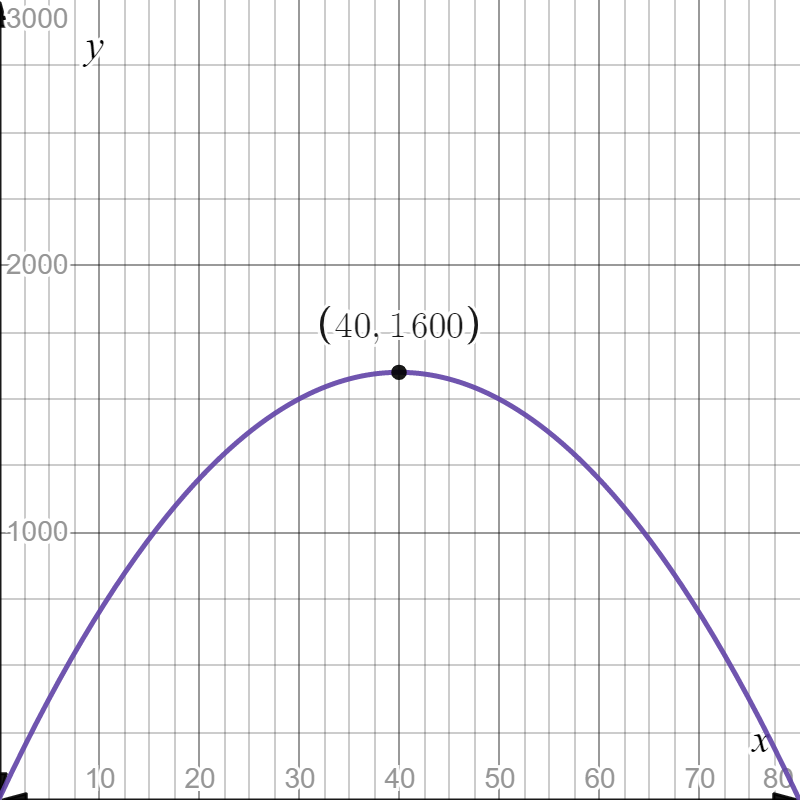
The required graph of the quadratic equation A=−L2+80L is:
Hence, the required sketch is:

Page 172 Problem 9 Answer
To determine the domain and range for this situation.
The quadratic equation is A=−L2+80L.
To sketch the graph of the quadratic equation.
The required sketch is:

The required domain is 0<L<80 and the required range is 0<A≤1600.
Hence, the required domain is 0<L<80 and the required range is 0<A≤1600.
Page 172 Problem 10 Answer
The quadratic function written in part a) A=−L2+80L
The equation is written by assuming that perimeter of rectangle is 160m that means the organizers will use all of the rope to make the stroller parking.
L+W=80
Mcgraw Hill Precalculus Textbook Answers
Length and width cannot be negative.
So, it also assumes that any width or length from 0 m to 80 m is possible.
In reality, there may be other limitations on the dimensions of the stroller parking, such as the available area and landscape of the location of children’s music festival.
The quadratic function written in part a) assumes that the organizers will use all of the rope to make the stroller parking.
It also assumes that any width or length from 0 m to 80 m is possible.
In reality, there may be other limitations on the dimensions of the stroller parking, such as the available area and landscape of the location of children’s music festival.
Page 174 Problem 11 Answer
a)f(x)=2×2+3x
This is a polynomial with degree 2
So, function a)f(x)=2x2+3x is a quadratic function.
d)f(x)=(2x−5)(3x−2)
f(x)=6x2−15x−4x+10
f(x)=6x2−19x+10
This is a polynomial with degree 2
So, function d)f(x)=(2x−5)(3x−2) is a quadratic function.
b)f(x)=5−3x
This is a polynomial with degree1
So, function b)f(x)=5−3x is not a quadratic function.
c)f(x)=x(x+2)(4x−1)
f(x)=x(4x2+8x−x−2)
f(x)=x(4x2+7x−2)
f(x)=4x3+7x2−2x
This is a polynomial with degree 3
So, function c)f(x)=x(x+2)(4x−1) is a quadratic function.
The following functions are quadratic:
a)f(x)=2x2+3x
d)f(x)=(2x−5)(3x−2)
Page 174 Problem 12 Answer
Given:
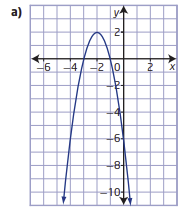
To find:
the coordinates of the vertex
the equation of the axis of symmetry
the x-intercepts and y-intercept
the maximum or minimum value and how it is related to the direction of opening
the domain and range
Graph:
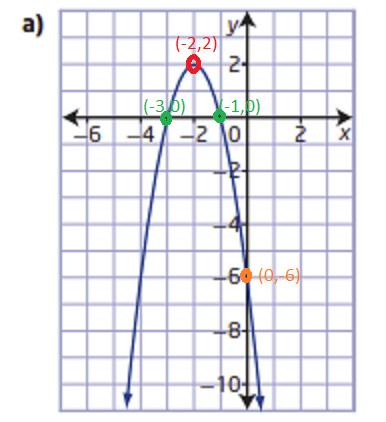
The coordinates of the vertex:
(h,k)=(−2,2)
The equation of the axis of symmetry
x=h
x=−2
The x-intercepts The graph intersects x−axis at (−3,0),(−1,0)
The y-intercepts The graph intersects y−axis at (0,−6) the maximum or minimum value and how it is related to the direction of opening
Opens downward: Maximum value at vertex
Maximum value of y=2 at x=−2
The domain : All real numbers, or {x∣x∈R}
The Range: All real numbers less than or equal to 2, or {y∣y≤2,y∈R}
The coordinates of the vertex: (−2,2)
The equation of the axis of symmetry: x=−2
The x-intercepts occur at (−3,0),(−1,0) and have values of −3 and −1
The y-intercept occurs at (0,−6) and has value of −6
The maximum value of y=2 at x=−2
The domain: All real numbers, or {x∣x∈R}
The Range: All real numbers less than or equal to 2, or {y∣y≤2,y∈R}
Mcgraw Hill Precalculus Textbook Answers
Page 174 Problem 13 Answer
Given: graph
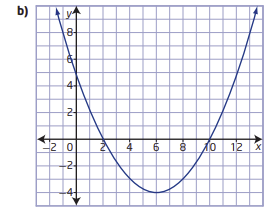
To find:
the coordinates of the vertex
the equation of the axis of symmetry
the x-intercepts and y-intercept
the maximum or minimum value and how it is related to the direction of opening
the domain and range
Graph

The coordinates of the vertex:(h,k)=(6,−4)
The equation of the axis of symmetry
x=h
x=6
The x-intercepts
The graph intersects x−axis at (2,0),(10,0)
The y-intercepts The graph intersects y−axis at (0,5)
the maximum or minimum value and how it is related to the direction of opening
Opens upward: Minimum value at vertex Minimum value of y=−4 at x=6
The domain : All real numbers, or {x∣x∈R}
The Range: All real numbers greater than or equal to −4, or {y∣y≥−4,y∈R}
The coordinates of the vertex: (6,−4)
The equation of the axis of symmetry:x=6
The x-intercepts occur at (2,0),(10,0) and have values of 2 and 10
The y-intercept occurs at (0,5) and has value of 5
The minimum value of y=−4 at x=6
The domain: All real numbers, or {x∣x∈R}
The Range: All real numbers greater than or equal to −4, or {y∣y≥−4,y∈R}
Mcgraw Hill Precalculus Textbook Answers
Page 174 Problem 14 Answer
Given: graph
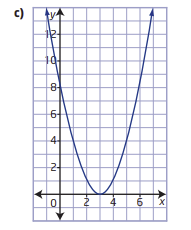
To find:
the coordinates of the vertex
the equation of the axis of symmetry
the x-intercepts and y-intercept
the maximum or minimum value and how it is related to the direction of opening
the domain and range
Graph

The coordinates of the vertex:(h,k)=(3,0)
The equation of the axis of symmetryx=h x=3
The x-intercepts The graph intersects x−axis at (3,0)
The y-intercepts The graph intersects y−axis at (0,8)
the maximum or minimum value and how it is related to the direction of opening
Opens upward: Minimum value at vertex
Minimum value of y=0 at x=3
The domain : All real numbers, or {x∣x∈R}
The Range: All real numbers greater than or equal to 0, or {y∣y≥0,y∈R}
The coordinates of the vertex:(3,0)
The equation of the axis of symmetry: x=3
The x-intercept occurs at(3,0)and has value of3
The y-intercept occurs at (0,8) and has value of 8
The minimum value ofy=0 at x=3
The domain: All real numbers, or {x∣x∈R}
The Range: All real numbers greater than or equal to 0, or {y∣y≥0,y∈R}
Page 174 Problem 15 Answer
Given: f(x)=5x(10−2x)
To show: Each function fits the definition of a quadratic function by writing it in standard form
f(x)=5x(10−2x)
f(x)=50x−10x2 : Distribute
f(x)=−10x2+50x+0 : Rearrange
The equation is in standard quadratic form which is a polynomial with degree two.
As such, the function fits the definition of a quadratic function.
In standard form, f(x)=−10x2+50x
The function is given by a polynomial of degree two.
Hence, the function fits the definition of a quadratic function.
Mcgraw Hill Precalculus Textbook Answers
Page 174 Problem 16 Answer
Given: f(x)=(10−3x)(4−5x)
To write: the quadratic function in the standard form.
(10−3x)(4−5x)
=10⋅4+10(−5x)−3x⋅4−3x(−5x)
=40−50x−12x−15x2
=15x2−62x+40
Complete the square:
15(x2−62x/15+8/3)
=15(x2−62x/15+8/3+(−31/15)2−(−31/15)2)
=15((x−31/15)2+8/3−(−31/15)2)
=15(x−31/15)2−361/15
The standard quadratic form is 15(x−31/15)2−361/15
Page 174 Problem 17 Answer
Given: y=3x2+7x−6
To find: with the help of the graph the vertex, the axis of symmetry, the direction of opening, the maximum or minimum value, the domain and range, and any intercepts
Draw the graph:
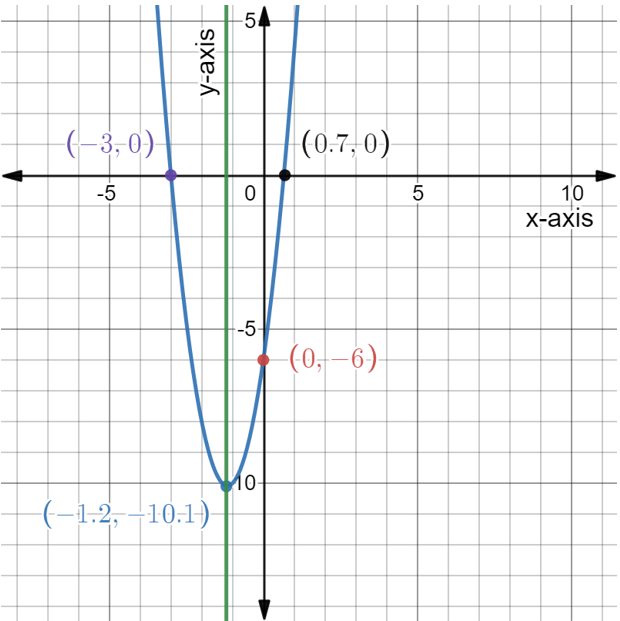
vertex-(−1.2,−10.1) the axis of symmetry-x=−1.2
the direction of opening-concave upwards the maximum- Not defined
The minimum value-−10.1 the domain-All real numbers
The range-[−10.1,∞)
x− intercept-−3,0.7
y−intercept-−6
vertex-(−1.2,−10.1)
the axis of symmetry-x=−1.2
the direction of opening-concave upwards the maximum- −10.1
The minimum value-not defined the domain-all real numbersThe range-[−10.1,∞)
Mcgraw Hill Precalculus Textbook Answers
Page 174 Problem 18 Answer
The given equation is y=−2x2+5x+3.
To graph the given equation using graphing utility and then find the vertex, the axis of symmetry, the direction of opening, the maximum or minimum value, the domain and range, and any intercepts.
By using the graphing utility, the graph of the given function is shown below:

The parabola crosses the yaxis at point (0,3) and crosses the x axis at point (−0.5 , 0) and (3 , 0).
Compare the given quadratic equation general quadratic equation, we get
a=−2, b=5 and c=3
Here, a is negative, so the parabola has a maximum.
The maximum value of parabola is 6.125≈6.1
From the above graph, it is observed that the parabola open downwards.
The domain of the quadratic function is any real number.
The domain of the given function is (−∞, ∞).
The parabola has a maximum, so the range of the given function is (−∞,6.1].
The axis of symmetry is x=1.3.
The graph is shown below:
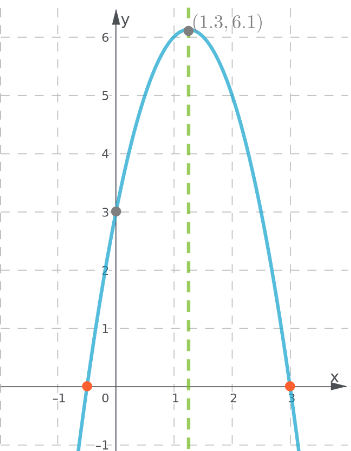
The vertex of y=−2x2+5x+3 is (1.3,6.1), the axis of symmetry is x=1.3, the graph opens downward, maximum value is 6.1, domain is −∞<x<∞, range is −∞<y≤6.1,x intercepts are at (−0.5,0) and (3,0),y-intercept is at (0,3).
Page 174 Problem 19 Answer
The given equation is y=50x−4x2.
To graph the given equation using graphing utility and then find the vertex, the axis of symmetry, the direction of opening, the maximum or minimum value, the domain and range, and any intercepts.
By using the graphing utility, the graph of the given function is shown below:
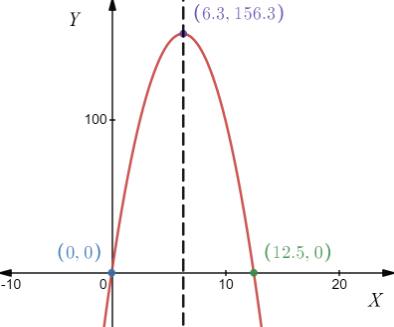
The parabola crosses the yaxis at point (0,0) and crosses the x axis at point (0 , 0) and (12.5 , 0).
Compare the given quadratic equation general quadratic equation, we get
a=−4, b=50 and c=0
Here, a is negative, so the parabola has a maximum.
The maximum value of parabola is ≈156.3
From the above graph, it is observed that the parabola open downwards.
The domain of the quadratic function is any real number.
Mcgraw Hill Precalculus Textbook Answers
The domain of the given function is (−∞, ∞).
The parabola has a maximum, so the range of the given function is (−∞,156.3].
The axis of symmetry is x≈6.3.
The graph is shown below:
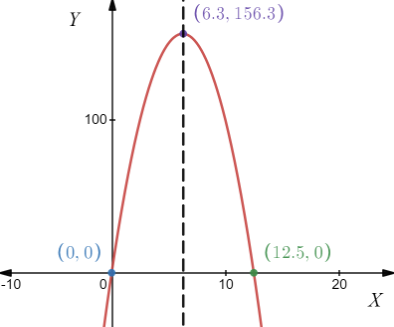
The vertex of y=50x−4x2 is (6.3,156.3), the axis of symmetry is x=6.3, the graph opens downward, maximum value is 156.3, domain is −∞<x<∞, range is −∞<y≤156.3,x intercepts are at (0,0) and (12.5,0),y-intercept is at (0,0).
Page 174 Problem 20 Answer
The given equation is y=1.2x2+7.7x+24.3.
To graph the given equation using graphing utility and then find the vertex, the axis of symmetry, the direction of opening, the maximum or minimum value, the domain and range, and any intercepts.
The parabola crosses the yaxis at point (0,24.3) and doesn’t cross the x axis.
Compare the given quadratic equation general quadratic equation, we get
a=1.2, b=7.7 and c=24.3
Here, a is positive, so the parabola has a minimum.
The minimum value of parabola is ≈12.0
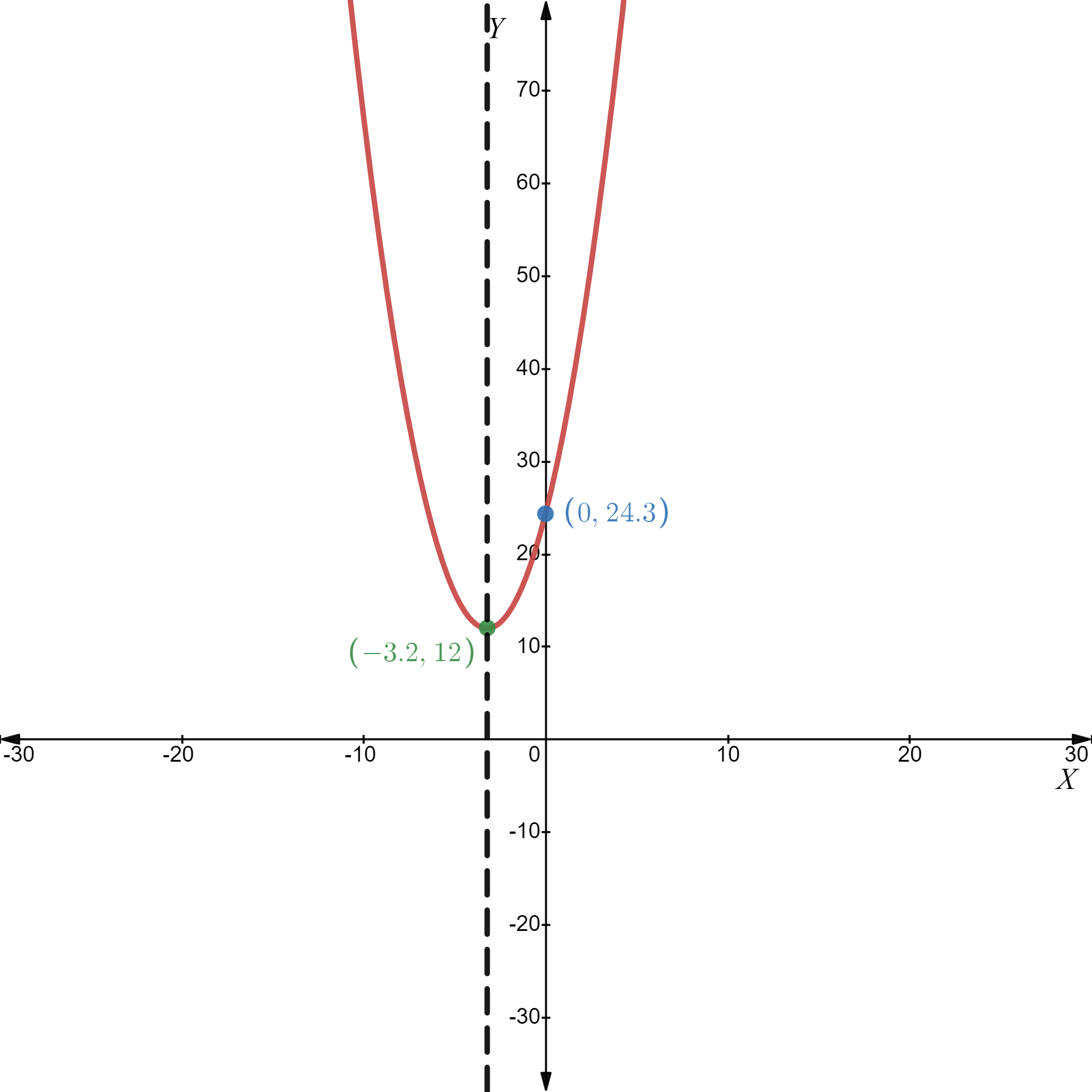
From the above graph, it is observed that the parabola opens upwards.
The domain of the quadratic function is any real number.
The domain of the given function is (−∞, ∞).
The parabola has a maximum, so the range of the given function is [12.0,∞).
The axis of symmetry is x≈−3.2.
By using the graphing utility, the graph of the given function is shown below:
The vertex of y=1.2x2+7.7x+24.3 is (−3.2,12), the axis of symmetry is x=−3.2, the graph opens upward, minimum value is 12, domain is −∞<x<∞, range is 12≤y≤∞, no x-intercepts and y-intercept is at (0,24.3).
The graph is shown below:
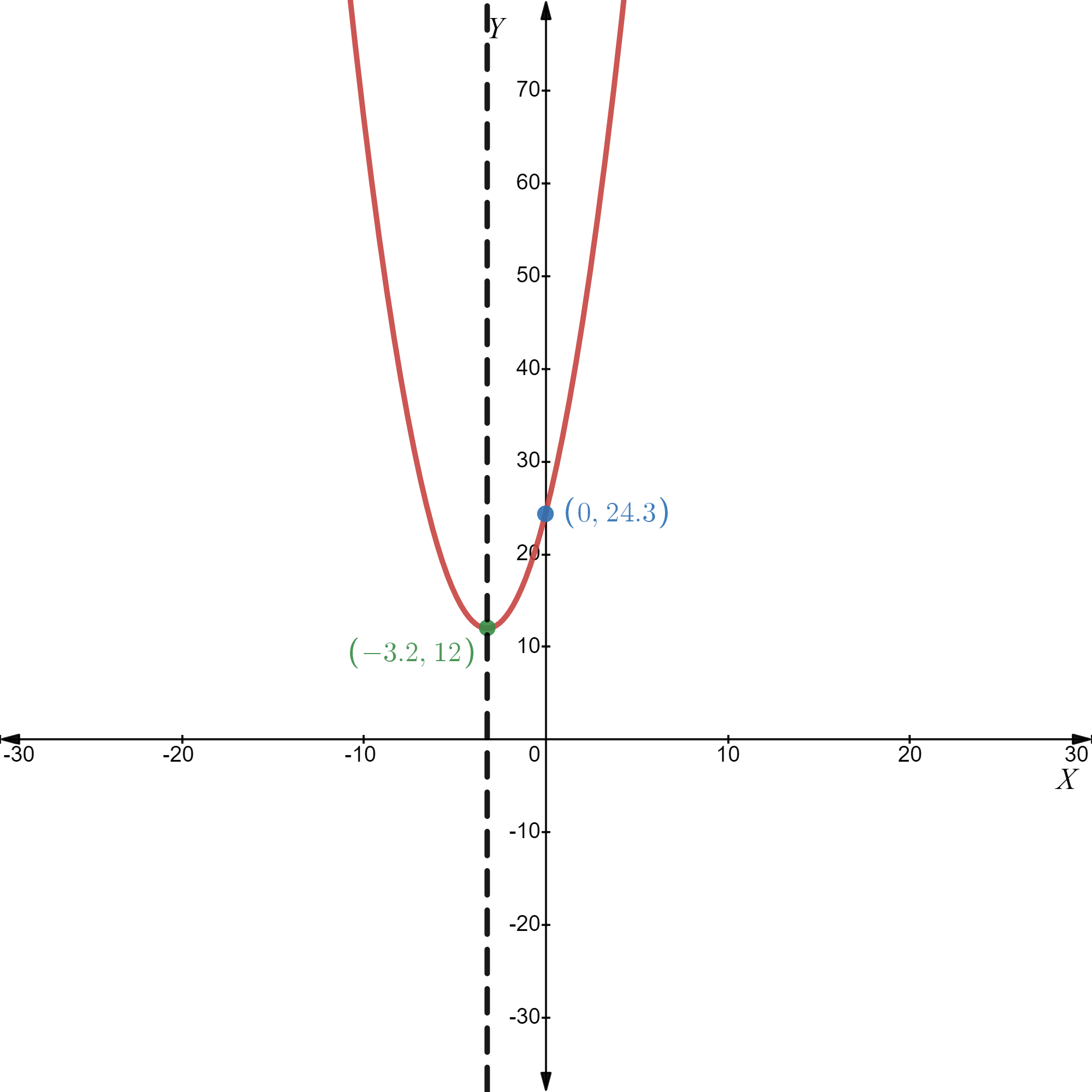
McGraw Hill Pre Calculus 11 Student Edition Chapter 3 Exercise 3.1 Quadratic Functions
Pre-Calculus 11 Student Edition Chapter 3 Quadratic Functions
Page 143 Problem 1 Answer
Quadratic function are of the form f(x)=ax2+bx+c
OR f(x)=(a−h)2+k,a≠0.
Form own function by substituting several values of parameter a in the function f(x)=ax2
Given quadratic function is f(x)=ax2.
Mcgraw Hill Precalculus Textbook Answers
Substitute the any values of a, we get several function and they are
f(x)=3x2,a=3
f(x)=3/2
x2,a=3/2
f(x)=10x2,a=10
f(x)=5x2,a=5
f(x)=1/5x2,a=1/5
f(x)=4x2,a=4
f(x)=−3x2,a=−3
f(x)=−3/2x2,a=−3/2
f(x)=−10x2,a=10
f(x)=−5x2,a=−5
f(x)=−1/5x2,a=−1/5
f(x)=−4x2,a=−4
own function of the form f(x)=ax2 are
f(x)=3x2
f(x)=3/2x2
f(x)=10x2
f(x)=5x2
f(x)=1/5x2
f(x)=4x2
f(x)=−3x2
f(x)=−3/2x2
f(x)=−10x2
f(x)=−5x2
f(x)=−1/5x2
f(x)=−4x2
Read and Learn More Precalculus Textbook Mcgraw Hill Answers
Page 143 Problem 2 Answer
The quadratic function is of the form f(x)=ax2+bx+c
OR f(x)=a(x−h)2+k,a≠0
If a is close to 0 , the graph opens wider
If a is farther from 0, the graph opens narrower.
If a>0, the graph points up
If a<0, the graph points down
The following quadratic function opens up as the parameter a>0
f(x)=3x2
f(x)=3/2x2
f(x)=10x2
f(x)=5x2
f(x)=1/5x2
f(x)=4x2
The following quadratic functions opens down
f(x)=−3x2
f(x)=−3/2x2
f(x)=−10x2
f(x)=−5x2
f(x)=−1/5x2
f(x)=−4x2
Mcgraw Hill Precalculus Textbook Answers
The graph of the above function is shown below
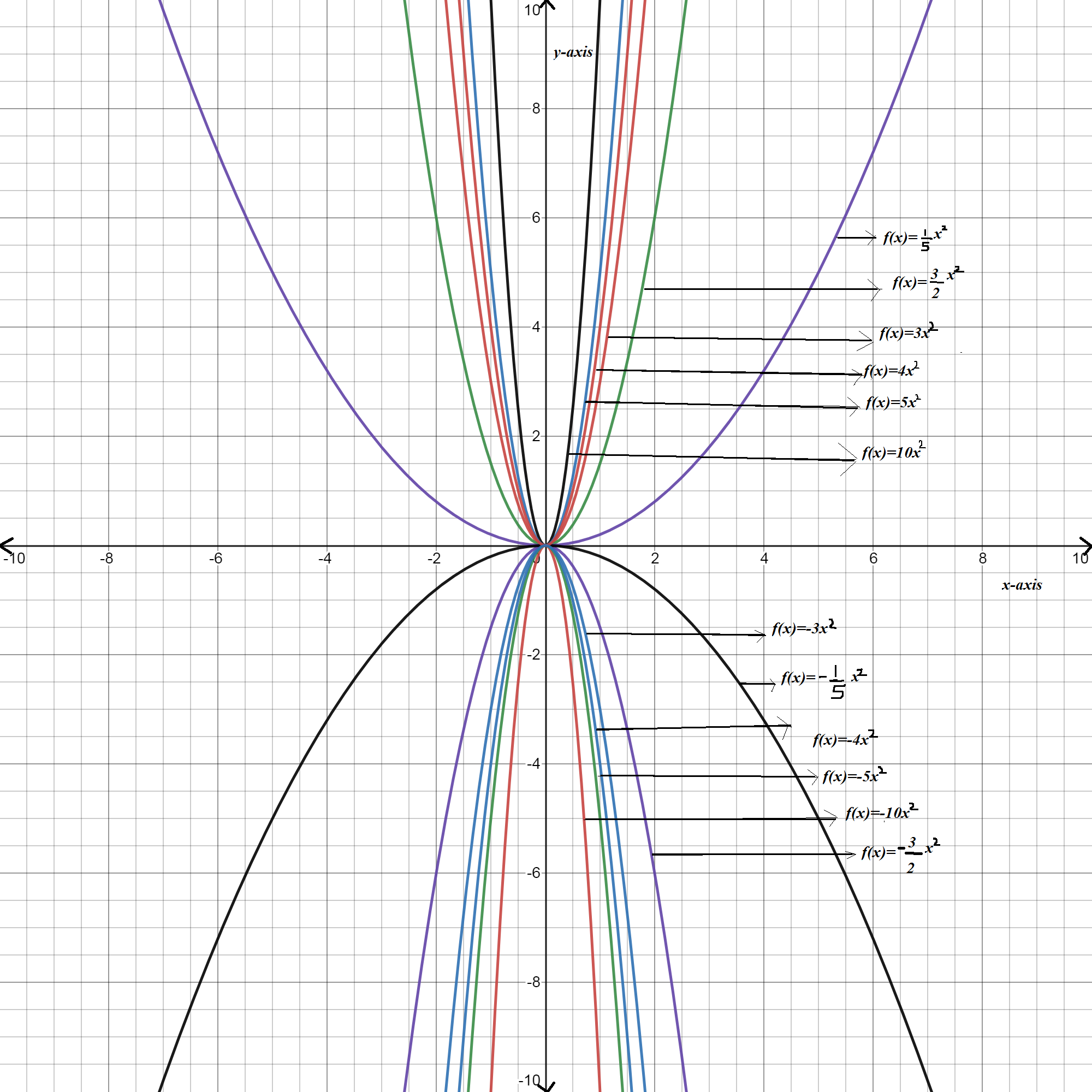
As the value of parameter a increases the curve becomes narrower and when it will be near to 0, curve becomes wider.
In the above graph , the function
f(x)=1/5x2,f(x)=−1/5x2 are wider
f(x)=10x2,f(x)=−10x2 are narrower.
As the value of parameter a increases the curve becomes narrower and when it will be near to 0, curve becomes wider.
In the above graph , the function
f(x)=1/5x2,f(x)=−1/5x2 are wider
f(x)=10x2,f(x)=−10x2 are narrower.
The function f(x)=1/5x2,f(x)=−1/5x2 are wider and the function f(x)=10x2,f(x)=−10x2 are narrower. other function lies in between them

Page 143 Problem 3 Answer
The quadratic function is of the form f(x)=ax2+bx+c OR f(x)=a(x−h)2+k,a≠0
If the parameter a is close to 0, the graph opens wider
If the parameter a is farther from 0, the graph opens narrower
If the parameter a>0, the graph opens up
If the parameter a<0, the graph opens down
The Quadratic function is f(x)=ax2
If a>1>0, the graph opens up.
Mcgraw Hill Precalculus Textbook Answers
As the parameter a is close to 1, the graph opens wider and a
is farther to 1, the graph becomes narrower.
The quadratic function f(x)=ax2 with parameter a>1 opens up.
when a is close to 1 , the graph opens wider
when a is farther to 1, the graph becomes narrower
Page 143 Problem 4 Answer
We need to find how the value of a in f(x)=ax2 changes the graph of f(x)=x2 when a is a positive number less than 1.
a is a positive number
a>0 no reflection about x-axis.
a is less than 1
a<1, graph is wider.
when a is a positive number less than 1,
Then f(x)=x2 gets wider with value of a goes from 1→0 to form graph of f(x)=ax2
Page 143 Problem 5 Answer
We need to find how the value of a in f(x)=ax2 changes the graph of f(x)=x2 when a is a negative number.
is a negative number
a<0 graph reflected about x-axis.
If a<−1, graph gets narrower.
If −1<a<0, graph gets wider.
when a is a negative number, Then f(x)=x2 gets reflected about x-axis to form graph of f(x)=ax2
If a<−1, graph gets narrower.
−1<a<0, graph gets wider.
Precalculus Textbook Mcgraw Hill Answers
Page 143 Problem 6 Answer
Given : f(x)=x2+q
By substituting q=0,2,3,4,−1.4,2,3
we can obtained the different forms of the function f(x)=x2+q.
q= 0 f(x) = x2
q= 2 f(x) = x2 + 2
q = 3 f(x) = x2 + 3
q = 4 f(x) = x2 + 4
q = −1.4 f(x) = x2 − 1.4
q = −2 f(x) = x2 − 2
q = −3
The different forms of the function are f(x)=x2,f(x)=x2+2,f(x)=x2+3,f(x)=x2+4,f(x)=x2−1.4,f(x)=x2−2,f(x)=x2−3
Page 143 Problem 7 Answer
We have to compare the function f(x)=x2+q with the function f(x)=x2 for different positive and negative values of q.
Use a graphing calculator and draw the graph of the given function for different values of q then compare with the graph of f(x)=x2.
The graph of the function f(x)=x2+q for different values of q and f(x)=x2 is drawn as
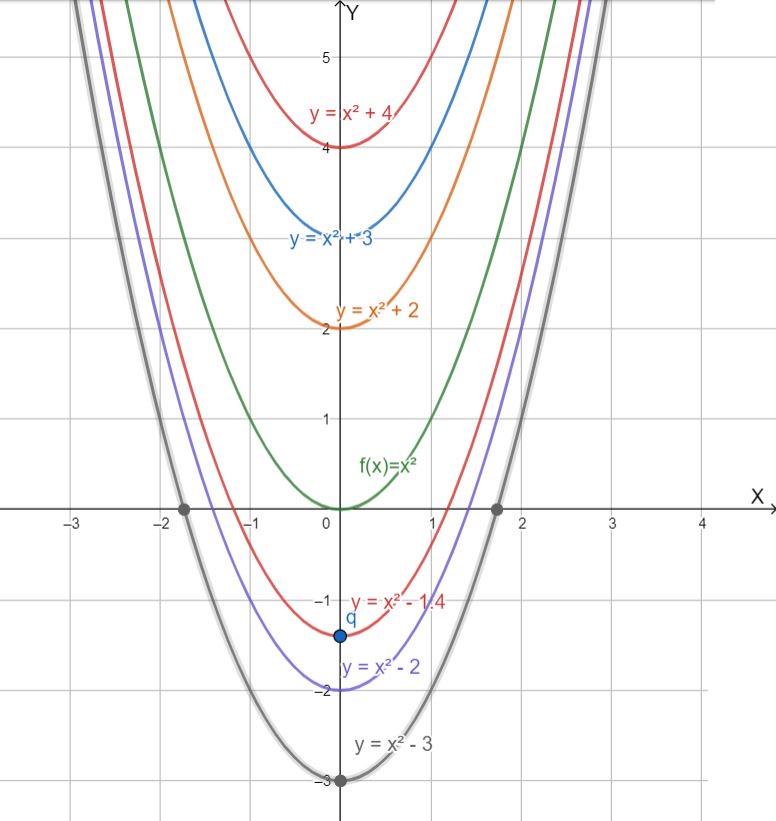
When we compare the graph of the function then we can observe that if the q is positive then the graph of f(x)=x2 translates q units upward along the y-axis and if the q is negative then the graph of f(x)=x2 translates q units downward along y-axis.
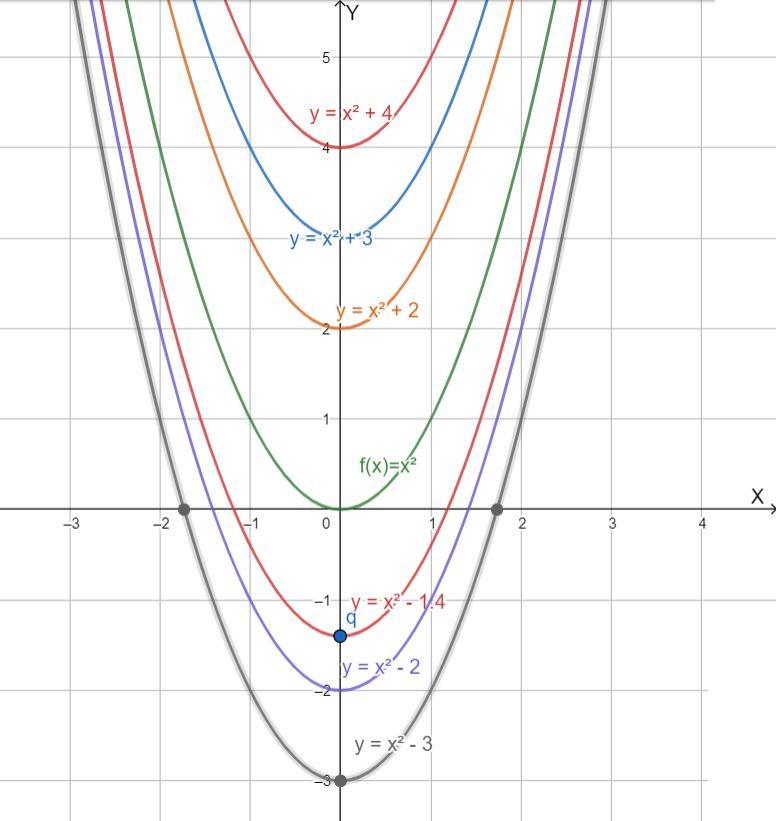
Page 150 Problem 8 Answer
Given: quadratic functiony=1/2(x−2)2−4
To determine: 1. Vertex
2.The domain and range
3.The direction of opening
4.The equation of the axis of symmetry
Use the values of a,p and q to determine these characteristics and sketch the graph.
We have the quadratic function y=1/2(x−2)2−4
Compare this function toy=a(x−p)2+q, we get
a=1/2,p=2 and q=−4
Vertex: Since p=2andq=−4, the vertex is located at(2,−4).
The domain and range: Since q=−4, the range is {y∣y≥−4,y∈R}and the domain is {x∣x∈R}.
The direction of opening: Since a>0, the graph opens upward.
The equation of the axis of symmetry: Since p=2, the equation of the axis of symmetry is x−2=0 or x=2.
Plot the coordinates of the vertex,(2,−4), and draw the axis of symmetry,x=2.
Determine the coordinates of one other point on the parabola.
For example, determine y−intercept by substitutingx=0 into the given function.
y=1/2(0−2)2−4
=1/2(4)−4
=2−4
=−2
The point(0,−2) is on the graph.
Precalculus Textbook Mcgraw Hill Answers
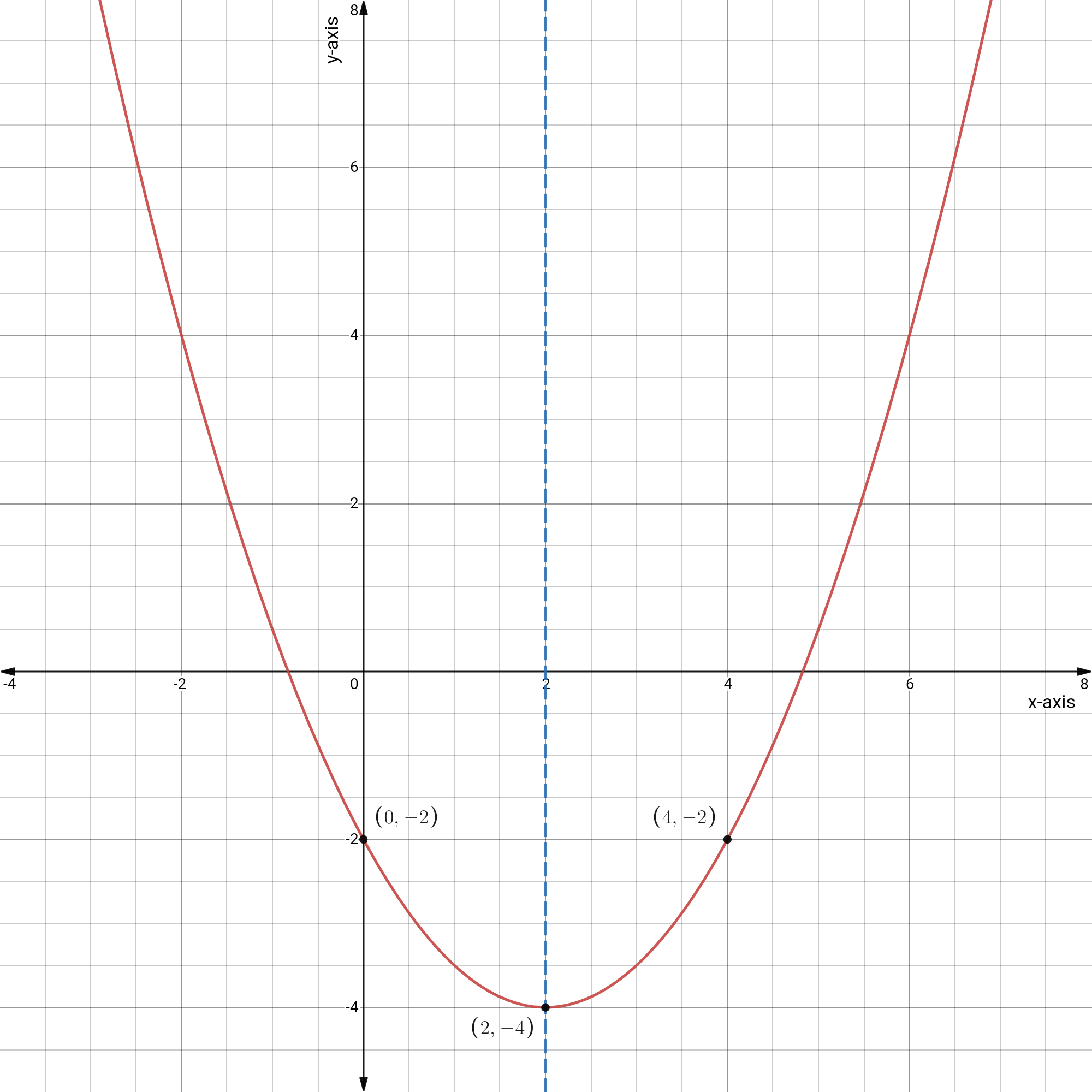
For any point other than the vertex, there is a corresponding point that is equidistant from the axis of symmetry.
In this case, the corresponding point of(0,−2) is(4,−2).
Plot this two additional points and complete the sketch of the parabola.
The graph of given function is:
1.Vertex:(2,−4)
2.The domain:{x∣x∈R} and range:{y≥−4∣y∈R}
3.The direction of opening: Upward
4.The equation of the axis of symmetry: x=2
The graph of a function:
Precalculus Textbook Mcgraw Hill Answers

Page 150 Problem 9 Answer
Given: quadratic functiony=−3(x+1)2+3
To determine: 1. Vertex
2.The domain and range
3.The direction of opening
4.The equation of the axis of symmetry
Use the values of a,p and q to determine these characteristics.
We have the quadratic function y=−3(x+1)2+3.
Compare this function toy=a(x−p)2+q, we get a=−3,p=−1 and q=3
Vertex: Since p=−1 and q=3, the vertex is located at(−1,3).
The domain and range: Since q=3, the range is{y∣y≤3,y∈R} and the domain is{x∣x∈R}.
The direction of opening: Sincea<0, the graph open downward.
The equation of the axis of symmetry: Sincep=−1, the equation of the axis of symmetry is x=−1.
Plot the coordinates of the vertex,(−1,3), and draw the axis of symmetry,x=−1.Determine the coordinates of one other point on the parabola.
For example, determine y−intercept by substituting x=0into the given function.
Mcgraw-Hill Textbook Answers
y=−3(x+1)2+3
y=−3(0+1)2+3
=−3(1)+3
=0
The point(0,0) is on the graph.
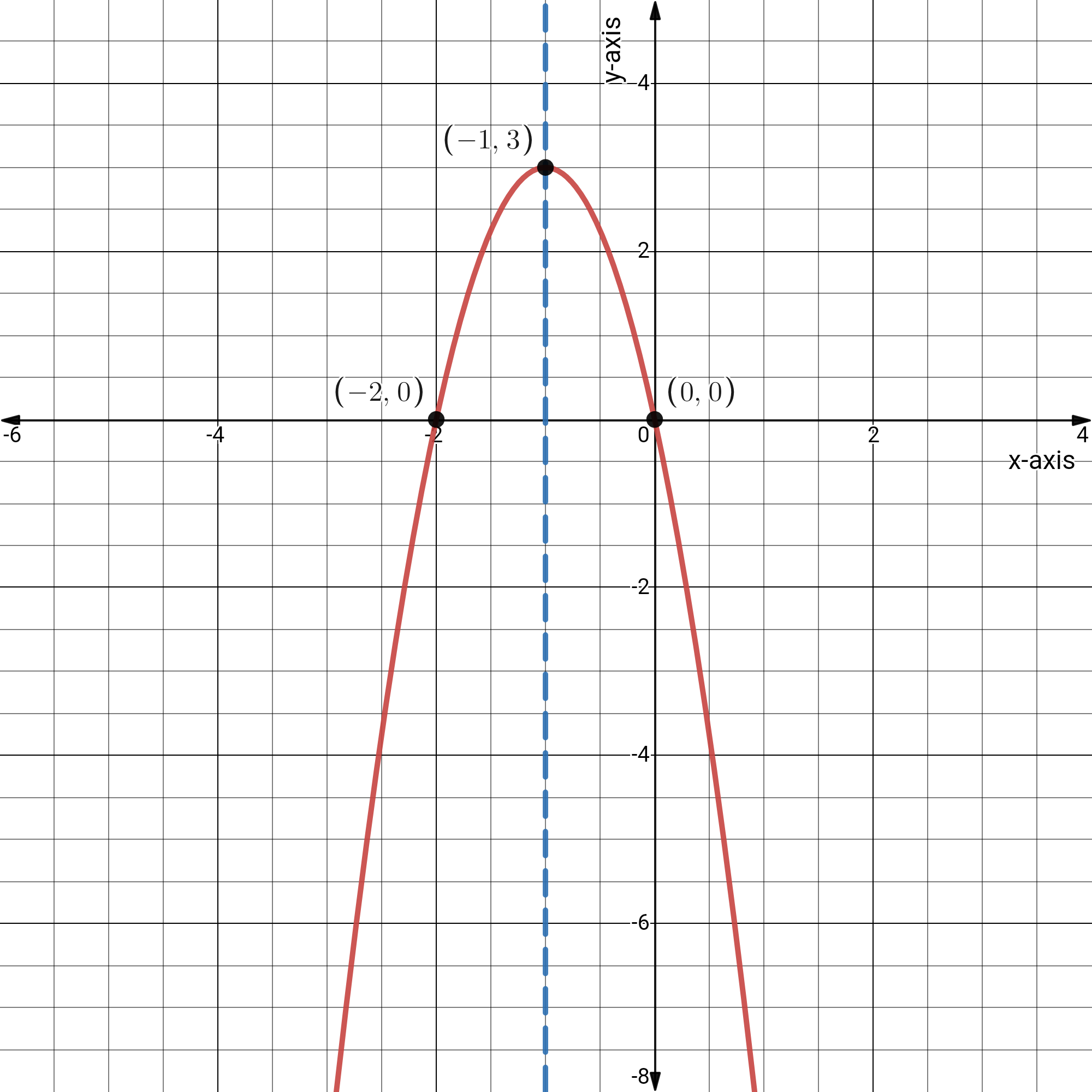
For any point other than the vertex, there is a corresponding point that is equidistant from the axis of symmetry.
In this case, the corresponding point of(0,0) is(−2,0).
Plot this two additional points and complete the sketch of the parabola.
The graph of given function is:
1 Vertex:(−1,3)
2.The domain:{x∣x∈R} and range:{y∣y≤3,y∈R}
3.The direction of opening: Downward
4.The equation of the axis of symmetry:x=−1
The graph of given function is:

Page 153 Problem 10 Answer
There is given a graph of a parabola.
It is asked to determine a quadratic function in vertex form.
The quadratic function can be found by finding the vertex and applying the vertex form of the parabola formula.
Firstly, we can find the vertex from the graph
We know that vertex of any parabola is the point where the graph changes its shape.
The graph is changing shape at (−3,0)
so, the vertex is (h,k)=(−3,0)
Apply vertex form of the parabola formula: y=a(x−h)2+k
Plug vertex point into the formula
Mcgraw-Hill Textbook Answers
y=a(x+3)2+0
Now, we can select anyone point and find a
The point is (−1,−2)
Plug this point into the formula−2=a(−1+3)2+0
22a=−2
4a=−2
a=−1/2
Plug this value into the formula
y=−1/2(x+3)2+0
Hence, the quadratic function is y=−1/2(x+3)2+0
Page 153 Problem 11 Answer
There is given a graph of a parabola.
It is asked to determine a quadratic function in vertex form.
The quadratic function can be found by finding the vertex and applying the vertex form of the parabola formula.
Firstly, we can find the vertex from the graph
We know that vertex of any parabola is the point where the graph changes its shape.
The graph is changing shape at (2,1)
so, the vertex is (2,1)
Apply vertex form of the parabola formula: y=a(x−h)2+k
Plug vertex point into the formula
y=a(x−2)2+1
Now, we can select anyone point and find a
The point is (1,5)
Plug this point into the formula
5=a(1−2)2+1
a+1=5
a=4
Plug this value into the formula
y=4(x−2)2+1
Hence, the quadratic function is f(x)=4(x−2)2+1
Mcgraw-Hill Textbook Answers
Page 154 Problem 12 Answer
The function is given as
f(x)=0.5x2−7
It is asked to find x-intercepts of this function without graphing
It can be found by replacing f(x) as zero and solve for x
The function is f(x)=0.5x2−7
We can set f(x)=0 and solve for x
f(x)=0.5x2−7=0
0.5x2−7=0
Add both sides by 7
0.5x2=7
Divide both sides by 0.5
0.5x2/0.5=7/0.5
x2=14
Take square root on both sides
x=√14,x=−√14
Hence, x-intercepts are x=√14,x=−√14
Page 154 Problem 13 Answer
The function is given as f(x)=−2(x+1)2
It is asked to find x−intercepts of this function without graphing
It can be found by replacing f(x) as zero and solve for x
The function is f(x)=−2(x+1)2
We can set f(x)=0 and solve for x
Mcgraw-Hill Textbook Answers
f(x)=−2(x+1)2=0
−2(x+1)2=0
Divide both sides by −2
−2(x+1)2/−2=0/−2
(x+1)2=0
Take square root on both sides x+1=0
x=−1,x=−1
Hence, x-intercepts are x=−1,x=−1
Page 154 Problem 14 Answer
The function is given as f(x)=−1/6(x−5)2−11
It is asked to find x− intercepts of this function without graphing.
It can be found by replacing f(x) as zero and solve for x
The function is
f(x)=−1/6(x−5)2−11
We can set f(x)=0 and solve for x
f(x)=−1/6(x−5)2−11=0
−1/6(x−5)2−11=0
−1/6(x−5)2−11+11=0+11
−1/6(x−5)2=11
(−1/6(x−5)2)(−6)=11(−6)
(x−5)2=−66
Take square root on both sides
There is a negative value on the right side
And we know that square root of negative is always imaginary values
So, x-intercepts do not exist for this function.
Hence, x-intercepts do not exist for this function.
Page 157 Problem 15 Answer
Given :- The equation of parabolay=7x2
To find :- The graph of the parabola and whether it has maximum or minimum value and also we have to find range of the function.
First we will plot the graph by comparing the graph of the parabola y=x2.
y=x2has vertex at origin because it is of form y=ax2 hence y=7x2 also has vertex at origin i.e.(0,0).
On comparing given parabola with standard equation we will get7>0 and 7>1 so the parabola will be upward and narrow than y=x2.
The required parabola is shown in graph in red color.
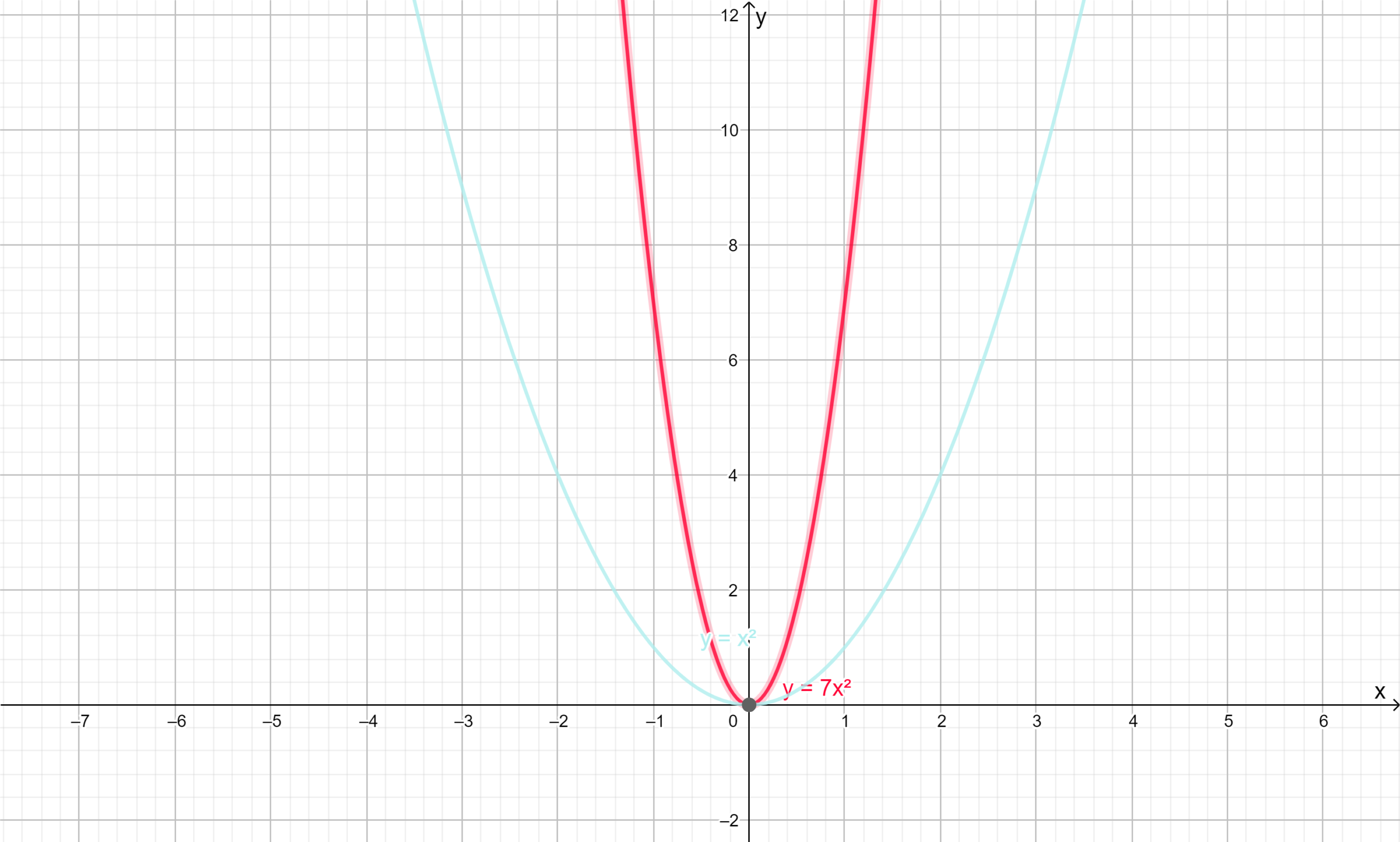
The range of the functiony=7x2 is{y∣y≥0,y∈R}.
To find the maxima or minima we will now differentiatey=7x2w.r.tx.
⇒dy/dx
=14x
⇒d2y/dx2
=14
⇒d2y/dx2>0
This means that function has minimum value.
The range of the parabola y=7x2 is{y∣y≥0,y∈R} and has minimum value.
Page 157 Problem 16 Answer
Given :-y=1/6x2
To find:- The graph of the parabola and whether it has maximum or minimum value and also we have to find range of the function.
First we will plot the graph by comparing the graph of the parabolay=x2
y=x2 has vertex at origin because it is of form y=ax2 hencey=1/6x2 also has vertex at origin.
On comparing given parabola with standard equation we will get a=1/6>0,1/6<1 therefore the parabola will open upward and wider than y=x2.
Red color curve represent the required parabola.
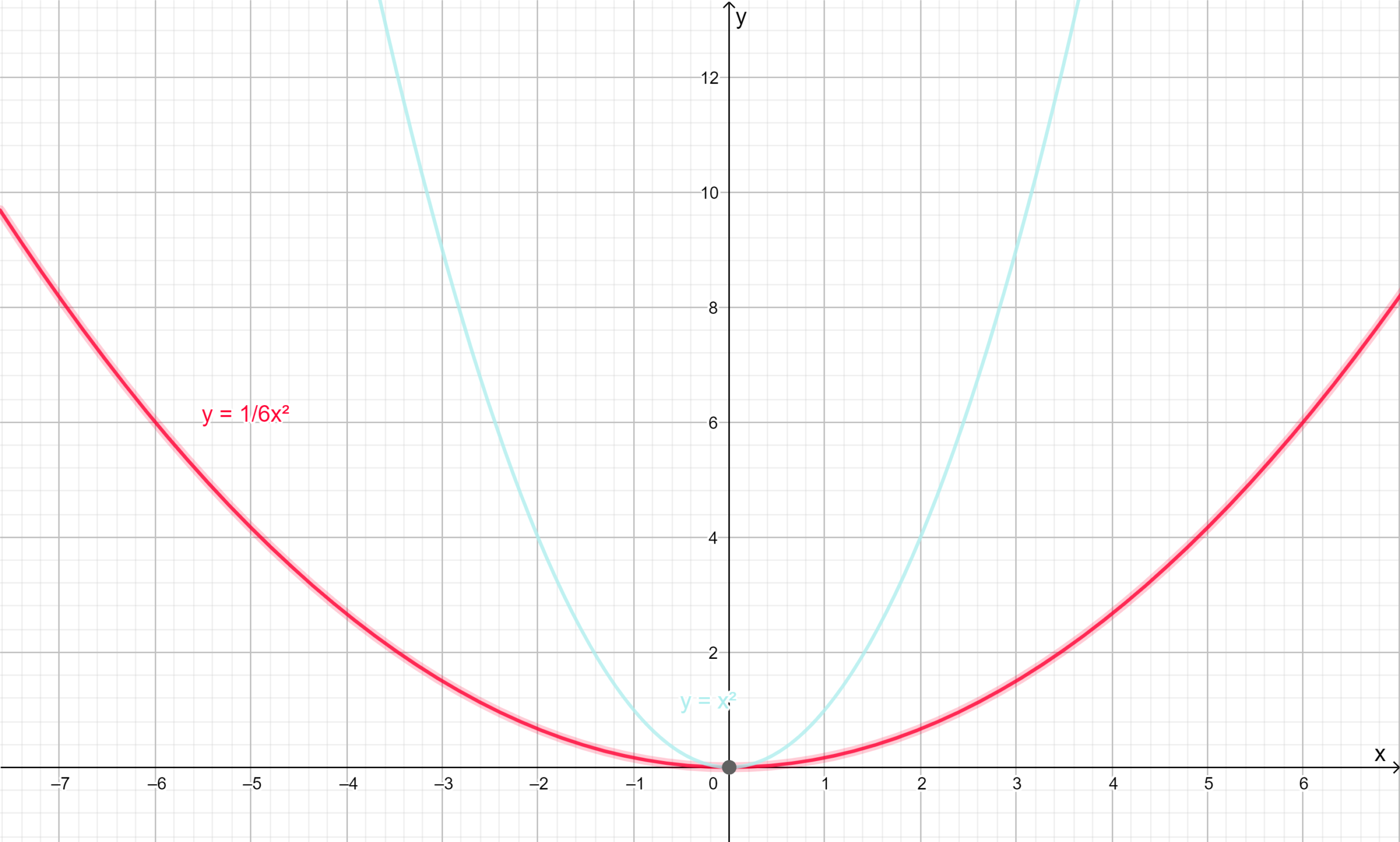
The range of the parabola is{y∣y≥0,y∈R}.
To find whether the function has minimum or maximum value, we will take derivate of the function twice.
⇒dy/dx=1/3x
⇒d2y/dx2=1/3
⇒d2y/dx2>0
Hence function has minimum value.
The range of y=1/6x2 is{y∣y≥0,y∈R} and function has minimum value.
Page 157 Problem 17 Answer
Given :-y=−4x2
To find :-State the direction of opening, whether it has a maximum or a minimum value, and the range.
First we will plot the graph by comparing the graph of the parabola y=x2.
y=x2 has vertex at origin since it is of form y=ax2 hencey=−4x2 has vertex at origin and narrower than y=x2 sincea=−4<−1 and it will open downward sincea=−4<0.
The graph is shown below in red color.
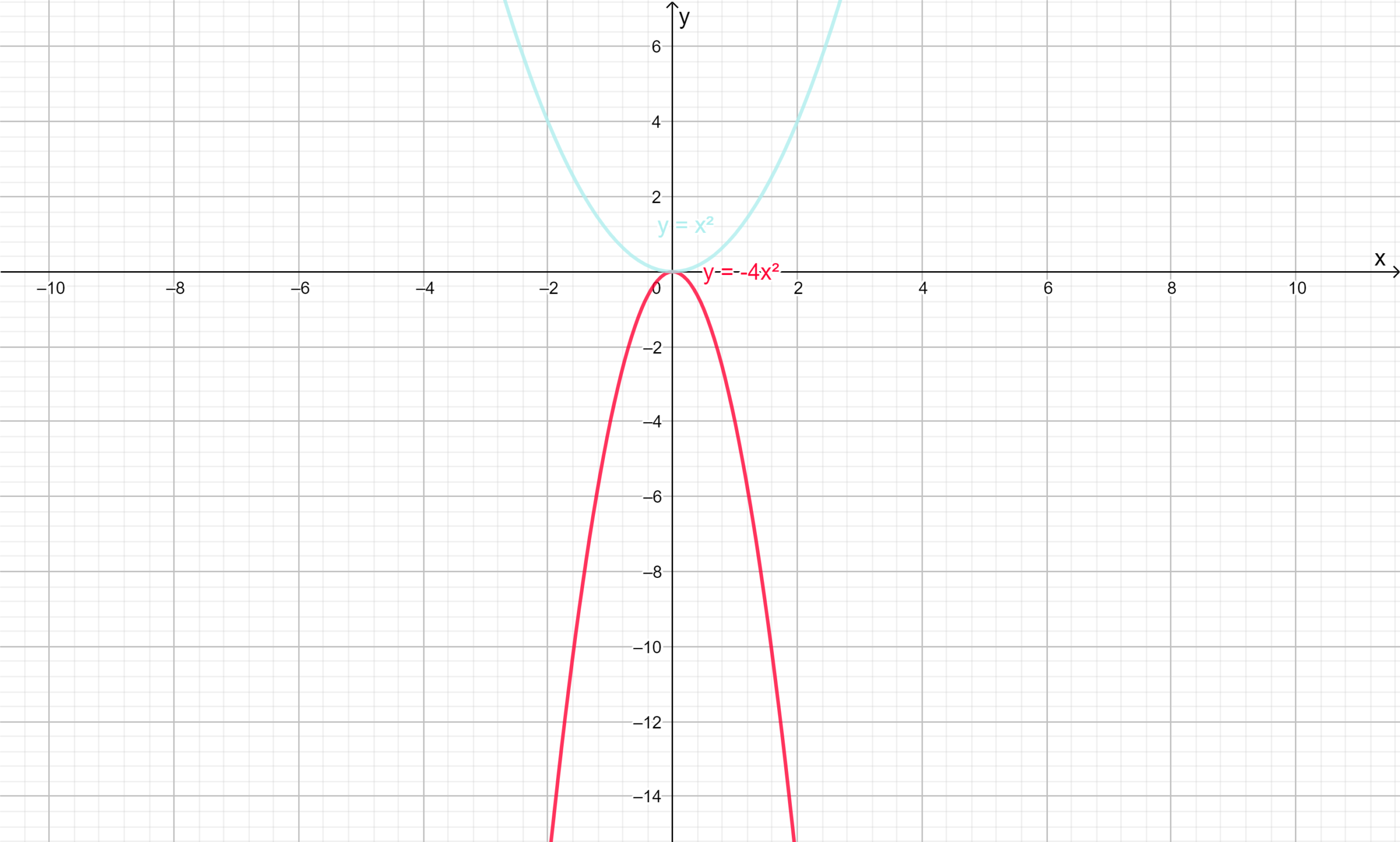
The range of the function isy=−4x2 is{y∣y≤0,y∈R}.
To find whether the function has minimum or maximum value we will take derivate of the function twice.
⇒dy/dx
=−8x
⇒d2y/dx2
=−8
⇒d2y/dx2<0
Hence function has maximum value.
The parabolay=−4x2 opens in downward and has range {y∣y≥0,y∈R} and also has maximum value.
Page 157 Problem 18 Answer
Given :- The equation of the parabola isy=−0.2×2
To find :-State the direction of opening, whether it has a maximum or a minimum value, and the range.
First we will plot the graph by comparing the graph of the parabolay=x2
y=−0.2×2 has vertex at origin since it is in the form ofy=ax2 . It will open in downward direction since a=−0.2<0 and wider than the parabolay=x2 because−1<−0.2<1.
The required graph of parabola is shown below in red color.

The range of the functiony=−0.2×2 is{y∣y≤0,y∈R}.
Take derivative of the function twice to determine whether it has maximum value or minimum value.
⇒dy/dx
=−0.4x
⇒d2y/dx2
=−0.4
⇒d2y/dx2<0
Hence function has maximum value.
F(x)=−0.2x2 which opens downward has range{y∣y≥0,y∈R} and also it has maximum value.
Page 157 Problem 19 Answer
Given :- The equations of the parabolas are y=x2,y=x2+1
To find :- The relation between given parabolas and sketch the graph of the second function in each pair, and determine the vertex, the equation of the axis of symmetry, the domain and range, and any intercepts.
As the coefficient of x2 is same in both the equation of parabola therefore second parabola i.e.y=x2+1 is as wide as first one.
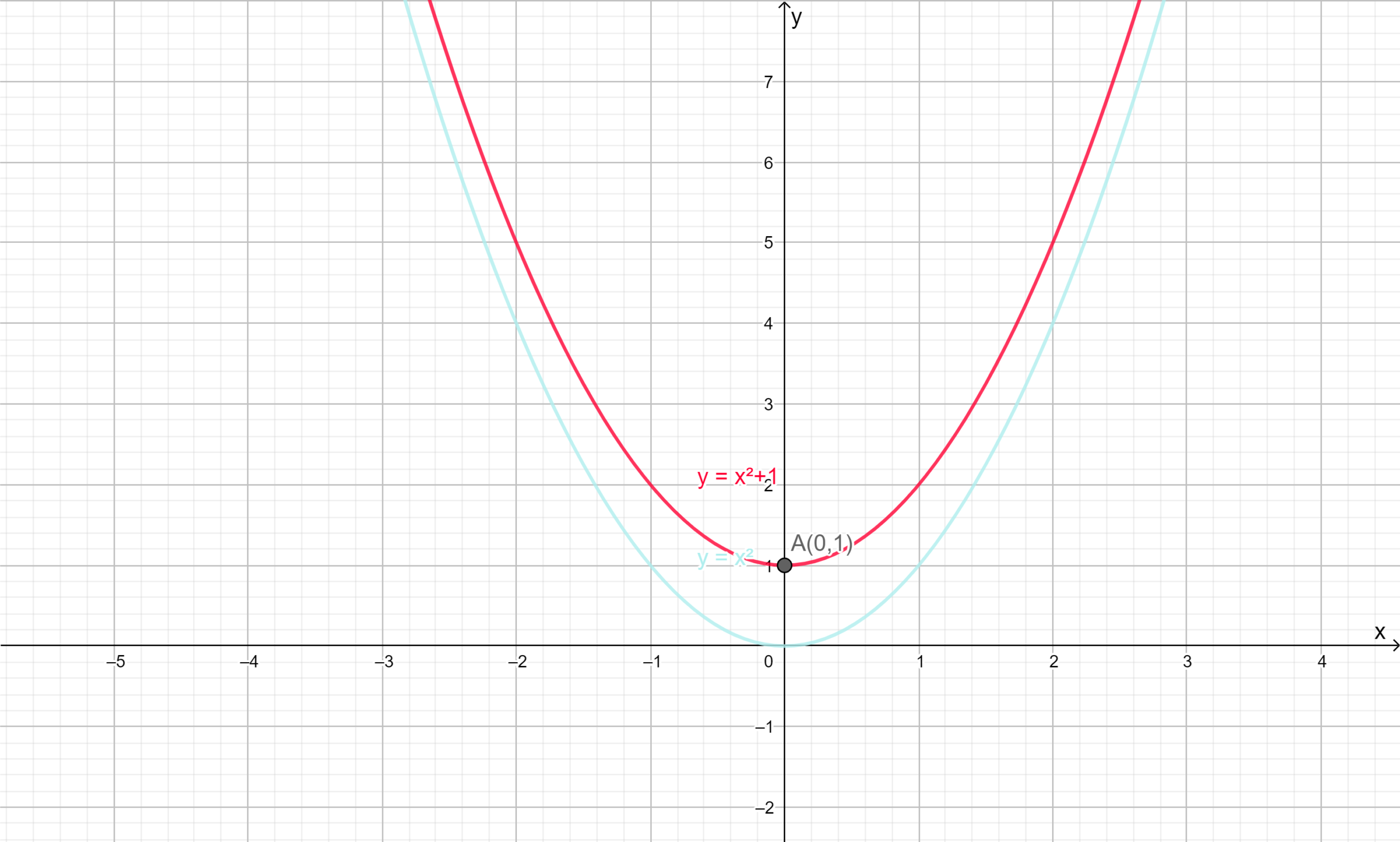
But it has different vertex which can be determined by comparing the standard equation we will get the vertex of the parabolay=x2+1 as(0,1) so the graph of second parabola can be get by shifting the first parabola upward ony−axis by 1 unit. as shown in figure.
This graph is symmetric about y-axis so the equation of axis of symmetry is x=0.
The domain of the function f(x)=x2+1 is{x∣−∞<x<∞,x∈R} and the range of the function is given by{y∣y≥1,y∈R}.
The y- intercept is calculated by putting x=0 iny=x2+1⇒y=1 and x-intercept is calculated by puttingy=0⇒x=√−1 which is imaginary so the second parabola does not cut x- axis.
The parabolay=x2+1 has vertex(0,1) ,y-intercept1unit,the domain of the parabola is{x∣−∞<x<∞,x∈R} and range is{y∣y≥1,y∈R} and the parabola is symmetric to the line x=0.
Page 157 Problem 20 Answer
Given pair of functions is y=x2 andy=(x−2)2.
We need to describe the relation between the graphs of given functions and also to find the vertex, equation of axis of symmetry, the domain and range and the intercepts (if any) of the second function.
Comparey=(x−2)2 withy=(x−c)2 and then describe the relation between the graphs of given functions and then draw the graph of second function.
Comparey=(x−2)2 withy=(x−c)2, we get c=2.
Therefore the graph ofy=(x−2)2 is obtained by horizontally shifting the graph of y=x2 to the right side by2 units.
The graph ofy=(x−2)2 is,
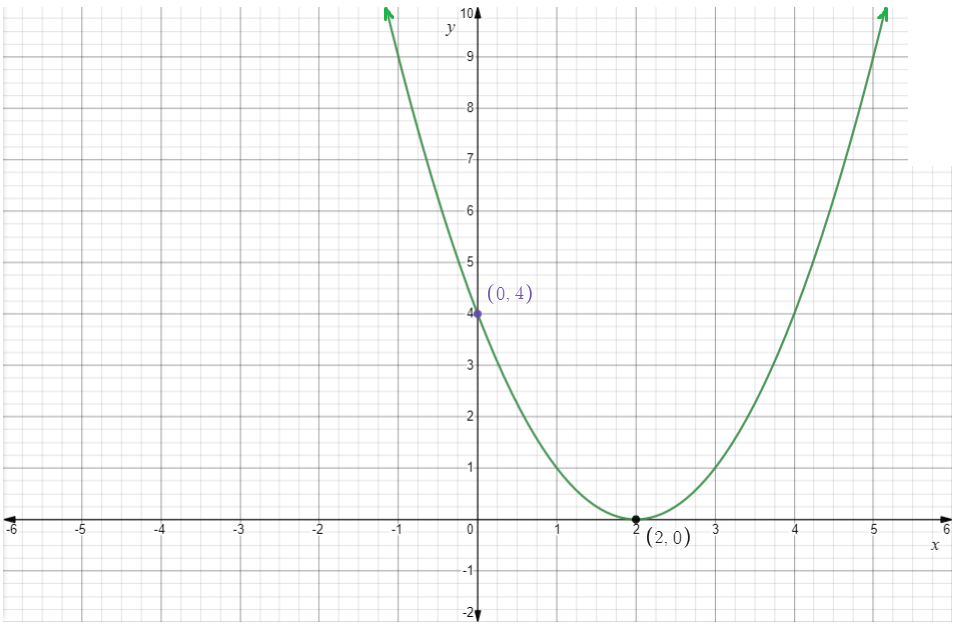
The vertex is(2,0).
The equation of axis of symmetry is,
x=c
⇒x=2
The domain is the set of all real numbers.
The range is[0,∞).
x-intercept is 2 and y-intercept is 4.
The graph is,
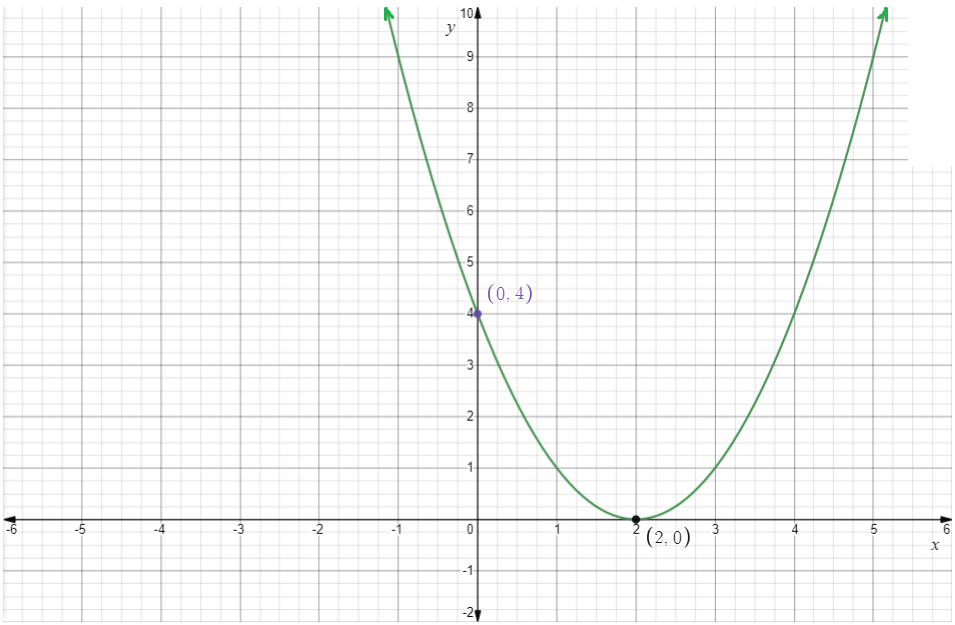
The vertex is(2,0).
The equation of axis of symmetry is x=2.
The domain is the set of all real numbers.
The range is[0,∞).
x-intercept is 2 and y-intercept is 4.
Page 157 Problem 21 Answer
Given pair of functions is y=x2 and y=x2−4.
We need to describe the relation between the graphs of given functions and also to find the vertex, equation of axis of symmetry, the domain and range and the intercepts (if any) of the second function.
Comparey=x2−4 with y=x2−k and then describe the relation between the graphs of given functions and then draw the graph of second function.
Comparey=x2−4 with y=x2−k, we get k=4.
Therefore the graph ofy=x2−4 is obtained by vertically shifting the graph of y=x2 downward by 4 units.
Now the graph ofy=x2−4 is,
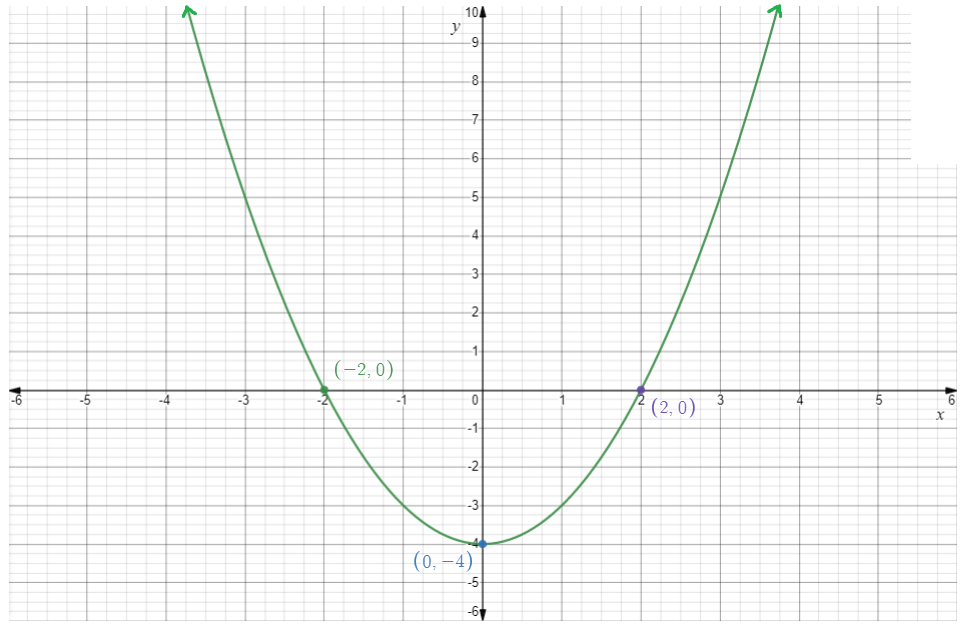
The vertex is(0,−4).
The equation of axis of symmetry isy-axis. That is,x=0.
The domain is the set of all real numbers.
The range is[−4,∞).
x-intercepts are−2,2 and y-intercept is−4.
The graph is,
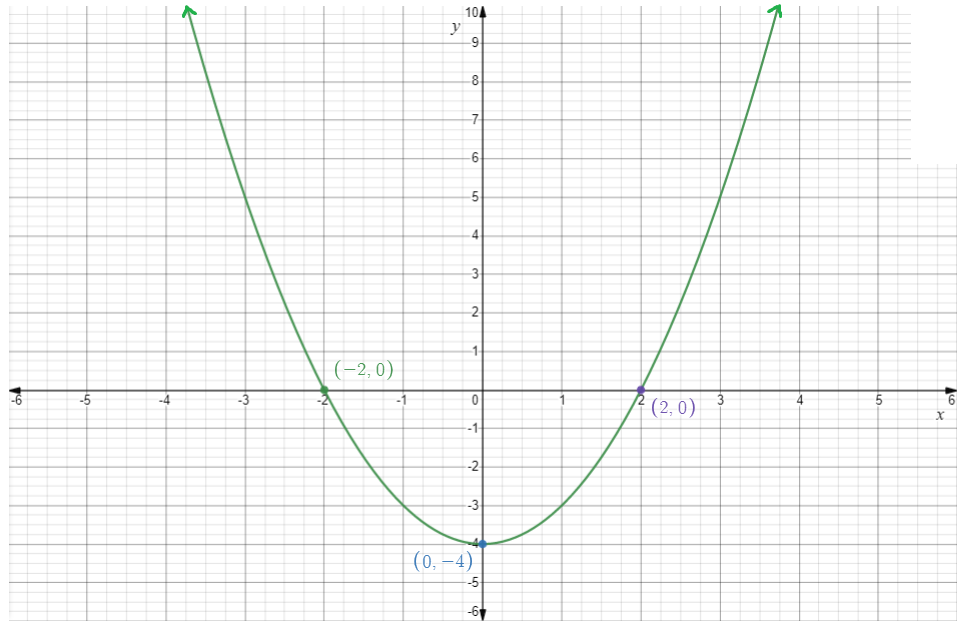
The vertex is(0,−4).
The equation of axis of symmetry is x=0.
The domain is the set of all real numbers.
The range is[−4,∞).
x-intercepts are−2,2 and they-intercept is−4.
Page 157 Problem 22 Answer
Given pair of functions is y=x2 and y=(x+3)2.
We need to describe the relation between the graphs of given functions and also to find the vertex, equation of axis of symmetry, the domain and range and the intercepts (if any) of the second function.
Comparey=(x+3)2 with y=(x+c)2 and then describe the relation between the graphs of given functions and then draw the graph of second function.
Comparey=(x+3)2 withy=(x+c)2, we get
c=3.
Therefore the graph ofy=(x+3)2 is obtained by horizontally shifting the graph of y=x2 to the left side by 3 units.
Now the graph ofy=(x+3)2 is,

The vertex is(−3,0).
The equation of axis of symmetry is,
x=−c
⇒x=−3
The domain is the set of all real numbers.
The range is[0,∞).
x-intercept is−3 and y-intercept is 9.
The graph is,
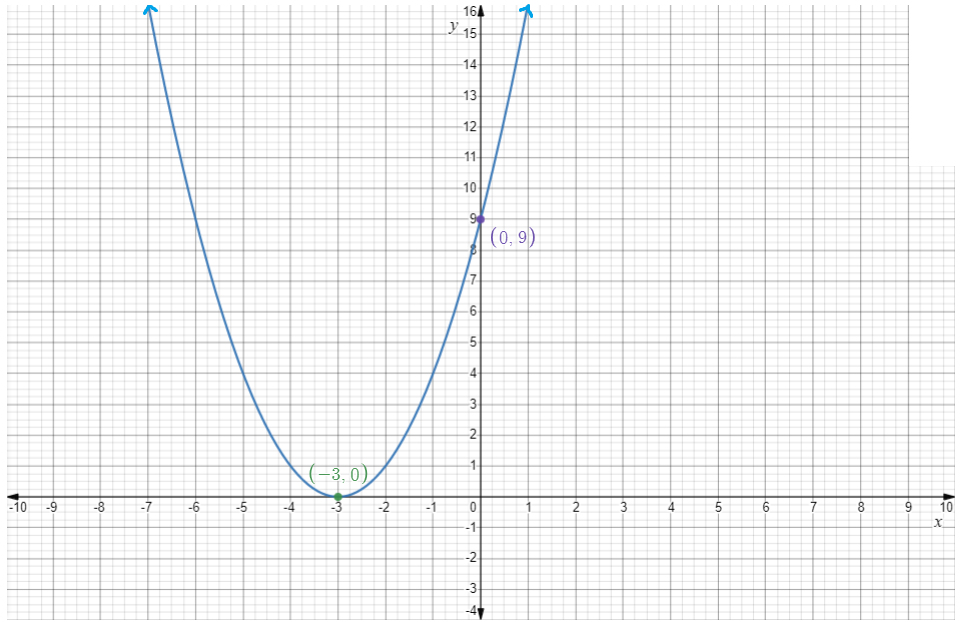
The vertex is(−3,0).
The equation of axis of symmetry is x=−3.
The domain is the set of all real numbers.
The range is[0,∞).
x-intercept is−3 and y-intercept is 9.
Page 157 Problem 23 Answer
Given function is f(x)=(x+5)2+11.
We need to describe how to sketch the graph of the given function using transformations.
First consider the graph of f(x)=x2.
Now the graph of(x+5)2 can be obtained by horizontally shifting the graph of x2to the left side by 5 units.
Now the graph of f(x)=(x+5)2+11 can be obtained by vertically shifting the graph of(x+5)2 upward by11 units.
The graph off(x)=(x+5)2+11 can be obtained by horizontally shifting the graph off(x)=x2 to the left side by 5 units and then vertically shifting upward by 11 units.
Page 157 Problem 24 Answer
Given function isf(x)=−3×2−10.
We need to describe how to sketch the graph of the given function using transformations.
First consider the graph off(x)=x2.
Now the graph of−3×2 can be obtained by reflecting the graph of x2 in the x-axis and narrowing the graph by 3 units.
Now the graph off(x)=−3×2−10 can be obtained by vertically shifting the graph of−3×2 downward by 10 units.
The graph off(x)=−3×2−10 can be obtained by reflecting the graph of f(x)=x2 in the x-axis and narrowing the graph by 3 units and then vertically shifting down by 10 units.
Page 157 Problem 25 Answer
Given function isf(x)=5(x+20)2−21.
We need to describe how to sketch the graph of the given function using transformations.
First consider the graph off(x)=x2.
Now the graph of5(x+20)2 can be obtained by horizontally shifting the graph of x2 to the left side by20 units and then narrowing the graph by5 units.
Now the graph off(x)=5(x+20)2−21 can be obtained by vertically shifting the graph of 5(x+20)2 downward by 21 units.
The graph off(x)=5(x+20)2−21 can be obtained by horizontally shifting the graph of x2 to the left side by 20 units and then narrowing the graph by 5 units and then vertically shifting down by 21units.
Page 157 Problem 26 Answer
Given: f(x)=−1/8(x−5.6)2+13.8
To Describe how to sketch the graph of each function using transformations.
We have the function f(x)=−1/8(x−5.6)2+13.8
The graph of f(x)=−1/8(x−5.6)2+13.8 can be obtained from the graph of f(x)=−x2 by shifting the graph by a factor of 13.8 along the vertical direction also right shift by a factor of 1/8
So the graph of the equation is

Hence, the graph of the equation can be sketched by transformation as shift the graph by a factor of 13.8 along the vertical direction also right shift by a factor of 1/8 and the graph is
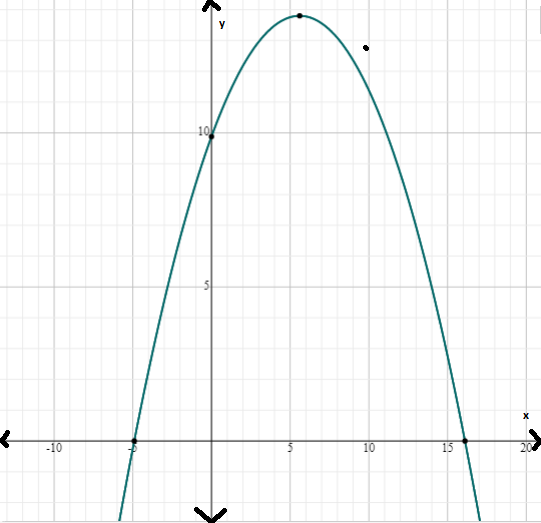
Page 157 Problem 27 Answer
Given: a) y=−(x−3)2+9
To Sketch the graph of each function. Identify the vertex, the axis of symmetry, the direction of opening, the maximum or minimum value, the domain and range, and any intercepts.
We have the equation y=−(x−3)2+9
The graph of the function is

Vertex of the function is: Maximum (3,9)
Axis interception point of the function is X-intercept:(6,0),(0,0), Y-intercept:(0,0)
The direction of opening is downward
The domain of the function is (−∞,∞)
The Range of the function is (−∞,9)
Hence, the graph of the equation is
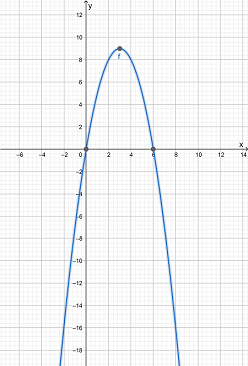
Vertex of the function is: Maximum (3,9)
Axis interception point of the function is X-intercept (6,0),(0,0), Y-intercept (0,0)
The direction of opening is downward
The domain of the function is (−∞,∞)
The Range of the function is (−∞,9)
Page 157 Problem 28 Answer
Given: y=0.25(x+4)2+1
To Sketch the graph of each function.
Identify the vertex, the axis of symmetry, the direction of opening, the maximum or minimum value, the domain and range, and any intercepts.
We have the function y=0.25(x+4)2+1
The graph of the function is

Vertex of the function is: Minimum (-4,1)
Axis interception point of the function is Y-intercept (0,5)
The direction of opening is upward
The domain of the function is (−∞,∞)
The Range of the function is [1,∞)
Hence, the graph of the function is
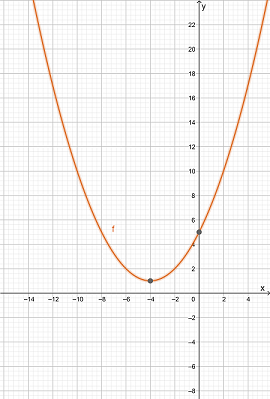
Vertex of the function is: Minimum (-4,1)
Axis interception point of the function is Y-intercept (0,5)
The direction of opening is upward
The domain of the function is (−∞,∞)
The Range of the function is [1,∞)
Page 157 Problem 29 Answer
Given: y=−3(x−1)2+12
To Sketch the graph of each function.
Identify the vertex, the axis of symmetry, the direction of opening, the maximum or minimum value, the domain and range, and any intercepts.
We have the function y=−3(x−1)2+12
The graph of the function is
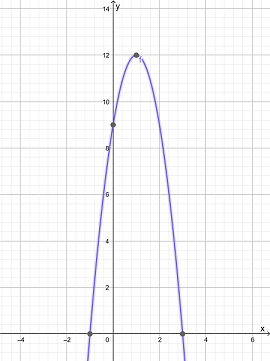
Vertex of the function is: Maximum (1,12)
Axis interception point of the function is X-intercept: (3,0),(-1,0), Y-intercept (0,9)
The direction of opening is downward
The domain of the function is (−∞,∞)
The Range of the function is (−∞,12]
Hence the graph of the equation is
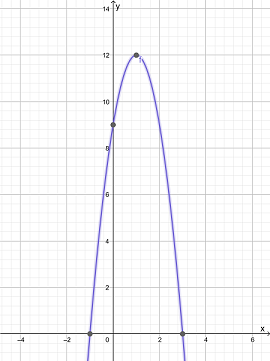
Vertex of the function is: Maximum (1,12)
Axis interception point of the function is X-intercept: (3,0),(-1,0), Y-intercept (0,9)
The direction of opening is downward
The domain of the function is (−∞,∞)
The Range of the function is (−∞,12]
Page 157 Problem 30 Answer
Given: y=1/2(x−2)2−2
To Sketch the graph of each function.
Identify the vertex, the axis of symmetry, the direction of opening, the maximum or minimum value, the domain and range, and any intercepts.
We have the function y=1/2(x−2)2−2
The graph of the function is

Vertex of the function is: Minimum (2,-2)
Axis interception point of the function is X-intercept: (4,0),(-1,0), Y-intercept (0,0)
The direction of opening is upward
The domain of the function is (−∞,∞)
The Range of the function is [−2,∞)
Hence, the graph of the function is
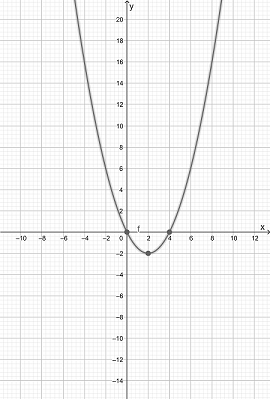
Vertex of the function is: Minimum (2,-2)
Axis interception point of the function is X-intercept: (4,0),(-1,0), Y-intercept (0,0) The direction of opening is upward
The domain of the function is (−∞,∞)
The Range of the function is [−2,∞)
McGraw Hill Pre Calculus 11 Student Edition Chapter 2 Exercise 2.4 Trigonometry
Pre-Calculus 11 Student Edition Chapter 2 Trigonometry
Page 114 Problem 1 Answer
The objective of the problem is to draw △ABC
with a given length of sides:
a=3 cm
b=4 cm
c=5 cm
The required triangle with given side lengths can be done with a ruler as shown below:
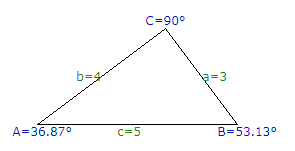
Hence, the required triangle with given side values can be shown below:
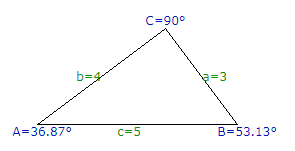
Page 114 Problem 2 Answer
The values of a2,b2, and c2.
The given values of a=3,b=4, and c=5
The value of
a2=(3)2=9
b2=(4)2=16
c2=(5)2=25
The values are :
a2=9,b2=16,c2=25
Precalculus Textbook Mcgraw Hill Answers
Page 114 Problem 3 Answer
On comparing the values of a2,b2,c2.
The values are :a2=9,b2=16,c2=25.
The value of −a2=−9
The relation is true when −9+16<25.
Hence, the relation is true when a2+b2 <c2.
The relation is true when −a2+b2<c2.
Read and Learn More Precalculus Textbook Mcgraw Hill Answers
Page 114 Problem 4 Answer
The measure of ∠C.
Using Pythagorean Theorem, a2+b2=c2
Here, the given values are a=3,b=4,c=5
This triangle follows the Pythagorean triplet rule,
c2=a2+b2
52=32+42
It is a right-angled triangle at C.
So, ∠C=90˚
The value of ∠C=90˚.
Page 114 Problem 5 Answer
Draw an acute ΔABC, Acute angle is less than 90∘
So we make a triangle with all the angles less than 90∘
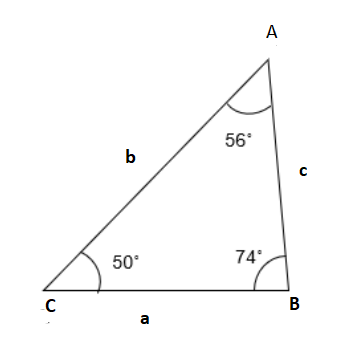
For example , we can make a triangle with angle ∠A=56∘and angle∠B=74∘and angle ∠C=50∘
All angles are less than 90∘.
Acute triangle ABC
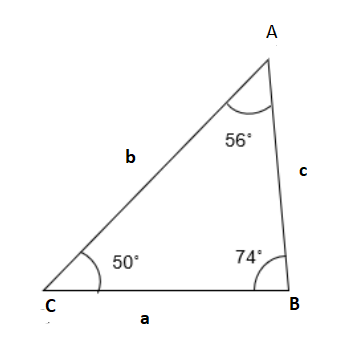
Page 114 Problem 6 Answer
From part (a) we got the acute triangle ABC
Make the base that is length of a= 5 cm. Using protractor measure the angle and connect all the vertices.
Now measure the length of b and c
Length of b=5.8 and c=4.6
Length of sides of triangle ABC
Precalculus Textbook Mcgraw Hill Answers
a=5 cm
b= 5.8 cm
c=4.6 cm
Page 114 Problem 7 Answer
Given: a=5,b=5.8,c=4.6
To find: a2,b2,c2
a2=5×5=25
b2=5.8×5.8=33.64
c2=4.6×4.6=21.16
a2=25,b2=33.64,c2=21.16
Page 114 Problem 8 Answer
Given: a2=25,b2=33.64,c2=21.26
To compare: a2+b2and c2
a2+b2=25+33.64=58.64
So: a2+b2>c2 is true.
We do not get the other statement true after calculations.
a2+b2>c2 is true.
Page 115 Problem 9 Answer
Given: a2+b2=25,c2=25
To find: 2abcosC=a2+b2−c2
2abcosC=25-25=0
2ab cos C = 0
Page 115 Problem 10 Answer
Given: a2+b2=58.64,c2=21.26
To find: 2abcosC
2ab cos C = 58.64 − 21.26=37.38
2ab cos C = 37.38
Mcgraw Hill Precalculus Textbook Answers
Page 115 Problem 11 Answer
We have given a triangle ΔABC:-

We have to assume different values of a,b,c and complete the following table :-

Firstly we have given that a=3,b=4,c=5.
then we have :-
c2=52⇒c2=25 and
a2+b2=32+42
⇒a2+b2=9+16
⇒a2+b2=25
Now using the cosine laws, we have :-
c2=a2+b2−2abcosC
⇒2abcosC=a2+b2−c2
Then by putting the values we have :-
2abcosC=25−25⇒2abcosC=0
Now assume that :-
a=4,b=5,c=6
Then we have :-
c2=62⇒c2=36 and
a2+b2=42+52
⇒a2+b2=16+25
⇒a2+b2=41 and
2abcosC=a2+b2−c2
⇒2abcosC=41−36
⇒2abcosC=5
Now assume that:-
a=5,b=6,c=7, then we have :-
c2=72⇒c2=49 and
a2+b2=52+62
⇒a2+b2=25+36
⇒a2+b2=61 and
2abcosC=a2+b2−c2
⇒2abcosC=61−49
⇒2abcosC=12
Now assume that :-a=5,b=6,c=6
Then we have:-c2=62⇒c2=36 and
a2+b2=52+62⇒a2+b2
=25+36⇒a2+b2=61 and
2abcosC=a2+b2−c2
⇒2abcosC=61−36
⇒2abcosC=25
Complete the table :-
Mcgraw Hill Precalculus Textbook Answers
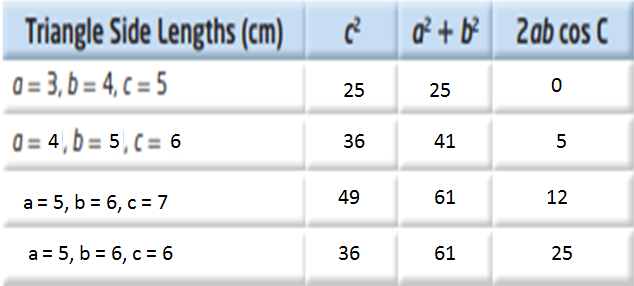
The required completed table is as shown below :-
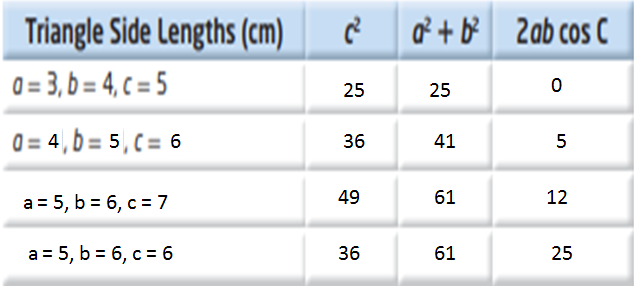
Page 115 Problem 12 Answer
Draw a triangle ABC with angle C obtuse.
Let us draw a triangle with angle C= 94 degrees
The sides are a=3, b=5 and c=6
The equation we got from step 4 is
c2=a2+b2−2abcos(C)
Substitute the values
62=32+52−2(3)(5)cos(94)
36=9+25−(−2)
36=36 True
The equation we got in step 4 hold true for the triangle with angle C= 95, a=3, b=5 and c=6
Page 117 Problem 13 Answer
Given: The distance from point C to A is 35.5 m and from C to B is 48.8 m.
Also, the angle at C is 54∘.
To find: The distance AB.
Use cosine law to find the required distance.
First, draw the diagram for better understanding.
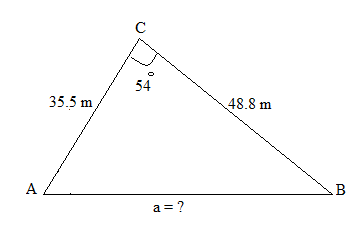
Use cosine law a2=b2+c2−2bccosA to find the distance AB. Herea=AB,b=35.5,c=48.8 and A=54∘.
Substitute all the values in the formula and simplify to find the distance AB.
a2=b2+c2−2bccosA
AB2=35.52+48.82−2(35.5)(48.8)cos54∘
AB2≈1260.25+2381.44−3464.8(0.58778)
AB2≈1260.25+2381.44−2036.5583
AB2≈1605.1316
AB≈√1605.1316
AB≈40.1
Hence the distance AB is approximately 40.1 m.
Mcgraw Hill Precalculus Textbook Answers
Page 119 Problem 14 Answer
Given: In triangle ABC ,a=9,b=7 and ∠C=33.6∘.
To find: The length of the unknown side and the measures of the unknown angles.
Use cosine law to determine the length of the unknown side and the measures of the unknown angles.
First, sketch the diagram of the triangle ABC.
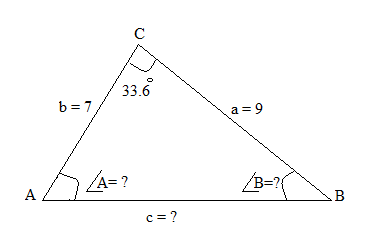
Now find the length of the side c by using cosine law. Substitute a=9,b=7 and ∠C=33.6∘in the cosine law and simplify.
c2=a2+b2−2abcosC
c2=92+72−2(9)(7)cos33.6∘
c2=81+49−126(0.832…)
c2=81+49−104.948…
c2=25.051…
c=√25.051…
c=5
Now find the unknown angles of the triangle.
Substitute a=9,b=7 and c=5 in the cosine law and simplify.
cosB=a2+c2−b2
2ac/cosB=92+52−72/2(9)(5)
cosB=81+25−49/90
cosB=57/90
∠B=cos−1(57/90)
∠B=cos−1/(0.633…)
∠B=50.703∘…
Thus the measure of∠B is approximately 50.7∘.
Use the angle sum property of a triangle to find the measure of angle A
∠A+∠B+∠C=180∘
∠A+50.7∘+33.6∘=180∘
∠A=180∘−(50.7∘+33.6∘)
∠A=180∘−84.3∘
∠A=95.7∘
Thus the measure of∠A is 95.7∘.
Hence the length of side c is 5 and the measures of unknown angles are∠A=95.7∘ and ∠B=50.7∘.
Page 119 Problem 15 Answer
The given figure is:

We need to find the length of the third side of the given triangle.
We will use the Law of Cosine to find the length of the third side of the given triangle.
In the given triangle, we have a=14,b=9 and C=17∘.
Using the Law of Cosine, we get
c2=(14)2+(9)2−2(14)(9)cos(17∘)
c2=196+81−252(0.9563)
c2=277−240.9876
c2=36.0124
c=√36.0124
c≈6
The length of the third side of the given triangle is about 6 cm.
Mcgraw Hill Precalculus Textbook Answers
Page 119 Problem 16 Answer
The given figure is:

We need to find the length of the third side of the given triangle, i.e., MN.
We will use the Law of Cosine to find the length of the third side of the given triangle.
In triangle MNL,NL=13,ML=29 and ∠L=41∘. So, we have a=13,b=29 and C=41∘.
Using the Law of Cosine, we get
c2=(13)2+(29)2−2(13)(29)cos(41∘)
c2=169+841−754(0.7547)
c2=1010−569.0438
c2=440.9562
c=√440.9562
c≈21
The length of the third side of the given triangle is about 21 mm.
Page 119 Problem 17 Answer
The given figure is:

We need to find the length of the third side of the given triangle, i.e., DE.
We will use the Law of Cosine to find the length of the third side of the given triangle.
In the given triangle DEF,EF=21,DF=30,m∠F=123∘..So, we have a=21,b=30 and C=123∘.
Using the Law of Cosine, we get
c2=(21)2+(30)2−2(21)(30)cos(123∘)
c2=441+900−1260(−0.544639)
c2=1341+686.24514
c2=2027.24514
c=√2027.24514
c≈45.02
The length of the third side of the given triangle is about 45.02 m.
Mcgraw Hill Precalculus Textbook Answers
Page 119 Problem 18 Answer
The given figure is:

We need to find the measure of ∠J.
We will use the Law of Cosine to find the measure of the required angle.
In the given triangle the opposite side of angle J is IH=10 m. So, we have a=10,b=11,c=17.
Using the Law of Cosine, we get
cosJ=(11)2+(17)2−(10)2/2(11)(17)
cosJ=121+289−100/374
cosJ=310/374
J=cos−1(310/374)
J≈34.02
The measure of angle J is 34.02∘.
Page 119 Problem 19 Answer
The given figure is:

We need to find the measure of the angle L.
We will use the Law of Cosine to find the measure of the required angle.
In the given triangle the opposite side of angle L is MN=18 cm. So, we have a=18, b=10.4, c=21.9.
Using the Law of Cosine, we get
cosL=(10.4)2+(21.9)2−(18)2/2(10.4)(21.9)
cosL=108.16+479.61−324/455.52
cosL=263.77/455.52
L=cos−1/(263.77/455.52)
L≈54.62∘
The measure of angle L is 54.62∘.
Mcgraw Hill Precalculus Textbook Answers
Page 119 Problem 20 Answer
The given figure is:

We need to find the measure of angle P.
We will use the Law of Cosine to find the measure of the required angle.
In the given triangle the opposite side of angle P is QR=14 mm. So, we have a=14,b=6,c=9.
Using the Law of Cosine, we get
cosP=(6)2+(9)2−(14)2/2(6)(9)
cosP=36+81−196/108
cosP=−79/108
P=cos−1(−79/108)
P≈137.01∘
The measure of angle P is 137.01∘.
Page 119 Problem 21 Answer
The given figure is:

We need to find the measure of angle C.
We will use the Law of Cosine to find the measure of the required angle.
In the given triangle the opposite side of the angle C is AB=31 m. So, we have a=20,b=13,c=31.
Using the Law of Cosine, we get
cosC=(20)2+(13)2−(31)2/2(20)(13)
cosC=400+169−961/520
cosC=−392/520
C=cos−1(−392/520)
C≈138.92∘
The measure of angle C is 138.92∘.
Page 120 Problem 22 Answer
Given: In a triangle PQR,PQ=29,PR=28 and ∠P=52∘.
To find: The length of the unknown side and the measures of the unknown angles.
Use cosine law to determine the length of the unknown side and the measures of the unknown angles.
For finding the unknown side, we will use the cosine law.
Applying cosine law, the length of p will be,
p2=q2+r2−2qrcosP
⇒p2=282+292−2×28×29×cos520
⇒p2=784+841−1624×0.6157
⇒p2=1625−999.8968
⇒p2=625.1032
⇒p=25.00206
Hence, p=25km (approx)
We will find ∠Q by using formula
cosQ=p2+r2−q2/2pr
⇒cosQ=252+292−282/2×25×29
⇒cosQ=625+841−784/1450
⇒cosQ=682/1450
⇒cosQ=0.470345
⇒Q=cos−1/(0.470345)
⇒∠Q=620
Now, ∠R=1800−∠Q−∠P
∠R=1800−620−520
∠R=660
Hence, The missing angles are 620 and 520
The missing angles are 620 and 520.
The missing side is 25km
Page 120 Problem 23 Answer
Given that : In ΔRST,
Sidesr=5cm,s=9.1cm,t=6.8cm
To Find :∠R,∠S,∠T
Strategy: We will use cosine law to find the angles of triangle.
or ∠R, we have
cosR=s2+t2−r2/2st
⇒cosR=9.12+6.82−52/2×9.1×6.8
⇒cosR=82.81+46.24−25/123.76
⇒cosR=104.05/123.76
⇒cosR=0.84074
⇒R=cos−1/(0.84074)
⇒R=32.78 (approx) Using cosine inverse table
⇒∠R=330
For ∠S, we have
cosS=r2+t2−s2/2rt
⇒cosS=52+6.82−9.12/2×5×6.8
⇒cosS=25+46.24−82.81/2×5×6.8
⇒cosS=−11.57/68
⇒cosS=−0.17015
⇒S=cos−1(−0.170150)
⇒S=99.796 (approx) using cosine inverse table
Hence, ∠S=1000
We will use the following relation to find ∠T:∠R+∠S+∠T=1800
⇒330+1000+∠T=1800
⇒1330+∠T=1800
⇒∠T=1800−1330
⇒∠T=470
Hence, ∠T=470
he measure of angles of ΔRST is∠R=330,∠S=1000,∠T=470.
Page 120 Problem 24 Answer
Given: In a triangle ABC, AB=24, AC=34 and ∠A=67∘.
To find: The length of BC.
Use cosine law to determine the required length.
First sketch the triangle ABC.
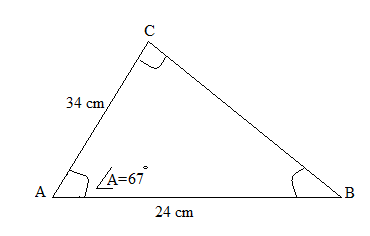
SubstituteAB=24, AC=34 and ∠A=67∘in the cosine law and simplify.
BC2=AB2+AC2−2(AB)(AC)cosA
BC2=242+342−2(24)(34)cos67∘
BC2=576+1156−1632(0.390…)
BC2=576+1156−637.673…
BC2=1094.326…
BC=√1094.326…
BC=33
Hence the length of BC is approximately33 m.
Page 120 Problem 25 Answer
Given: In a triangle ABC, AB=15,BC=8 and ∠B=24∘.
To find: The length ofAC.
Use cosine law to determine the required length.
First sketch the triangle ABC.
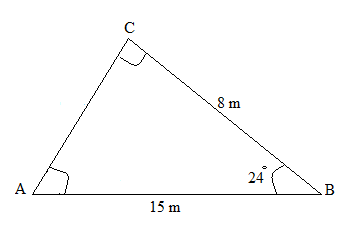
SubstituteAB=15,BC=8 and ∠B=24∘in the cosine law and simplify to find the length of AC.
AC2=AB2+BC2−2(AB)(BC)cosB
AC2=152+82−2(15)(8)cos24∘
AC2=225+64−240(0.913…)
AC2=225+64−219.250…
AC2=69.749…
AC=√69.749…
AC=8.4
Hence the length of AC is approximately 8.4 m.
Page 120 Problem 26 Answer
Given: AC = 10 cm, BC = 9 cm, and ∠C = 48°. To Determine the length of AB.By using cosine law
We have triangle ABC with AC = 10 cm, BC = 9 cm, and ∠C = 48°
So according to the cosine law

AB2=102+92−2(10)(9)cos48∘
AB2=60.556…
AB2=√60.556…
AB=7.781…
AB=7.8 cm , to the nearest tenth of a centimetre
Hence, the length of AB. is 7.8 cm
Page 120 Problem 27 Answer
Given: AB = 9 m, AC = 12 m, and BC = 15 m.To Determine the measure of ∠B.By using sine ratio
We have AB = 9 m, AC = 12 m, and BC = 15 m.
△ABC is a right triangle, because 152=92+122

Use the sine ratio.
sin ∠B∠B
=12/15
=sin−1(12/15)
=53.130…
R=53∘
∠B=53∘, to the nearest degree.
Hence, the measure of ∠B is 53o
Page 120 Problem 28 Answer
Given: AB = 18.4 m, BC = 9.6 m, and AC = 10.8 m. To Determine the measure of ∠A.By using cosine law
We have AB = 18.4 m, BC = 9.6 m, and AC = 10.8 m.
using the cosine law

9.62=10.82+18.42−2(10.8)(18.4)cosA
92.19=116.64+338.56−397.44cosA
397.44cosA=455.2−92.19
cosA=363.01/397.44
∠A=cos−1(363.01/397.44)
∠A=24.024…
∠A=24∘, to the nearest degree.
Hence, the measure of ∠A is 24o
Page 120 Problem 29 Answer
Given: AB = 4.6 m, BC = 3.2 m, and AC = 2.5 m. Determine the measure of ∠C.
To Determine the measure of ∠C.By using cosine law
We have AB = 4.6 m, BC = 3.2 m, and AC = 2.5 m.
Using cosine law
4.62=3.22+2.52−2(3.2)(2.5)cosC
21.16=10.24+6.25−16cosC
16cosC=16.49−21.16
cosC=−4.67/16
∠C=cos−1(−4.67/16)
∠C=106.970…
∠C=107∘, to the nearest degree.
Hence, measure of ∠C is ∠C=107,

McGraw Hill Pre Calculus 11 Student Edition Chapter 2 Exercise 2.3 Trigonometry
Pre-Calculus 11 Student Edition Chapter 2 Trigonometry
Page 100 Problem 1 Answer
Given: the ratio of the sine of an angle to the length of its opposite side is constant.
To determine: that the statement is true by drawing an oblique triangle.
Summary: we will first sketch the triangle and then determine the ratio of any two sides of the triangle.
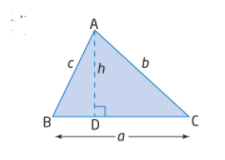
Consider an oblique triangle ABC, draw an altitude AD⊥BC and let AD=h.
Now, in △ABD, sinB=h/c⇒h=csinB
And in △ACD, sinC=h/b⇒h=bsinC
From the above equations, we can say that the given statement is true as the ratio of sine of an angle to the length of its opposite side is constant.
Thus, we can conclude that the given statement is true as the ratio of sine of an angle to the length of its opposite side is constant.
Read and Learn More Precalculus Textbook Mcgraw Hill Answers
Page 100 Problem 2 Answer
To draw: an oblique triangle and label them.
Draw a triangle which is not a right triangle and name it as △ABC with sides as a,b,c. Then draw an altitude from B to AC and let its height be h.
Thus, the required triangle be

Hence, the required traingle is
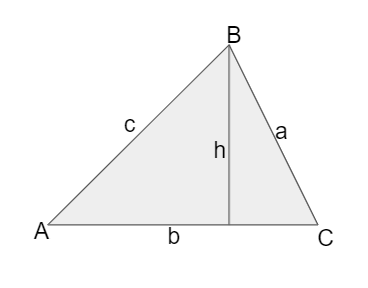
Page 101 Problem 3 Answer
To write: the trignometric ratio for sinA and sinC and determine how are two equations are same.
Summary: we will first consider two right triangles in one oblique triangle and then write the trignometric ratio.
Precalculus Textbook Mcgraw Hill Answers
Consider the figure as,
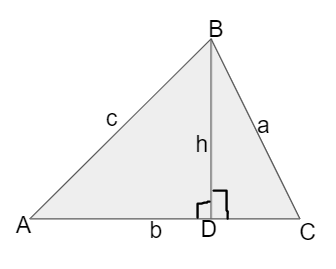
Now, in △BAD,sinA=h/c
And in △BCD,sinC=h/a
Thus, we can say that both the equations for sinA and sinC are equal to the ratio of length of the opposite side that is altitude and the hypotenuse.
Hence, we can conclude that both the equations are equal to the ratio of length of the opposite side that is altitude and the hypotenuse.
Page 101 Problem 4 Answer
To eliminate: h from both the equations and form one equation.
From step 4, we have, h=c sin A and h=asinC.
We can relate both the above equations as they are equal to h as follows,
C sin A =a sin C
Thus, the required equation is csin A=asinC.
Page 101 Problem 5 Answer
To divide: the equation in step 5(a) by ac.
The equation obtained in step 5(a) is c sinA=asinC.
On dividing both the sides of the equation by ac, we get,
⇒csinA
⇒csinA
ac⇒sinA
a=asinC
=asinC/ac
=sinC/c
Hence, the equation becomes sinA/a=sinC/c.
Page 104 Problem 6 Answer
Given: The measures of ∠L=64∘,l=25.2cm,m=16.5cm.
To determine: the measure of ∠N.
Summary: WE will first sketch the diagram of the triangle LMN and then we will use the sine law to find the measure of the ∠M and then we will use the angle sum property to find the remaining angle.
Precalculus Textbook Mcgraw Hill Answers
Consider the diagram of the △LMN,

Use the sine law to determine the measure of ∠M
⇒sinM/m
⇒sinM
⇒sinM
⇒M
⇒M
=sinL/l=sin(64∘)(16.5)/25.2
=0.5884
=sin−1/(0.5884)≈36∘
Use the angle sum property to find the measure of the ∠N
⇒∠N
=180∘−(36∘+64∘)
=180∘−100∘
=80∘
Hence, therequired measure of the ∠N=80∘.
Page 107 Problem 7 Answer
Given:∠A=39∘ and sides a=14cm , b=10cm
We have to find the value of ∠B,∠C and side c.
Apply sine law to find the remaining angles and sides of ΔABC.
First find the value of ∠B with the help of sinA/a=sinB/b.
Substitute 14 for a, 10 for b and 39∘
for A into sinA/a=sinB/b.
sin39∘/14 =sinB/10
Simplify further by multiplying 10 both side.
sin39∘/14×10=sinB/0.63
14×10=sinB
0.4495≈sinB
Simplify further to find the value of B.
Precalculus Textbook Mcgraw Hill Answers
sin−1/(0.4495)=B
26.71≈B
So ∠B=27∘, to the nearest degree.
Now use angle sum property to find the value of ∠C.
∠A+∠B+∠C=180∘
39∘+27∘+∠C=180∘
∠C=180∘−39∘−27∘
∠C=114∘
Substitute ∠A=39∘,∠C=114∘ and a=14 into sinA
a=sinC/c.
sin39∘/14=sin114∘/c
Simplify further to find the value of c.
c=sin114/sin39∘/14
c≈20.32
So, c=20,to the nearest unit.
Therefore, the values of remaining angles and sides of ΔABC are ∠B=27∘,∠C=114∘ and c=20cm.
Page 108 Problem 8 Answer
Given:a/sin35∘=10/sin40∘
we have to find the value of side a.
Multiply sin35∘ both side of a/sin35∘=10/sin40∘.
A/sin35∘×sin35∘=10
sin40∘×sin35∘/a=10
sin40∘×sin35∘/a≈8.92
So, a=8.9, to the nearest number.
Therefore, the value of side a=8.9.
Page 108 Problem 9 Answer
Given: b/sin48∘=65/sin75∘
We have to find the value of side b.
Multiply sin48∘both side of b/sin48∘=65/sin75∘.
B/sin48∘×sin48∘=65
sin75∘×sin48∘b=65
sin75∘×sin48∘b=50.0 therefore, the value of side b=50.0.
Precalculus Textbook Mcgraw Hill Answers
Page 108 Problem 10 Answer
Given: sinθ/12=sin50∘/65
we have to find the value of θ.
Multiply 12 both side of sinθ12=sin50∘/65.
Sinθ/12×12=sin50∘
65×12sinθ=sin50∘×12
65/sinθ=0.1414
θ=sin−1/(0.1414)
θ=8.13∘
So, θ=8∘, to the nearest unit.
Therefore, the value of θ=8∘.
Page 108 Problem 11 Answer
Given: sinA/25=sin62∘/32
we have to find the value of angle A.
Multiply 25 both side of sinA/25=sin62∘/32.
sinA/25×25=sin62∘/32×25
sinA=sin62∘/32×25
A=sin−1/(sin62∘32×25)
A=43.6∘
So, A=44∘, to the nearest number.
Therefore, the value of angle A=44∘.
Page 108 Problem 12 Answer
Given triangle ABC with ∠A=35o ,∠B=88o, AC=44 m
We have to find the length of side AB.
In given triangle ∠A=35∘ ,∠B=88∘.Subtract given angles from the sum of all angles of triangle, 180∘ to obtain the ∠C.
∠C=180∘−35∘−88∘
∠C=57∘
Using sine formula a/sin A=b/sin B=c/sin C
Substitute 88∘ for B, 57∘ for C and 44 for b into last two fractions, that is b/sinB=c/sinC.
44/sin88∘=c/sin57∘
c=sin57∘×44/sin88
c=0.838×44/0.999
c=36.90m
Hence length of side AB = 30.90m
Precalculus Textbook Mcgraw Hill Answers
Page 108 Problem 13 Answer
Given triangle ABC with ∠A=52o ,∠C=118o, CB=45 m
We have to find the length of side AB.
In given triangle, ∠A=52o ,∠C=118o, CB=45 m
Using sine formula a/sin A=b/sin B=c/sin C
Substitute 52∘ for A, 118∘ for C and 45 for a into last two fractions, that is a/sin A=c/sin C.
45/sin52∘=c/sin118∘
c=sin118∘×45sin52∘
c=0.882×45/0.788
c=50.36m
Hence length of side AB = 50.36m
Page 108 Problem 14 Answer
In the given triangle ABC,∠B=62o, AB=28 m, AC=31 m.We have to find the angle of ∠C .
Given triangle ABC with ∠B=62o, AB=28 m, AC=31 m .Using sine formula a/sinA=b/sinB=c/sinC.
Substitute 62∘ for B, 28 for c and 31 for b into last two fractions, that is b/sin B=c/sin C and solve to get the result.
31/sin62∘=28/sinC
sinC=sin62∘×28/31
sinC=0.882×28/31
sinC=0.796
C=sin−1/(0.796)
C=52.75∘
So, C=53∘to the nearest unit.
Therefore, the value of ∠C=53∘
Page 108 Problem 15 Answer
In the given triangle ABC, ∠B=98o, AC=17.5 m, BC=15 m.We have to find the angle of ∠A.
In the given triangle ABC, ∠B=98o, AC=17.5 m, BC=15 m.Using sine formula, a/sinA=b/sinB=c/sinC.Substitute 98∘
for B, 17.5 for b and 15 for a into first two fractions, that is a
sinA=b/sinB.
15/sinA=17.5/sin98∘
sinA=sin98∘×15/17.5
sinA=0.99×15/17.5
sinA=0.848
A=sin−1/(0.848)
A=57.994∘
So, A=58∘to the nearest unit.
Therefore, the value of ∠A=58∘
Precalculus Textbook Mcgraw Hill Answers
Page 108 Problem 16 Answer
In the given triangle ABC, ∠B=67o, AB=13 m, AC=12 m
We have to find ∠A, ∠C and BC.
In the given triangle ABC, ∠B=67o, AB=13 m, AC=12 m.
Using sine formula, a/sinA=b/sinB=c/sinC.Substitute 67∘
for B, 13 for c and 12 for b into last two fractions, that is b/sinB=c/sinC and solve to get ∠C.
12/sin67∘=13/sinC
sinC=13×sin67∘/12
sinC=13×0.92/12
sinC=0.996
C=sin−1/(0.996)
C=84.873∘
So, ∠C=85∘ to the nearest unit.
Use the total sum of all angles of a triangle are equal to 180∘, that is ∠A+∠B+∠C=180∘.Substitute 67∘
for ∠B and 85∘ for ∠C into ∠A+∠B+∠C=180∘ and solve to obtain ∠A.
∠A+67∘+85∘=180∘
∠A=180∘−67∘−85∘
∠A=28∘
Use sine formula, a/sinA=b/sinB=c/sinC to determine the length of BC.Substitute 28∘
for A, 67∘ for B and 12 for b into first two fractions, that is a/sinA=b/sinB.
A/sin28∘=12/sin67∘
a=12×sin28∘
sin67∘a=12×0.469/0.92
a=6.117
So, a=6.1 m to the nearest unit.
Hence , ∠A=28∘, ∠C=85∘ and the length of side BC=6.1 m.
Page 108 Problem 17 Answer
In given figure ∇ABC, ∠A=42˚ , ∠B=84˚ , AC = 50m
we have to find ∠C , AB and BC.
Let BC = a , AC = b and AB = c
∵ ∠A+∠B+∠C=180˚
⇒42˚+84˚+∠C=180˚
⇒∠C=180˚−42˚−84˚
⇒∠C=180˚−126˚
⇒ ∠C=54˚
Using sine law ,A/sinA=b/sinB
⇒a/sin42˚
=50/sin84˚
⇒a=50×sin42˚
sin84˚⇒a=50×0.6691/0.9945
⇒a = 33.6 m
Again , using sine law ,
B/sinB=c/sinC ⇒50
sin84˚=c
sin54˚ ⇒c=50×sin54˚
sin84˚⇒c=50×0.8090/0.9945
⇒c=40.67 or , c = 40.7 m
Hence , ∠C=54˚ and the length of sides AB = 40.7 m and BC = 33.6 m
Page 108 Problem 18 Answer
In given figure ΔABC,∠A=22˚ , ∠C=39˚ and side AC = 29mm
we have to find ∠B and sides AB and BC.
Let , BC = a , AC = b and AB = c
∵∠A+∠B+∠C=180˚
⇒22˚+∠B+39˚=180˚
⇒∠B=180˚−22˚−39˚
⇒∠B=180˚−61˚
∠B=119˚
By using sine law , A/sinA=b/sinB ⇒a/sin22˚
=29/sin119˚
⇒a=29×sin22˚/sin119˚
⇒a=29×sin22˚/sin(180˚−61˚)
⇒a=29×sin22˚/sin61˚
⇒a=29×0.3746/0.8746
⇒a=12.42 or , a = 12.4 mm
Again , by using sine law,
A/sinA=c/sinC
⇒12.4/sin22˚
=c/sin39˚
⇒c=12.4×sin39˚/sin22˚
⇒c=12.4×0.6293/0.3746
⇒c=20.83 or , c = 20.8 mm
Hence , ∠B=119˚ and the length of sides AB = 20.8 mm and BC = 12.4 mm.
Precalculus Textbook Mcgraw Hill Answers
Page 108 Problem 19 Answer
In give figure ΔABC ,∠A=48˚ ,∠C=61˚ and AC = 21cm
we have to find ∠B , AB and BC.
Let , BC = a , AC = b and AB = c
∵∠A+∠B+∠C=180˚
⇒48˚+∠B+61˚=180˚
⇒∠B=180˚−48˚−61˚
⇒∠B=180˚−109˚
⇒∠B=71˚
By using sine law ,
A/sinA=b/sinB ⇒a/sin48˚
=21/sin71˚⇒a=21×sin48˚
sin71˚ ⇒a=21×0.7431/0.9455
⇒a=16.5cm
Again , by using sine law ,
B/sinB=c/sinC ⇒21
sin71˚=c/sin61˚ ⇒c=21×sin61˚
sin71˚ ⇒c=21×0.8746/0.9455
⇒c=19.4cm
Hence , ∠B=71˚and length of sides BC = 16.5 cm and AB = 19.4 cm.
Page 108 Problem 20 Answer
In given ∇ABC , ∠A=57˚ ,∠B=73˚ and AB = 24 cm
firstly, sketch triangle ABC then, we will find the length of AC.

Sketching triangle ABC with ∠A=57˚ , ∠B=73˚ and AB = 24cm and AC =x cm
∵ ∠A+∠B+∠C=180˚
⇒57˚+73˚+∠C=180˚
⇒∠C=180˚−57˚−73˚
⇒∠C=180˚−130˚
∠C=50˚
Now , by using sine law
B/sinB=c/sinC ⇒x/sin73˚=24
sin50˚ ⇒x=24×sin73˚
sin50˚ ⇒x=24×0.9563/0.7660
⇒x=29.96
or x = 30cm
or AC = 30 cm
Hence , length of side AC = 30 cm
Page 108 Problem 21 Answer
In given ΔABC , ∠B=38˚ ,∠C=56˚ and BC = 63cm
firstly , sketch triangle ABC then , we have to find the length of AB .
Sketching triangle ABC with ∠B=38˚ , ∠C=56˚ and BC =63cm and AB = x cm
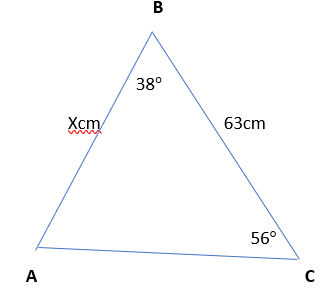
∵∠A+∠B+∠C=180˚ ⇒∠A+38˚+56˚=180˚
⇒∠A=180˚−94˚
⇒∠A=86˚
Now , by using sine law ,
A/sinA=c/sinC ⇒63
sin86˚=x/sin56˚ ⇒x=63×sin56˚
sin86˚ ⇒x=63×0.8290/0.9976
⇒x=52.35 or , x = 52.4 cm
Hence , length of side AB= 52.4 cm
Precalculus Textbook Mcgraw Hill Answers
Page 108 Problem 22 Answer
Given triangle ABC with ∠A=50 ,∠B=50 , AC=27m
We have to find the length of side AB.
In given triangle ∠A=500 ,∠B=500

Then ∠C=180∘−50∘−50∘
=800
Using sine formula A/sinA=b/sin B=c/sin C
From last two fractions
B/sinB=c/sin C
27/sin500=c/sin800
c= sin800×27/sin500
c= 0.984 ×27/0.766
c=34.68m
Hence length of side AB = 34.68m

Page 108 Problem 23 Answer
Given triangle ABC with ∠A=230, ∠C=780 , and AB =15 cm.
We have to find the length of side BC.

Since sum of all angles of triangle = 180
So ∠A+∠B+∠C=180
23+∠B+78 = 180
∠B= 180−101
∠B=790
Now using sine formula
A/sin A=b/sin B=c/sin C
Now using first and third fraction
A/sin230=15/sin780
a= 15×sin230/sin780
a= 15×0.390/0.978
a= 5.98cm
Hence a= length of side BC =5.98cm
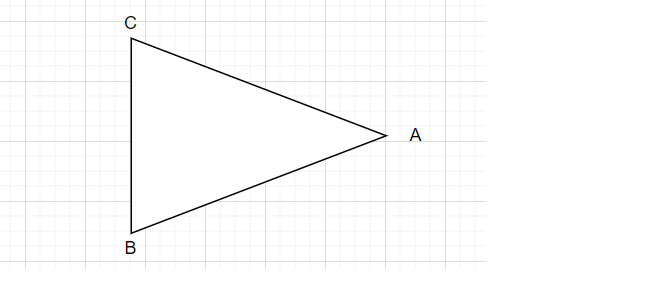
Page 108 Problem 24 Answer
Given triangle ABC ∠A=390 ,a= 10cm , b=14cm
We have to determine whether there is no solution, one solution, or two solutions.
Given ∠A=39∘ ,a= 10 , b=14
h= b sin A =14×sin390
=14×0.629
=8.810cm
Here angle A is acute angle and h<a<b
So according to result this triangle has two solutions .
Hence given triangle has two solutions .
Page 108 Problem 25 Answer
Given a triangle ABC with ∠A = 123,a =23 cm ,b= 12cm
We have to determine whether there is no solution, one solution, or two solutions.
Since here angle A is =123 which is obtuse angle and a>b
So according to result given triangle has one solution .
Hence given triangle has one solution .
Page 108 Problem 26 Answer
Given triangle ABC with ∠A=1450 , a =18 cm , b= 10 cm.
We have to determine whether there is no solution, one solution, or two solutions.
Since here angle∠A=145∘ is obtuse angle and a>b i.e 18>10
So according to result given relation has one solution .
Hence given triangle has one solution .
Page 108 Problem 27 Answer
Given triangle ABC with ∠A=124∘, a=1,b=2
We have to determine whether there is no solution, one solution, or two solutions.
Here the angle ∠A=124 is obtuse and a<b i.e, 1<2
So according to result given relation has no solution .
Hence given triangle has no solution.
Page 108 Problem 28 Answer
Given:

If h is an altitude. then how ∠A, sides a and b, and h are related
We have the diagram.

sinA=h/b
h=bsinA
Then, from the diagram, bsinA<a<b

Then, from the diagram, bsinA<a<b
Page 108 Problem 29 Answer
Given: In the diagram h is an altitude

To Describe how ∠A, sides a and b, and h are related in each diagram.
We have the diagram

sinA=h/b
h=bsinA
Then, from the diagram, bsinA<a<b.

Hence, from the diagram, bsinA<a<b.
Page 108 Problem 30 Answer
Given: In the diagram, h is an altitude

To Describe how ∠A, sides a and b, and h are related in each diagram.
We have the triangle

sinA=h/b
h=bsinA
Also, from the diagram, a=bsinA.
Hence, the ∠A, sides a and b, and h are related in the diagram as from the diagram, a=bsinA.

Page 108 Problem 31 Answer
Given: In each diagram, h is an altitude
To Describe how ∠A, sides a and b, and h are related in each diagram.
We have the triangle

So, sinA/h=h/b=bsinA
From the diagram, a≥b>bsinA

Hence, the ∠A, sides a and b, and h are related in the diagram as From the diagram, a≥b>bsinA

McGraw Hill Pre Calculus 11 Student Edition Chapter 2 Exercise 2.2 Trigonometry
Precalculus Textbook Mcgraw Hill Answers
Pre-Calculus 11 Student Edition Chapter 2 Trigonometry
Page 88 Problem 1 Answer
Given: Point A(3,4)
To find in which quadrant A lies

The point A(3,4) has the sign +ve for both abscissa and ordinate. Therefore, point lies in first Quadrant.
Therefore, the point A(3,4) lies in 1st quadrant.
Page 88 Problem 2 Answer
We need to draw the angle in standard position with terminal arm passing through point A(3,4).
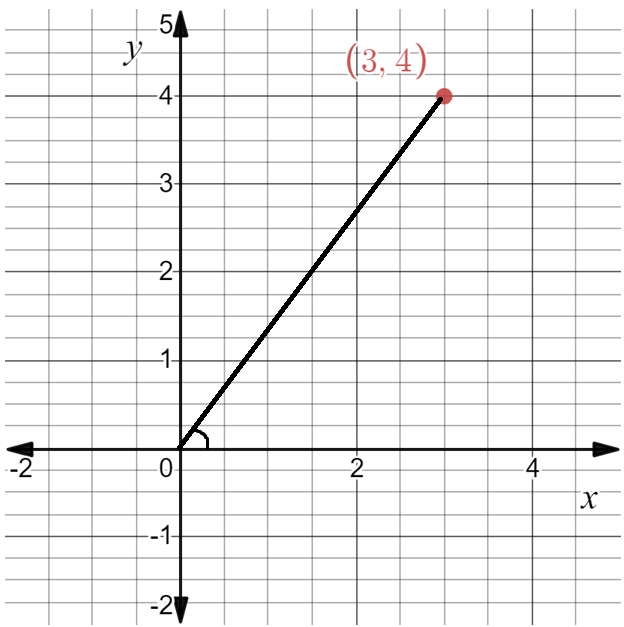
For this, draw a line segment from origin to the point A(3,4).
The angle is,
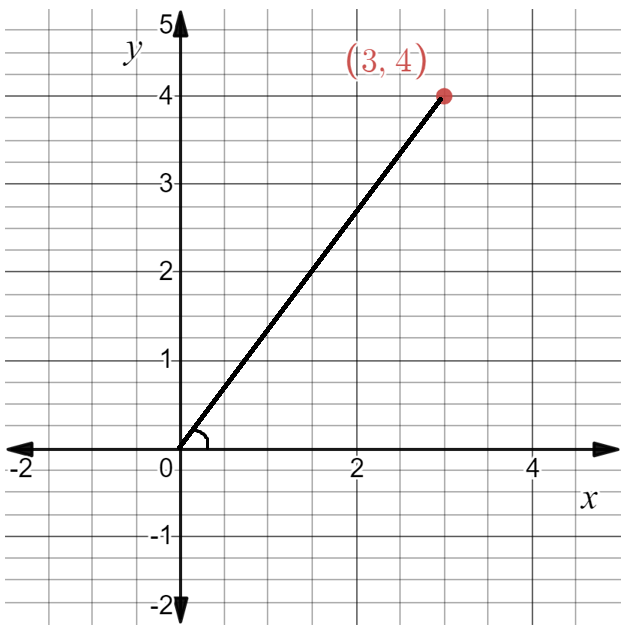
Page 89 Problem 3 Answer
Given that,

We need to describe how is each primary trigonometric ratio related to the coordinates of point A and the radius r.
For this, use the definition of primary trigonometric ratios in the right triangle.
Here,sinθ=4/5, cosθ=3/5 and tanθ=4/3.
So sine function is the ratio of y-coordinate of point A and r.
Cosine function is the ratio of x -coordinate of point A and r.
Read and Learn More Precalculus Textbook Mcgraw Hill Answers
Precalculus Textbook Mcgraw Hill Answers
Tangent function is the ratio of y-coordinate of point A and x-coordinate of point A.
Sine function is the ratio of y-coordinate of point A and r.
Cosine function is the ratio of x-coordinate of point A and r.
Tangent function is the ratio of y-coordinate of point A and x-coordinate of point A.
Page 89 Problem 4 Answer
Given point A has coordinates (3,4) and y-axis is the axis to be considered as mirror.
To find the reflection of the point A that means coordinates of point C.
The graph which reflect point A is as follows:
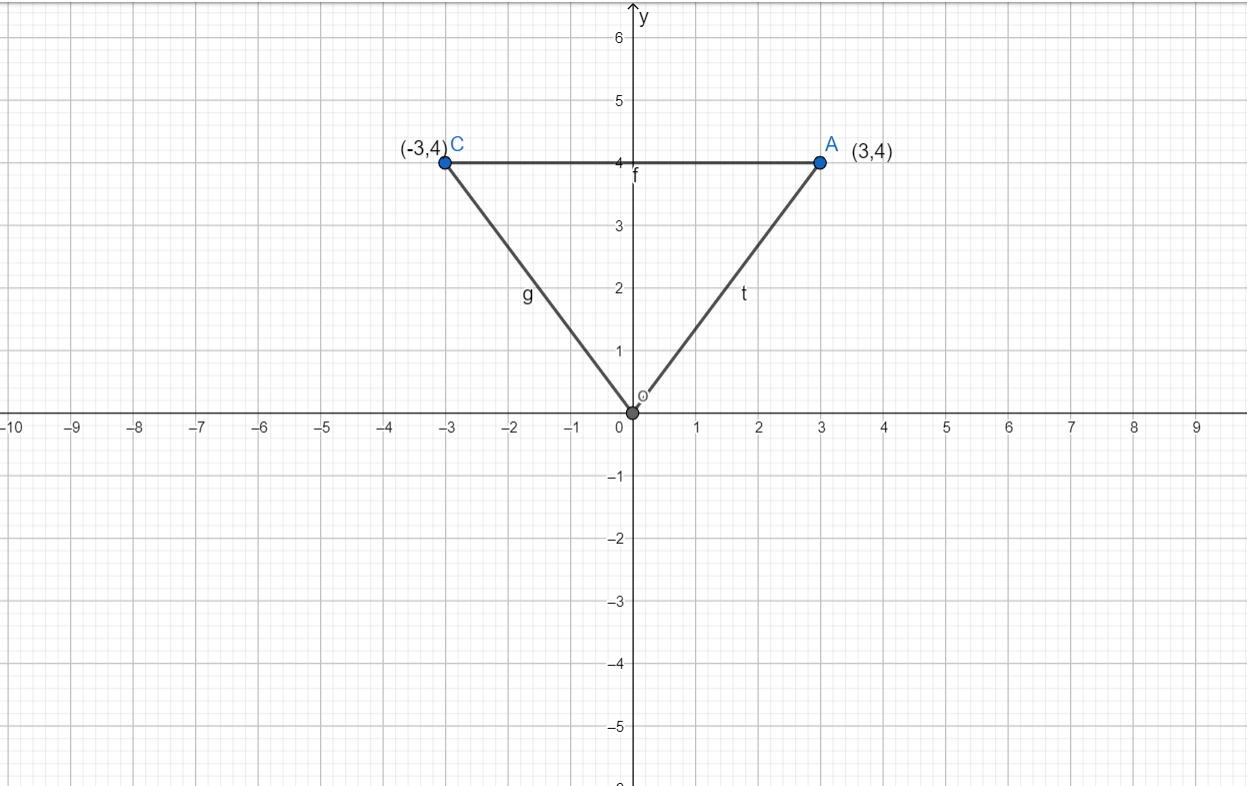
The coordinates of the point C considering Y-axis as a mirror will be(−3,4) as in 2nd quadrant x-coordinate is negative but y-coordinate is positive.
Therefore, the coordinates of point C are(−3,4)
Precalculus Textbook Mcgraw Hill Answers
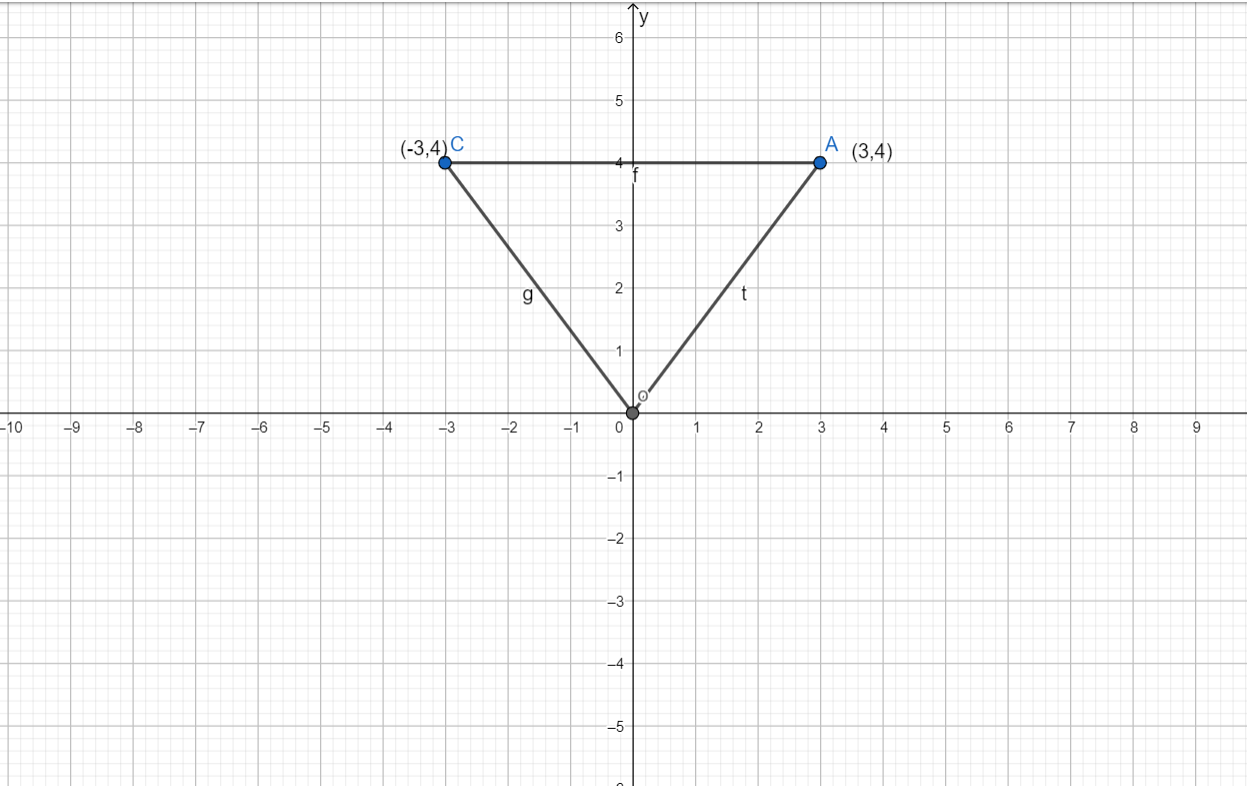
Page 89 Problem 5 Answer
Given Point A has coordinates (3,4) and point C has coordinate(−3,4).
Firstly we have to draw a perpendicular from point C to x-axis.
Then we have to find the trigonometric ratios for ∠COB
Primary Trigonometric ratios aresinθ=Perpendicular
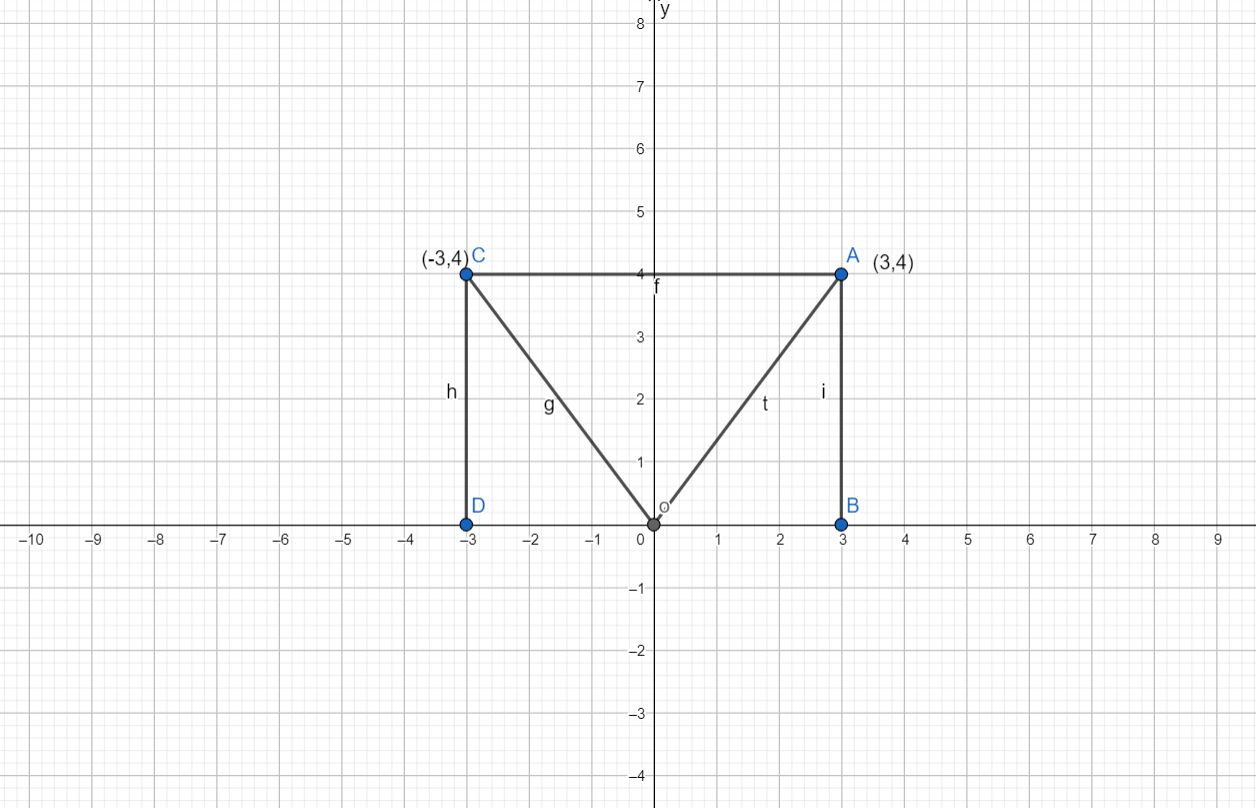
Hypotenuse=4/√52:cos θ=Base/Hypotenuse=−6/√52:tanθ=Perpendicular/Base=−4/6=−2/3
Therefore, the trigonometric ratios are 4/√52,−6/√52,−2/3

Page 89 Problem 6 Answer
We know that the x-axis has a total angle of 180°.
Now, COD clearly forms a right angle triangle that means ∠COD=45°
So,∠COD+∠COB=180⟹45°+∠COB=180
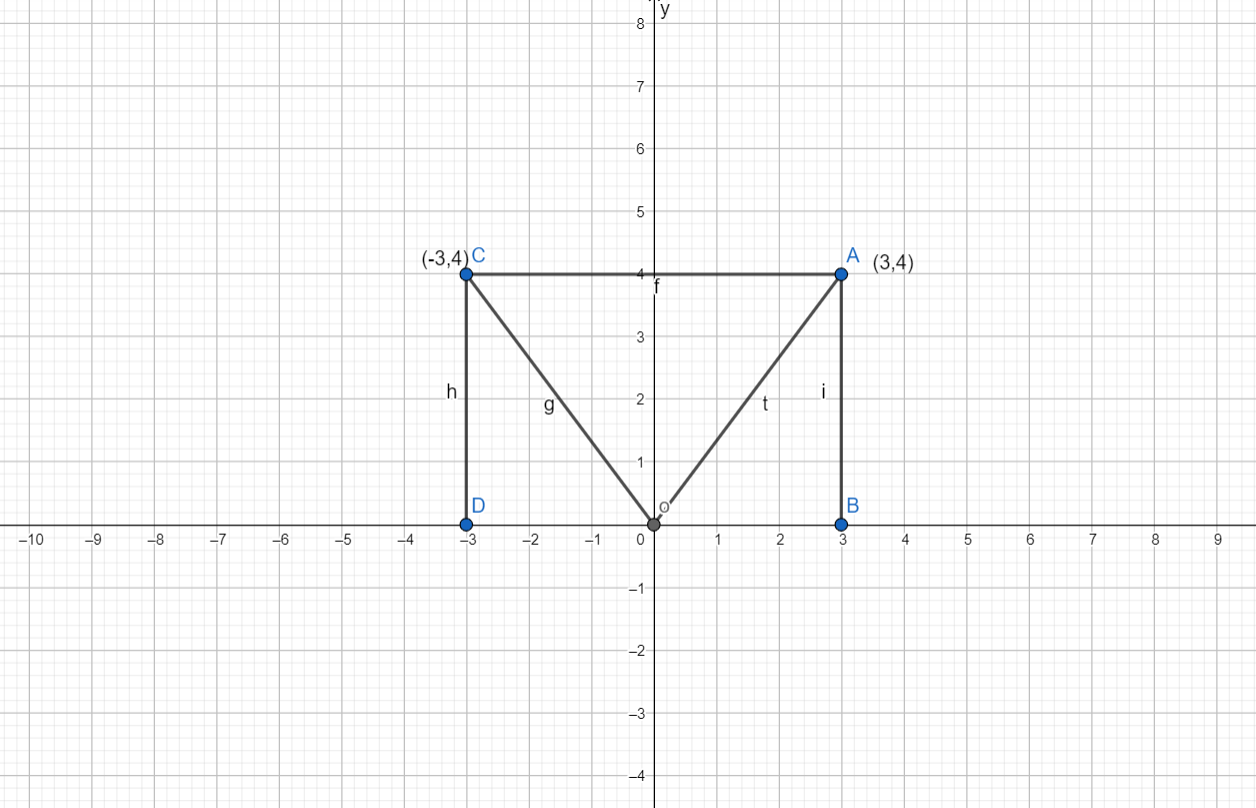
∠COB=180°−45°=135°
Therefore, measure of ∠COB is 135°.
Page 89 Problem 7 Answer
The angles∠COB and∠COD lie on the same axis( x-axis) and their sum is 180°.
The angles represent linear pair angles.
Precalculus Textbook Mcgraw Hill Answers
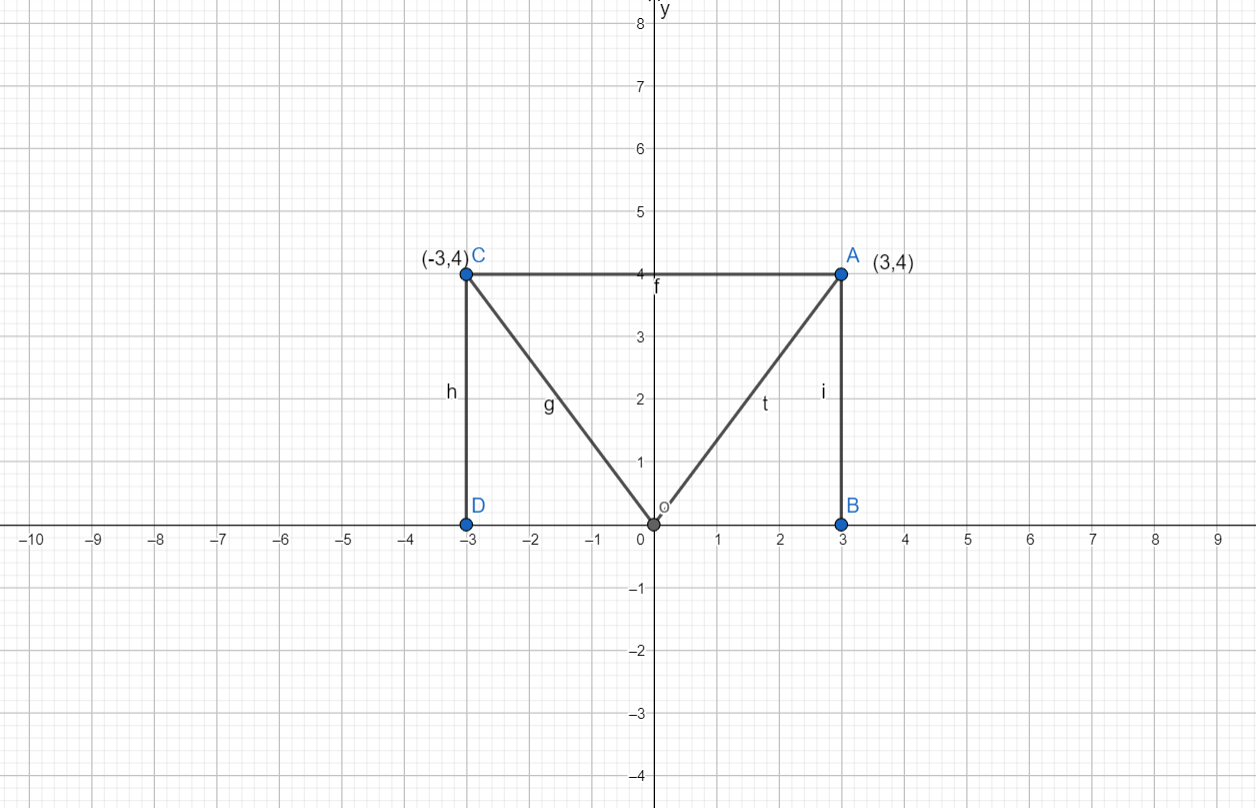
Therefore, the angles COB AND COD are Linear pair angles.
Page 91 Problem 8 Answer
Given: The point P(−5,−12) lies on the terminal arm of an angle, θ, in standard position
To find: The exact trigonometric ratios for sinθ,cosθ,tanθ
Plot the given point on a graphJoin the point with the origin to get the terminal arm of the required angle
Get the reference angleEvaluate the trigonometric ratios using the sides of the right-angled triangle formed
The given situation can be modelled as,
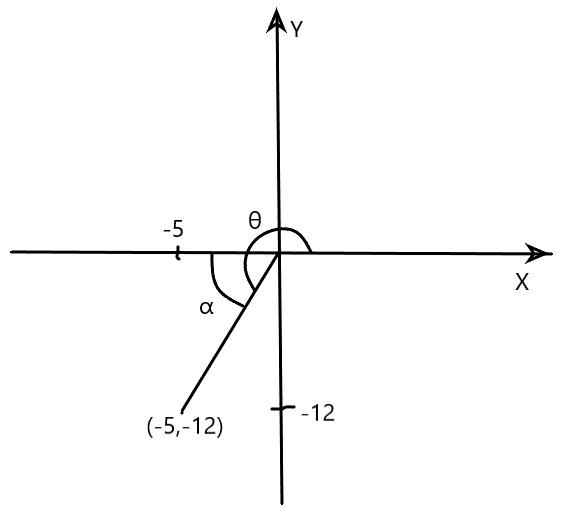
Now, consider the right-angled triangle formed by the origin, the given point and the point (−5,0).
Using the definitions of the trigonometric ratios in a right-angled triangle, we have,
sinα=perpendicular/hypotenuse
=12/√122+52
=12/√144+25
=12/√169
=12/13
cosα=base/hypotenuse=5/√122+52
=5/√144+25
=5/√169
=5/13
tanα=perpendicular/base
=12/5
Mcgraw Hill Precalculus Textbook Answers
Now, from the figure, it is clear, θ=π+α
Then,
sinθ=sin(π+α)=−sinα=−12/13
cosθ=cos(π+α)=−cosα=−5/13
tanθ=tan(π+α)=tanα=12/5
So, sin θ=−12/13,cos θ=−5/13,tanθ=12/5
It has been found that sin θ=−12/13,cos θ=−5/13,tanθ=12/5
Page 92 Problem 9 Answer
Given: θ is an angle in quadrant III and tanθ=1/5
To find: The exact values of sin θ, cos θ
Since θ is an angle in quadrant III, sin θ<0, cos θ<0
Use the trigonometric identities to find the exact value of sinθ,cosθ
Given: tanθ=1/5
We have, the trigonometric identity,
sec2 θ=1+tan2θ
Put tanθ=1/5 in the above identity to get,
sec2θ=1+(1/5)2 ⇒sec2
θ=1+1/25⇒sec2
θ=26/25⇒1/cos2θ
=26/25
⇒cos2θ=25/26
⇒cos θ=−5/√26 (Since cos θ<0)
Now, we have the identity,
Mcgraw Hill Precalculus Textbook Answers
sin2θ+cos2θ=1
Put cos2θ=25/26 in the above identity to get,
sin2θ+25/26=1
⇒sin2θ=1−25/26
⇒sin2θ=1/26
⇒sin θ=−1/√26 (Since sin θ<0)
So, sin θ=−1/√26 ,cos θ=−5/√26
It has been found that sin θ=−1/√26,cos θ=−5/√26
Page 93 Problem 10 Answer
Given: A figure representing the angles 0°,90°,180°,270°
To find the sine, cosine and tangent values of these angles from the given figureIn a right angled triangle, the trigonometric ratios are ratios of lengths of its sides
For sin: sin0°=0,sin180°=0,sin270°=−1

For cos:cos0°=1,cos180°=−1,cos360°=1
For tan:tan0°=0:tan180°=0:tan360°=0

Page 94 Problem 11 Answer
Given,sin θ=−1/√2,0°<θ<360°
To find the value of θ which satisfies the equation.
We know that the value of sin is negative in 3rd and 4th quadrant.
Also,sin45°=1/√2
So, sin(180+45)°=−1/√2=sin225° and sin(360−45)°=−1/√2=sin315°
Therefore,θ=225°,315° considering 0°<θ<360°
Therefore the value of θ is 225°,315°.
Mcgraw Hill Precalculus Textbook Answers
Page 96 Problem 12 Answer
We need to sketch the angle in standard position so that the terminal arm passes through the point (2,6).
The point (2,6) lies in first quadrant so that the terminal arm is in first quadrant.
Plot the point A(2,6) on the graph.
Draw the line joining the point A(2,6) to the origin O. This is the terminal arm.
The line from origin to the positive x-axis the initial arm.
The sketch of the angle in standard position is:

The sketch of angle in standard position so that the terminal arm passes through the point (2,6) is –
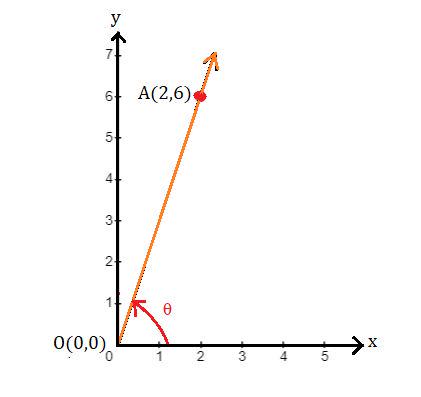
Page 96 Problem 13 Answer
We need to sketch the angle in standard position so that the terminal arm passes through the point (−4,2).
The point (−4,2) lies in second quadrant, so that the terminal arm will be in second quadrant.
Plot the point A(−4,2) on the graph.
Mcgraw Hill Precalculus Textbook Answers
Join point (−4,2) with the origin, so that the line obtained will be the terminal arm.
The line from origin to the positive x-axis is the initial arm.
The sketch of angle in standard position is:
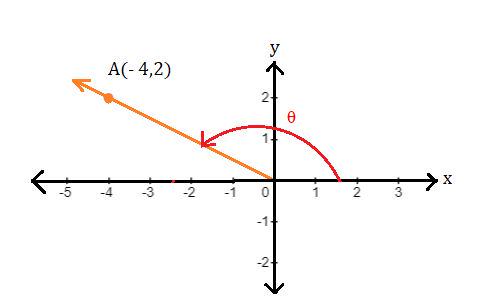
The sketch of angle in standard position so that the terminal arm passes through the point (−4,2) is:

Page 96 Problem 14 Answer
We need to sketch the angle in standard position so that the terminal arm passes through the point (−5,−2).
The point (−5,−2) lies in third quadrant, so that the terminal arm will be in third quadrant.
Plot the point A(−5,−2) on the graph.
Join the point(−5,−2) with the origin, so that the line obtained will be the terminal arm.
The line from origin to the positive x-axis is the initial arm.
Mcgraw-Hill Textbook Answers
The sketch of angle in standard position is:

The sketch of angle in standard position so that the terminal arm passes through (−5,−2) is:
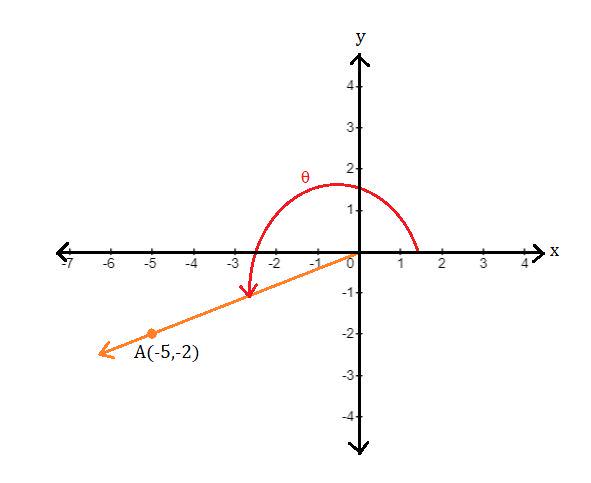
Page 96 Problem 15 Answer
We need to sketch the angle in standard position so that the terminal arm passes through the point (−1,0).
The point (−1,0) lies on negative x-axis, so that the terminal arm will be on negative x-axis.
Plot the point A(−1,0) on the graph, so that we get the terminal line through A(−1,0).
The line from origin to the positive x-axis is the initial arm.
Mcgraw-Hill Textbook Answers
The sketch of angle in standard position is:
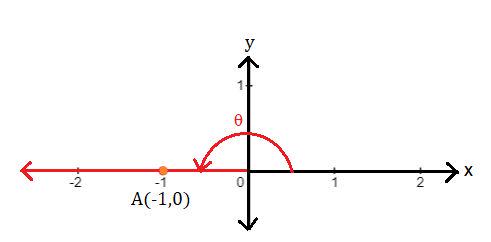
The sketch of angle in standard position so that the terminal arm passes through the point (−1,0) is:
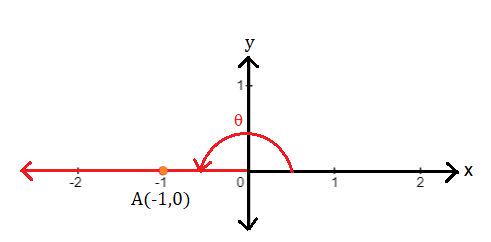
Page 96 Problem 16 Answer
Given figure is as follows –

We have to find out the sine, cosine, and tangent of the given angles.
Given angle is as follows –
Θ=60∘,cos(60∘)=1/2, =0.5,sin(60∘)=√3/2, =0.866,
tan(60∘)=√3, =1.73210,
Mcgraw-Hill Textbook Answers
So, the exact values of the sine, cosine, and tangent ratios are 0.866,0.5, and, 1.73210.
Page 96 Problem 17 Answer
Given figure is as follows –

We have to find out the sine, cosine, and tangent of the given angles.
Given angle is as follows –
Θ=225∘,cos(225∘)=cos(180∘+45∘), =−cos(45∘), =−1/√2, =−0.707,
sin(225∘)=sin(180∘+45∘), =−sin(45∘), =−1/√2, =−0.707,
tan(225∘)=tan(180∘+45∘), =tan(45∘), =1.
So, the exact values of the sine, cosine, and the tangent of the given angle is −0.707,−0.707, and, 1 respectively.
Page 96 Problem 18 Answer
Given figure is as follows –

We have to find out the sine, cosine, and tangent of the given angles.
Given angle is as follows –
Θ=150∘,cos(150∘)=cos(180∘−30∘), =−cos(30∘), =−√3/2, =−0.866,
sin(150∘)=sin(180∘−30∘), =sin(30∘), =1/2, =0.5,
tan(150∘)=tan(180∘−30∘), =−tan(30∘), =−1/√3, =−0.577.
So, the sine, cosine, and, the tangent of the given angle is 0.5,−0.866, and, −0.577.
Page 96 Problem 19 Answer
Given figure is as follows –

We have to find out the sine, cosine, and tangent of the given angles.
Given angle is as follows –
Θ=90∘,
cos(90∘)=0,
sin(90∘)=1,
tan(90∘)=∞.
So, the sine, cosine, and the tangent of the given angle is 1,0, and, ∞.
Precalculus Glencoe Answers
Page 96 Problem 20 Answer
Given figure is as follows –

We have to find out the sine, cosine, and tangent of the given angles.
Given angle is as follows –
sinΘ=Perpendicular
Hypotenuse,
=4/√32+42,
=4/5,
=0.8,
cosΘ=Base/Hypotenuse,
=3/√32+42,
=3/5,
=0.6.
tanΘ=Perpendicular/Base,
=3/4,
=0.75.
So, the sine, cosine, and, the tangent of the given angle is 0.8,0.6, and, 0.75.
Page 96 Problem 21 Answer
It is given that
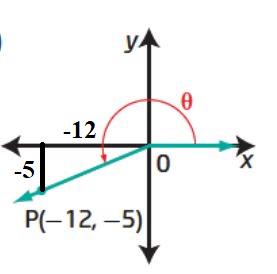
Then we need to find exact trigonometric ratios sin θ,cos θ&tanθ for each.
Sketch the reference triangle by drawing a line perpendicular to the x-axis through the point (-12, -5).
The point P(-12, -5) is in quadrant III, so the terminal arm is in quadrant III.
Precalculus Glencoe Answers
Use the Pythagorean Theorem to determine the distance,r, from P(-12, -5) to the origin, (0, 0).
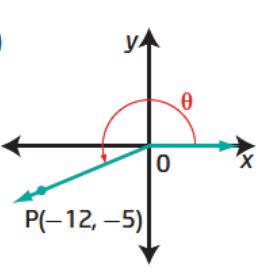
Pythagorean Theorem
r=√x2+y2
r=√(−12)2+(−5)2
r=√144+25
r=√169
r=13
The trigonometric ratios for θ can be written as follows:
Sin θ=opposite/hypotenuse
=−5/13
Cos θ=adjacent/hypotenuse
=−12/13
=−12/13
tanθ=opposite/adjacent
=−5/−12
=5/12
The answer is sin θ=−5/13 cos θ=−12/13 tanθ=5/12
Precalculus Glencoe Answers
Page 96 Problem 22 Answer
It is given that
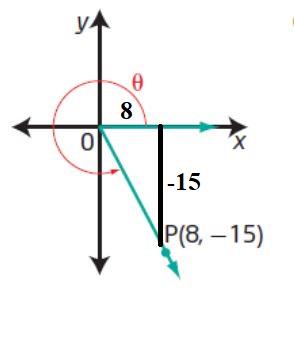
Then we need to find exact trigonometric ratios sin θ,cos θ&tan θ for each.
Sketch the reference triangle by drawing a line perpendicular to the x-axis through the point (8, -15).
The point P(8, -15) is in quadrant IV, so the terminal arm is in quadrant IV.
Use the Pythagorean Theorem to determine the distance,r, from P(-12, -5) to the origin, (0, 0).

Pythagorean theorem
r=√x2+y2
r=√(8)2+(−15)2
r=√64+225
r=√289
r=17
The trigonometric ratios for θ can be written as follows:
Sin θ=opposite/hypotenuse
=−15/17
=−15/17
Cos θ=adjacent/hypotenuse
=8/17
tanθ=opposite/adjacent
=−15/8
=−15/8
The answer is sin θ=−15/17
Precalculus Glencoe Answers
Cos θ=8/17
tanθ=−15/8
Page 96 Problem 23 Answer
It is given that
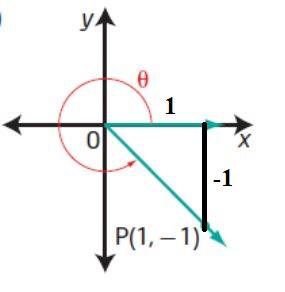
Then we need to find exact trigonometric ratios sin θ,cos θ & tan θ for each.
Sketch the reference triangle by drawing a line perpendicular to the x-axis through the point (1, -1).
The point P(1, -1) is in quadrant IV, so the terminal arm is in quadrant IV.
Use the Pythagorean Theorem to determine the distance,r, from P(1, -1) to the origin, (0, 0).

Pythagorean theorem
r=√x2+y2
r=√(1)2+(−1)2
r=√1+1
r=√2
The trigonometric ratios for θ can be written as follows:
Sin θ=opposite/hypotenuse
=−1/√2
=−1/√2
Cos θ=adjacent/hypotenuse
=1/√2
tanθ=opposite/adjacent
Precalculus Glencoe Answers
=−1/1
=−1
The answer is
Sin θ=−1/√2
Cos θ=1/√2
tanθ=−1
Page 96 Problem 24 Answer
It is given that cos θ<0 and sin θ>0.
Then we need to find the quadrant in which the terminal arm of angle θ lie.
We know that
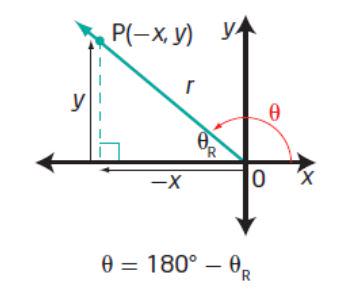
Sin θ=opposite/hypotenuse=y/r>0
Cos θ=adjacent/hypotenuse=−x/r=−x/r<0
Hence terminal arm will lie in second (II) quadrant.
The terminal arm will lie in the second (II) quadrant.
Page 96 Problem 25 Answer
It is given that cos θ>0 and tan θ>0.
Then we need to find the quadrant in which the terminal arm of angle θ lie.
We know that

Cos θ=adjacent/hypotenuse=x/r=x/r>0
tanθ=opposite/adjacent=y/x>0
Hence terminal arm will lie in first (I) quadrant.
The terminal arm will lie in the first (I) quadrant.
Page 96 Problem 26 Answer
Given: sin θ<0 and cos θ<0
To specify that For each description, in which quadrant does the terminal arm of angle θ lie
We have sin θ<0 and cos θ<0
So the sine ratio and the cosine ratio are both negative in quadrant III.
Hence, the terminal arm of angle θ lie in quadrant III
Page 96 Problem 27 Answer
Given: tan θ<0 and cosθ>0
To specify that For each description, in which quadrant does the terminal arm of angle θ lie.
We have tan θ<0 and cos θ>0
So the tangent ratio is negative and the cosine ratio is positive in quadrant IV.
Hence, the terminal arm of angle θ lie in quadrant IV
McGraw Hill Pre Calculus 11 Student Edition Chapter 2 Exercise 2.1 Trigonometry
Pre-Calculus 11 Student Edition Chapter 2 Trigonometry
Page 75 Problem 1 Answer
Given that: Group A angles are in Standard Position.
Whereas, Group B angles are not in Standard Position.
Difference between Group A and Group B angles is as follows :
- All angles of Group A have their vertex located at the origin and one ray is on the positive x-axis.
- Whereas, no angle in Group B have their one ray on positive x-axis.
Characteristics of angles in Standard Position are :
1. An angle is in standard position if its vertex is located at the origin. And
- one ray is on the positive x-axis.
An angle which satisfies both the conditions is known as angle in Standard Position.
Difference between Group A and Group B angles is as follows :
- All angles of Group A have their vertex located at the origin and one ray is on the positive x-axis.
- Whereas, no angle in Group B have their one ray on positive x-axis.
Characteristics of angles in Standard Position are :
1. An angle is in standard position if its vertex is located at the origin. And
- one ray is on the positive x-axis.
An angle which satisfies both the conditions is known as angle in Standard Position.
Read and Learn More Precalculus Textbook Mcgraw Hill Answers
Page 75 Problem 2 Answer
The correct option is option B
The reason for the same is :
- The vertex is located at origin.
- One ray is on positive x-axis.
For other options, we have
Option A: The vertex is not located at origin.
Option C: no ray lies on positive x-axis.
The correct option is Option B as it satisfies all the conditions of angle in standard position.
Mcgraw Hill Precalculus Textbook Answers
Page 75 Problem 3 Answer
Given Angle to be drawn 750,

Steps to draw:
- Create a line segment on x-axis.
- Put a proctor with center on (0,0)and aligned to the x-axis and see where the angle of 750lies.
- The terminal arm of angle lies in first quadrant as the angle is an acute angle.
The graph for the same looks as follows:
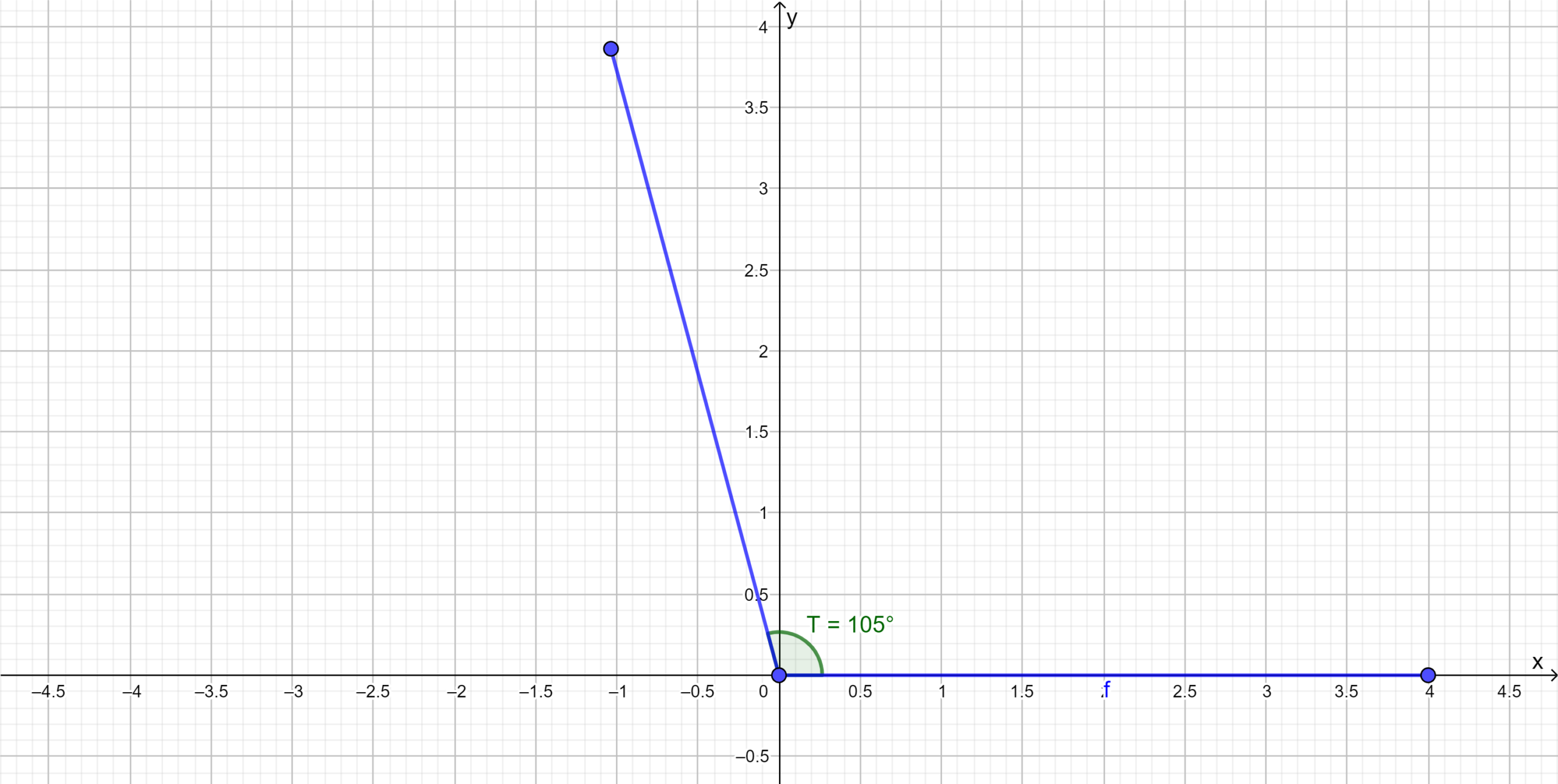
Given Angle to be drawn 1050
Steps to draw:
- Create a line segment on x-axis.
- Put a proctor with center on (0,0),and aligned to the x-axis and see where the angle of lies.
- The terminal arm of angle lies in second quadrant.
The graph for the same looks as follows:
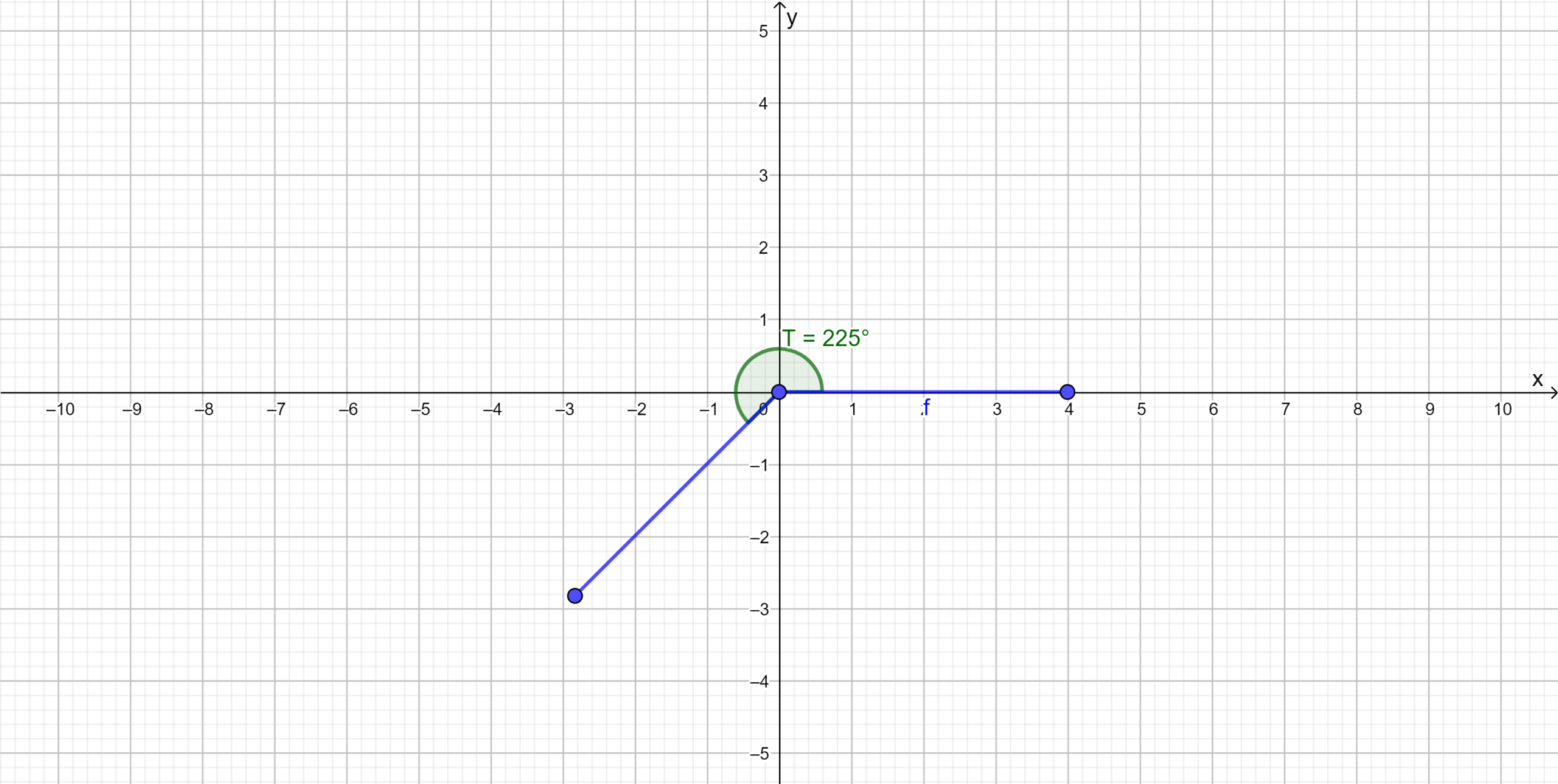
Given Angle to be drawn 2250
Steps to draw:
- Create a line segment on x-axis.
- Put a proctor with center on (0,0),and aligned to the x-axis and see where the angle of lies.
- We will put the proctor upside down and mark at 450starting from third quadrant
- The terminal arm of angle lies in third quadrant .
Mcgraw Hill Precalculus Textbook Answers
The graph for the same looks as follows:
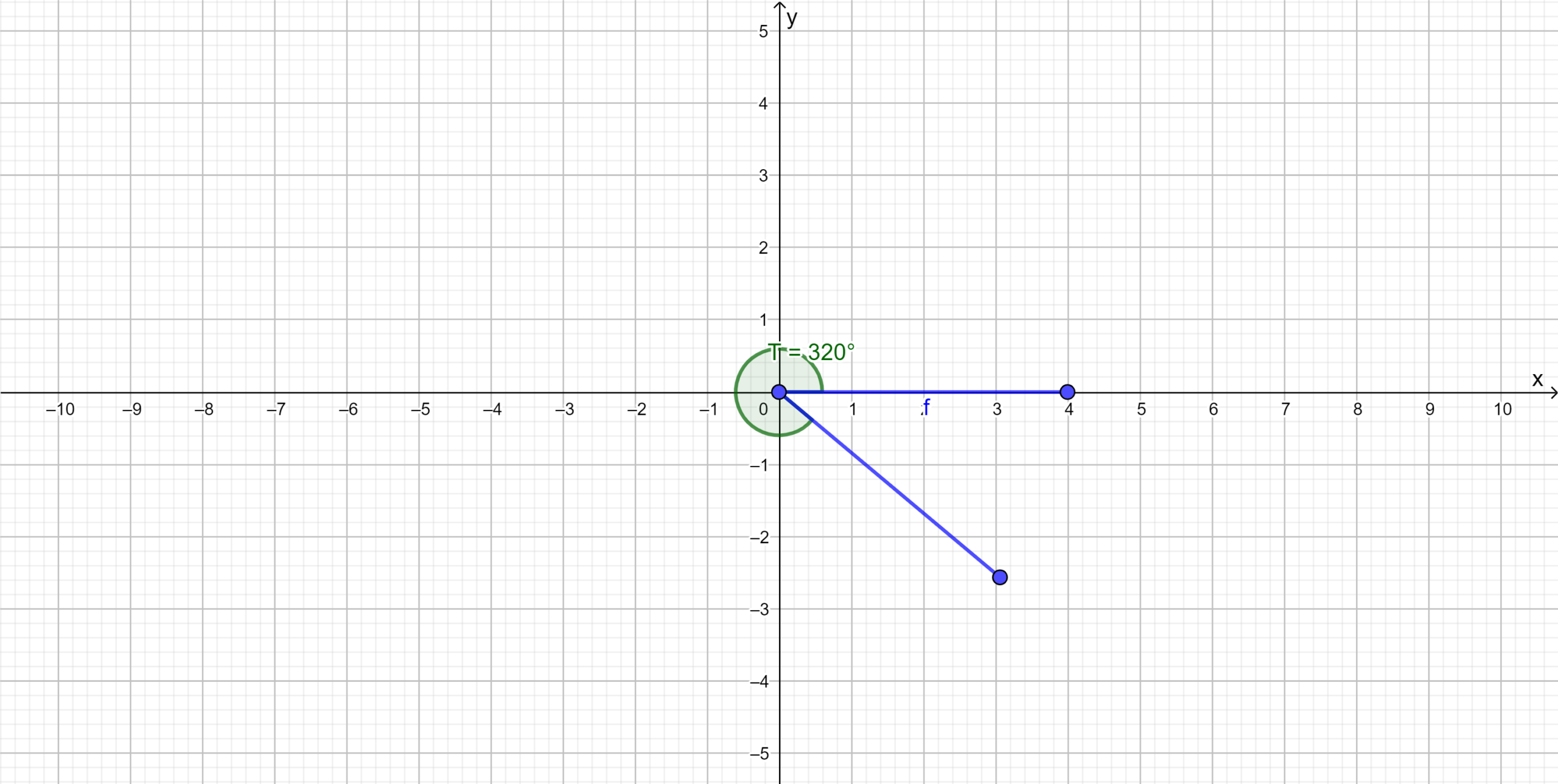
Given Angle to be drawn 3200
Steps to draw:
- Create a line segment on x-axis.
- Put a proctor with center on (0,0),and aligned to the x-axis and see where the angle of lies.
- We will put the proctor upside down and mark at 400starting from fourth quadrant.
- The terminal arm of angle lies in fourth quadrant.
The graph for the same looks as follows:
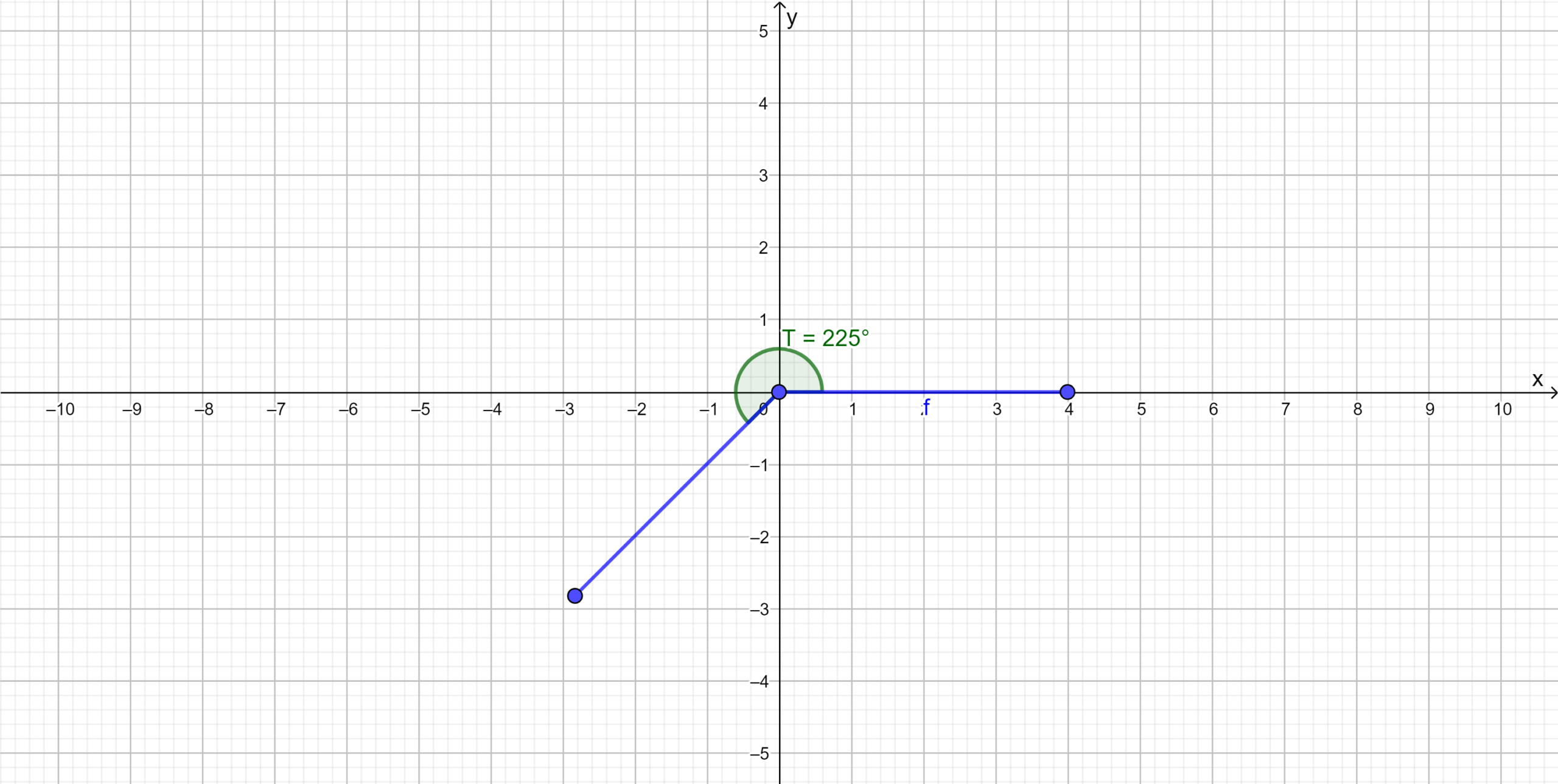
a)750: The terminal arm lies in first quadrant
The graph looks like
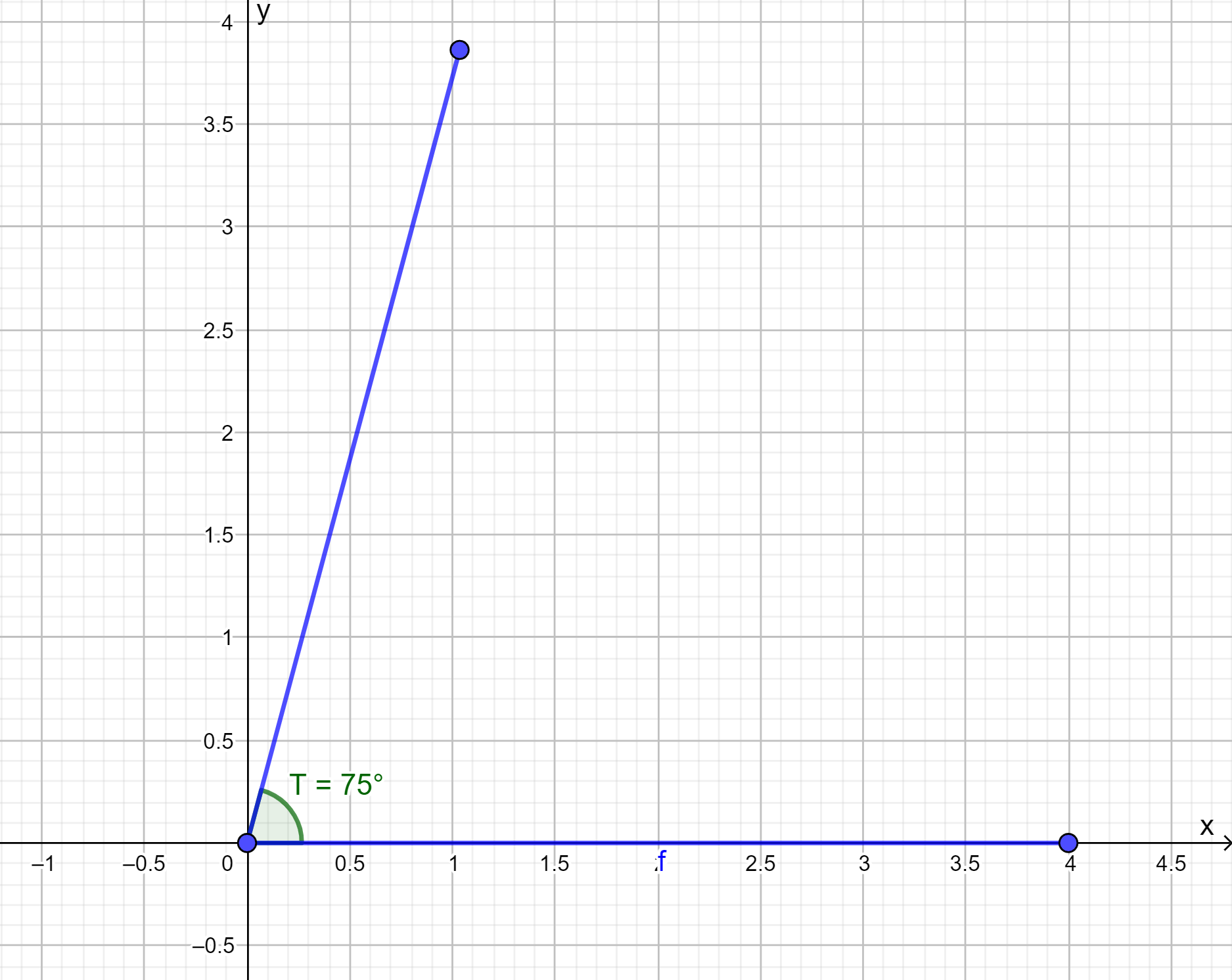
- b) 1050: The terminal arm lies in second quadrant
The graph looks like

- c) 2250: The terminal arm lies in third quadrant
The graph looks like
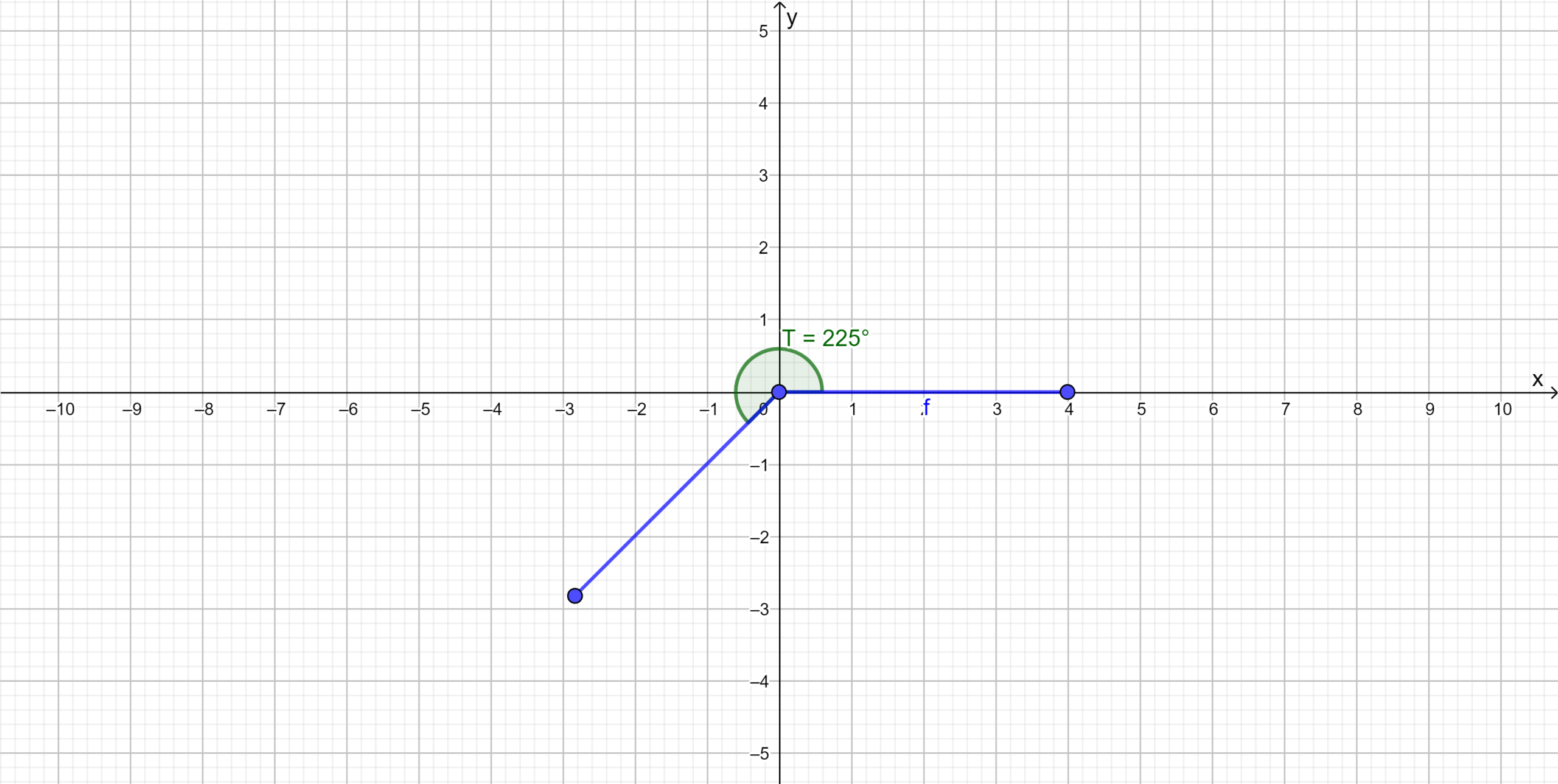
d)3200: The terminal arm lies in third quadrant
The graph looks like
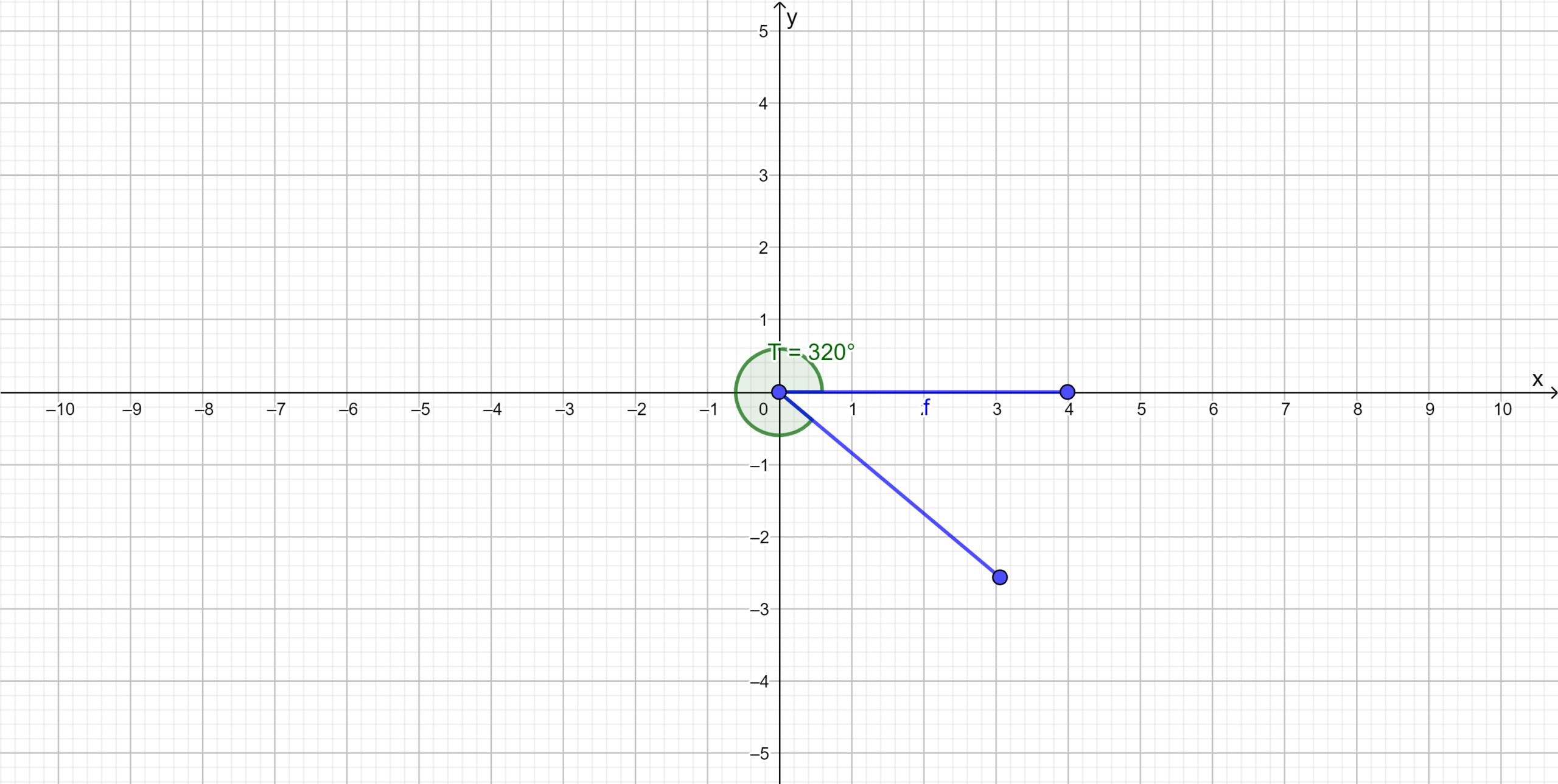
Page 75 Problem 4 Answer
Given: The measurement of Angle is 2900
We need to draw angles in standard position on XY Plane.
Given Angle to be drawn2900
Steps to draw:
- Create a line segment on x-axis.
- Put a proctor with center on (0,0),and aligned to the x-axis and see where the angle of lies.
3.We will put the proctor upside down and will mark at 1100 starting from third quadrant.
Mcgraw Hill Precalculus Textbook Answers
OR
3.We will put the proctor upside down and will mark at 700 starting from third quadrant.
The graph for the same looks as follows:
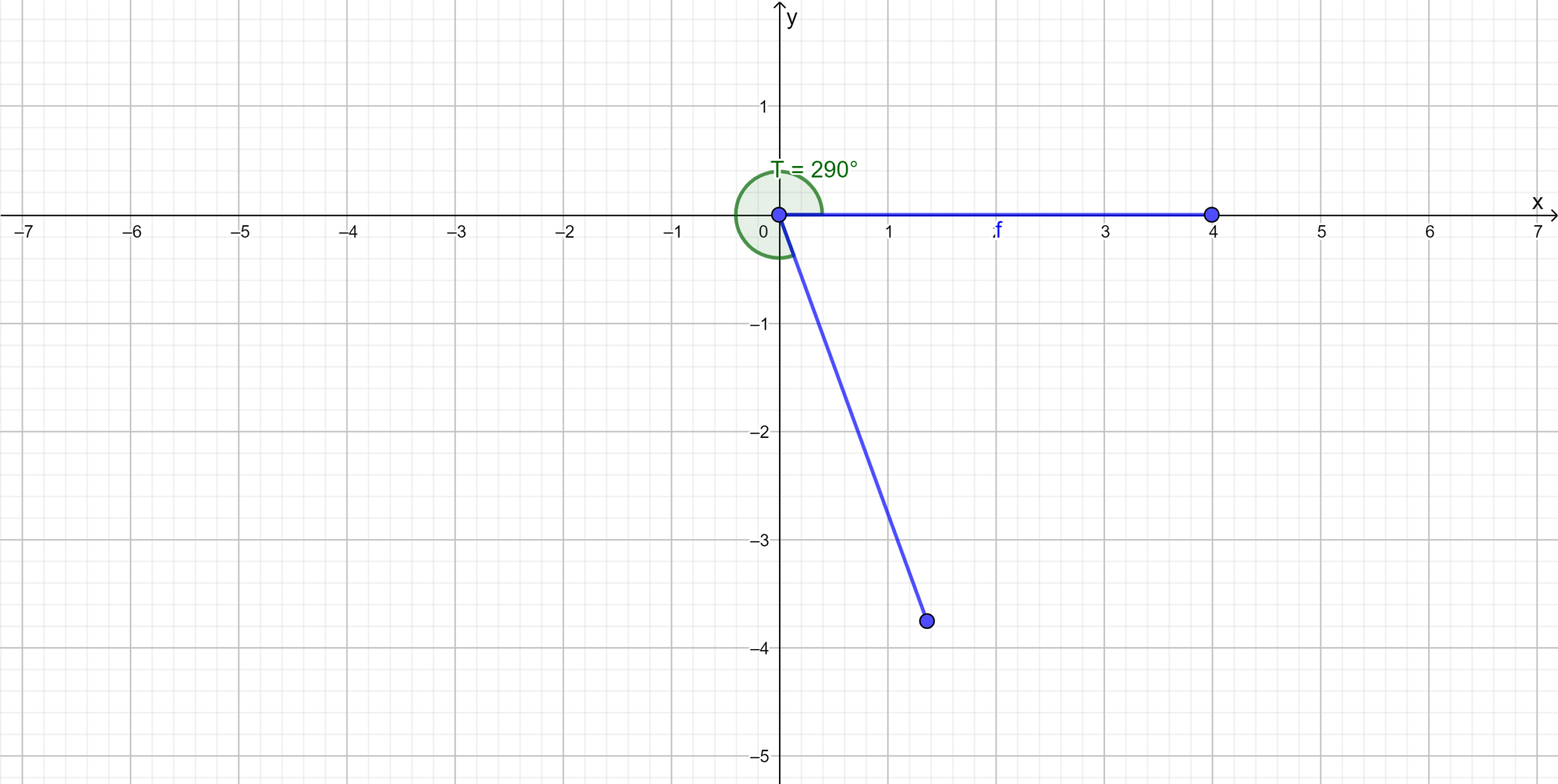
The graph of angle of 2900 looks like

Page 75 Problem 5 Answer
Given- The angle 200 degrees.
To find- The drawing of the angle.
Explanation- The angle between the rays is on the common point that is called the vertex of the angle.
Make use of the protector to draw the required angle.
Draw the horizontal line first, which is called the arm of the angle.
Mark the dot at the angle of 200 degrees on the protector.
Now join the initial point of the arm with the dot to draw the required angle.
Mark the drawn angle.
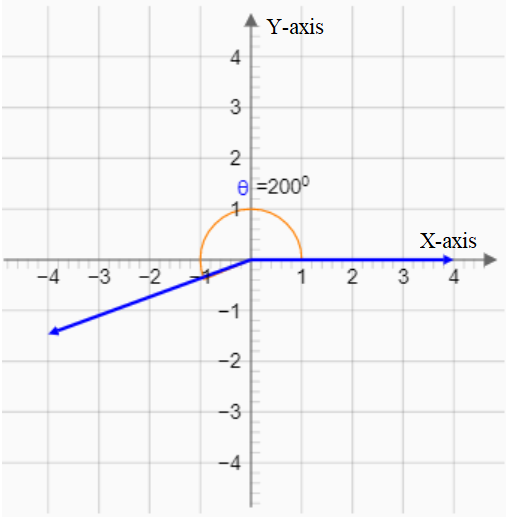
The required drawn angle is
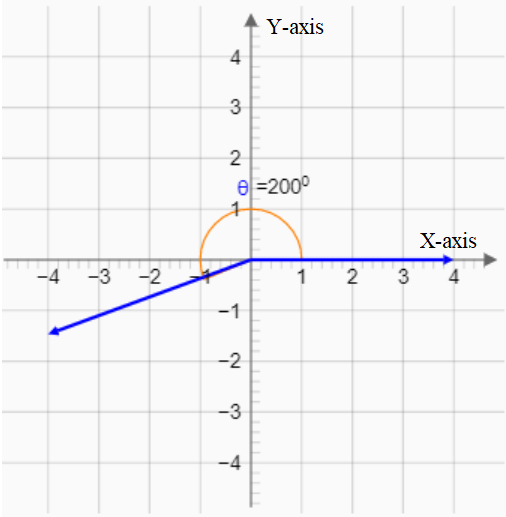
Page 75 Problem 6 Answer
Given- The angle is 130 degrees.
To find- The drawing of the angle.
Explanation- The angle between the rays is on the common point that is called the vertex of the angle.
Make use of the protector to draw the required angle.
Draw the horizontal line first, which is called the arm of the angle.
Precalculus Textbook Mcgraw Hill Answers
Mark the dot at the angle of 130 degrees on the protector.
Now join the initial point of the arm with the dot to draw the required angle.
Mark the drawn angle.

The required drawn angle is

Page 75 Problem 7 Answer
Given- The angle is 325 degrees.
To find- The drawing of the angle.
Explanation- The angle between the rays is on the common point that is called the vertex of the angle.
Make use of the protector to draw the required angle.
Since the angle, 325 degrees is greater than 180 degrees and 325 degrees less than 360 degrees.
Draw the horizontal line first, which is called the arm of the angle.
Mark the dot at the angle of 35 degrees on the protector from the opposite side.
Now join the initial point of the arm with the dot to draw the required angle.
Mark the drawn angle.
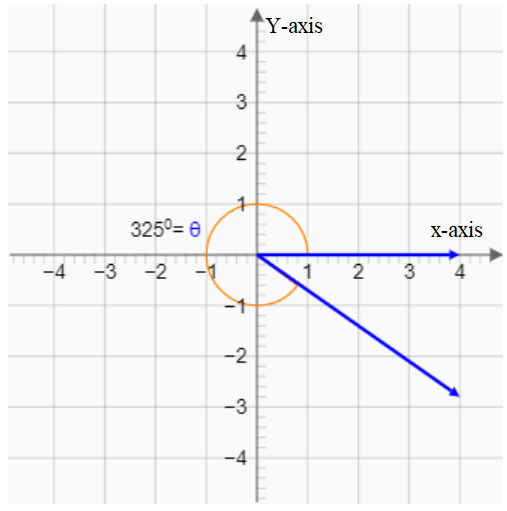
The required drawn angle is

Page 81 Problem 8 Answer
Given: an angle of 60 degrees.
To determine: the angle when the given angle is reflected in the y-axis.
Summary: We will reflect the angle of 60 degrees in y-axis that is we will subtract 60 degrees from 180 degrees and get the required angle.
On subtracting 60 degrees from 180 degrees, we have, 180−60=120.
Thus, the required angle when an angle of 60 degrees is reflected in y-axis is 120 degrees.
Hence, the required angle in standard position is 120 degrees.
Precalculus Textbook Mcgraw Hill Answers
Page 81 Problem 9 Answer
Given: an angle of 60 degrees.
To determine: the angle in standard position when the given angle is reflected in the x-axis.
Summary: We will reflect the angle of 60 degrees in x-axis that is we will subtract 60 degrees from 360 degrees and get the required angle.
On subtracting 60 degrees from 360 degrees, we have, 360−60=300.
Thus, the required angle when an angle of 60 degrees is reflected in x-axis is 300 degrees.
Hence, the required angle in standard position is 300 degrees.
Page 81 Problem 10 Answer
We are given the angle θ=60∘
We have to find standard angle in the y-axis and then in the x-axis after reflection.
Reflecting an angle of 60∘in the y-axis and then in the x-axis will result in a reference angle of 60∘in quadrant III.
The measure of an angle in standard position for quadrant III is 180∘+60∘=240∘
The measure of an angle in standard position for quadrant III is 240∘.
Page 82 Problem 11 Answer
Given that the tempo is adjusted so that the arm of the metronome swings from 45° to 135°.
We have to find what exact horizontal distance does the tip of the arm travel in one beat.
Find the horizontal distance a.
cos45∘=adjacent/hypotenuse
1/√2=a/10
a=10/√2
a=5√2
Because the reference angle for 135° is 45°, the tip moves the same horizontal distance past the vertical position to reach B.
The exact horizontal distance travelled by the tip of the arm in one beat is 2(√5)×2=4√5 cm.
The exact horizontal distance travelled by the tip of the arm in one beat is 4√5 cm.
Page 83 Problem 12 Answer
Given : an angle = 150∘
With the help of the figure given below we can easily match the given angle with its diagram.
Thus the correct diagram of given angle is

Hence the given angle is matched with the correct diagram.

Page 83 Problem 13 Answer
Given : an angle = 180∘
With the help of the figure given below we can easily match the given angle with its diagram.

Hence the given angle is matched with the correct diagram.

Page 83 Problem 14 Answer
Given : an angle = 45∘
With the help of the figure given below we can easily match the given angle with its diagram.
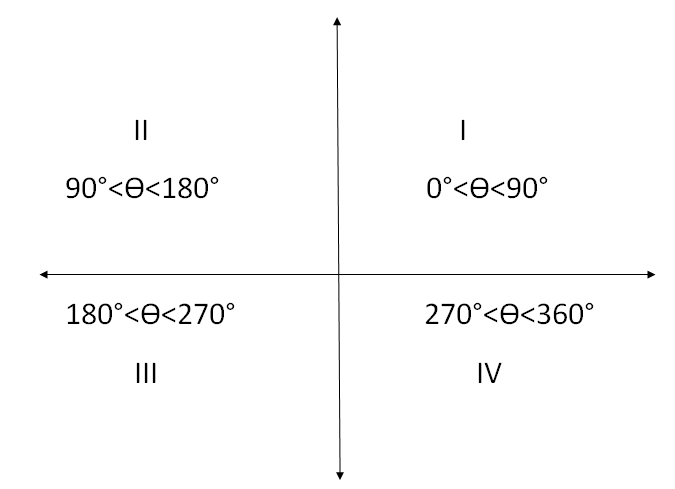
Hence the given angle is matched with the correct diagram.

Page 83 Problem 15 Answer
Given : an angle = 320∘
With the help of the figure given below we can easily match the given angle with its diagram.
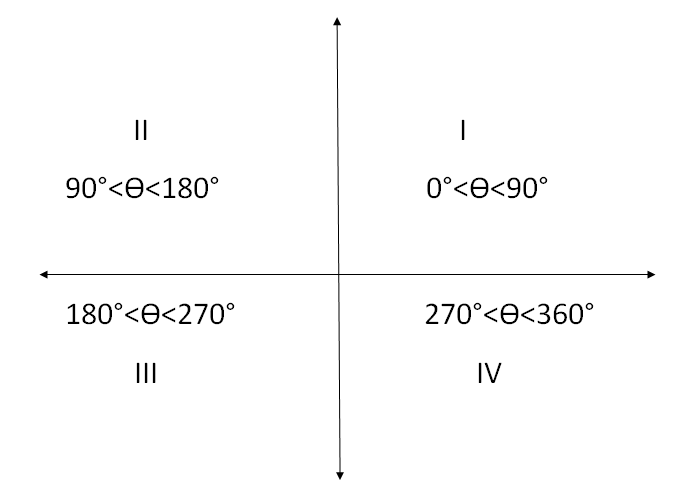
Hence the given angle is matched with the correct diagram.

Page 83 Problem 16 Answer
Given: An angle is given as 215∘.
With the help of the figure given below, the given angle can be matched easily with its diagram.
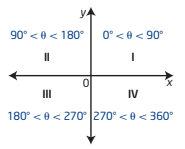
Observe the position of the angle 215∘

from the diagram of the cartesian plane.
It is observed that 215∘is in the range of 180∘<θ<270∘, thus the angle215∘
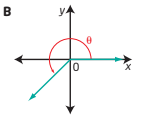
lies in the third quadrant. Therefore the correct option is B.

Hence the angle 215∘matches with diagram B of the angle in standard position.
Page 83 Problem 17 Answer
Given: An angle is given as 270∘.
Precalculus Textbook Mcgraw Hill Answers
With the help of the figure given below, the given angle can be matched easily with its diagram.

Observe the position of the angle270∘

from the diagram of the cartesian plane.

Thus the correct option is E.
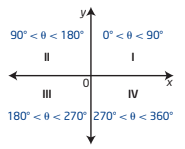
Hence the angle270∘matches with diagram E of the angle in standard position.
Page 83 Problem 18 Answer
Given: Measure of angles are given.
To find: The quadrant in which the terminal arm of each angle lies in standard position.
Observe the diagram of the cartesian plane to find the quadrant in which the terminal arm of each angle lies in standard position.
The diagram of the cartesian plane is shown below:
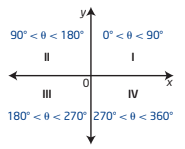
(a)From the diagram is observed that the angle 48∘is in the range of 0∘<θ<90∘, hence the angle lies in the first quadrant.
(b)From the diagram is observed that the angle300∘is in the range of 270∘<θ<360∘
hence the angle lies in the fourth quadrant.
From the diagram is observed that the angle185∘ is in the range of 180∘<θ<270∘hence the angle lies in the third quadrant.
From the diagram is observed that the angle 75∘is in the range of 0∘<θ<90∘hence the angle lies in the first quadrant.
From the diagram is observed that angle 220∘is in the range of180∘<θ<270∘
hence the angle lies in the third quadrant.
From the diagram is observed that the angle 160∘is in the range of 90∘<θ<180∘
hence the angle lies in the second quadrant.
Hence the terminal arm of the angles in standard position lie:
(a)48∘ in the first quadrant.
(b)300∘in the fourth quadrant.
(c) 185∘in the third quadrant.
(d)75∘in the first quadrant.
(e)220∘in the third quadrant.
(f)160∘ in the second quadrant.
Precalculus Textbook Mcgraw Hill Answers
Page 83 Problem 19 Answer
Given: An angle is given as 70∘.
To sketch: An angle in standard position of the angle 70∘.
Sketch the angle 70∘in standard position.
Since 70∘is in the range of 0∘<θ<90∘, so the angle 70∘lies in the first quadrant.
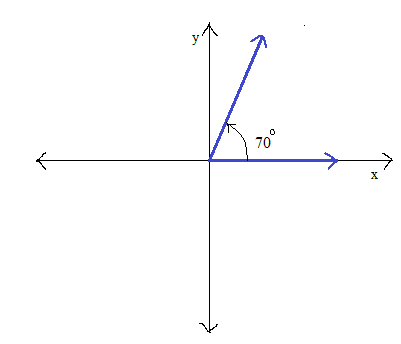
Hence the sketch of the angle 70∘in standard position is
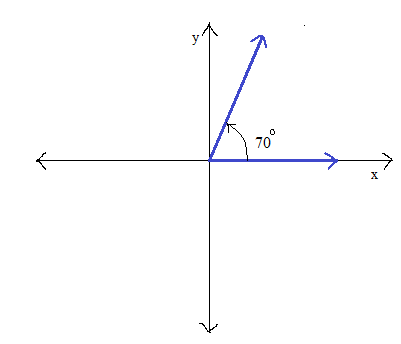
Page 83 Problem 20 Answer
Given: An angle is given as 310∘.
To sketch An angle 310∘in standard position.
Sketch the angle 310∘in standard position.
Since310∘is in the range of270∘<θ<360∘, so 310∘
lies in the fourth quadrant.
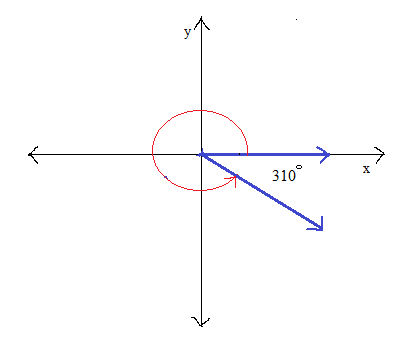
Hence the sketch of 310∘in standard position is
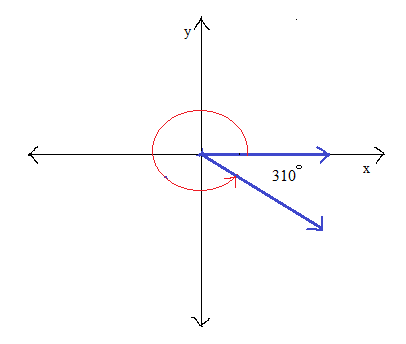
Page 83 Problem 21 Answer
Given: An angle 225°
To sketch: An angle in standard position of the angle 225°.
Now, let us sketch the angle in standard position.
Since,180<θ<270,the terminal arm of θ the lies in the third quadrant.
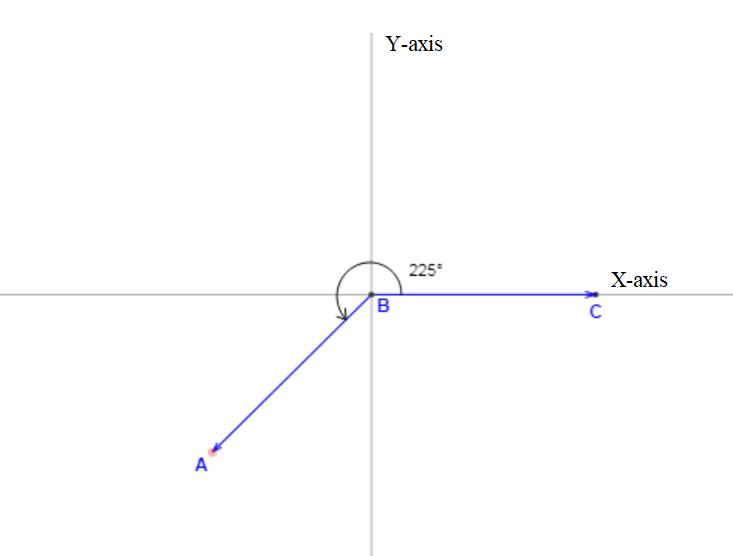
Hence, The sketch an angle of 225° in standard position is
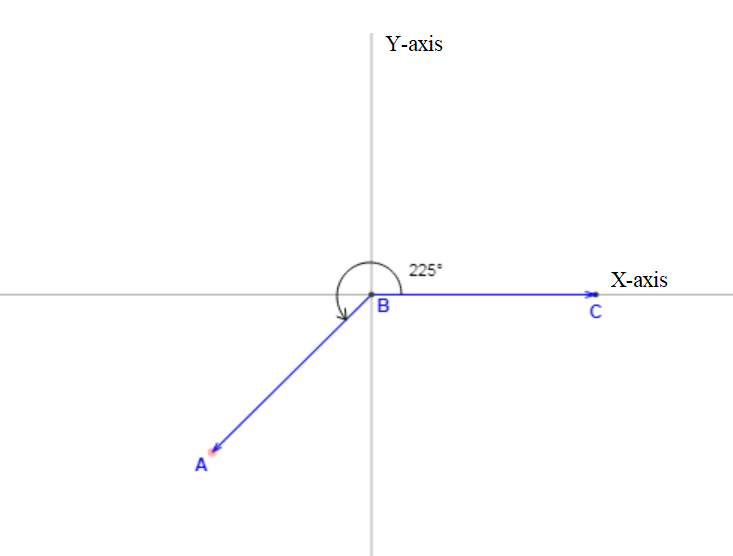
Page 83 Problem 22 Answer
Given: An angle 165°
To sketch: An angle in standard position of the angle 165°.
Now, let us sketch the angle in standard position.
Since,90<θ<180,the terminal arm of the θ lies in the second quadrant.
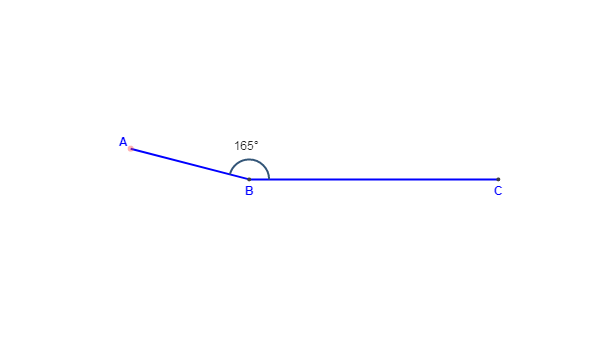
Hence, The sketch an angle of 165° in standard position is
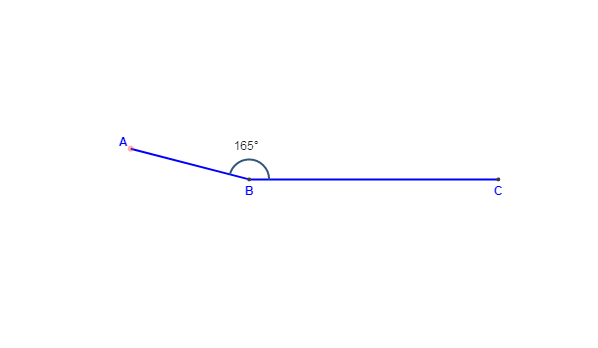
Page 83 Problem 23 Answer
Given: An angle 170°
To find: The reference angle for the angle in standard position.
For every, angle in standard position there exist an acute angle called reference angle.
The reference angle is formed between the terminal angle and x axis.
Given: An angle 170°
To find: The reference angle for the angle in standard position.
First, let us sketch the angle in standard position.
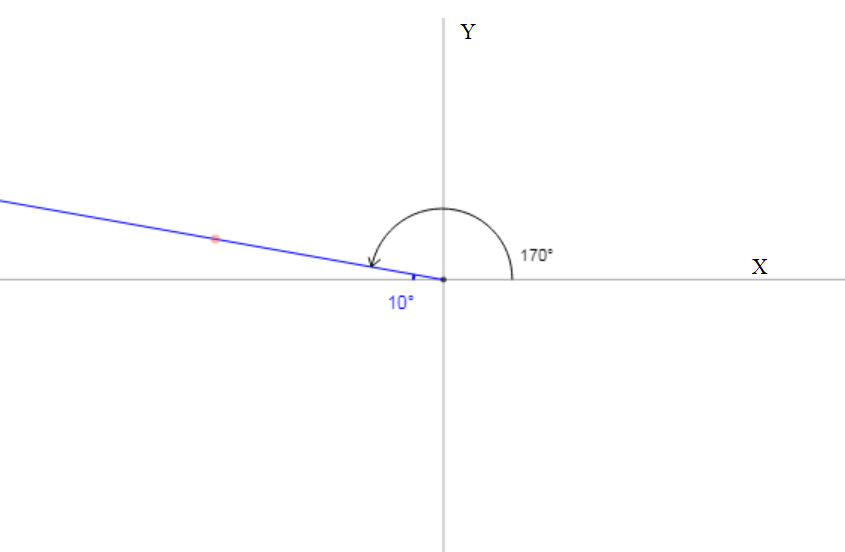
The reference angleθR
=180−170
=10
Hence,the reference angle for each angle in standard position 170° is 10°.
Page 83 Problem 24 Answer
Given: An angle 345°
To find: The reference angle for the angle in standard position.
For every, angle in standard position there exist an acute angle called reference angle.
The reference angle is formed between the terminal angle and x axis.
Given: An angle 345°
To find: The reference angle for the angle in standard position.
First, let us sketch the angle in standard position.
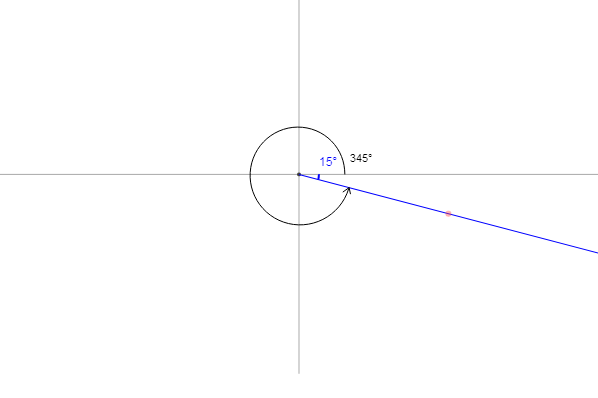
The reference angleθR
=360−345
=15.
Hence,the reference angle for each angle in standard position 345° is 15°.
Page 83 Problem 25 Answer
Given: An angle 72°
To find: The reference angle for the angle in standard position.
For every, angle in standard position there exist an acute angle called reference angle.
The reference angle is formed between the terminal angle and xaxis.
Given: An angle 72°
To find: The reference angle for the angle in standard position.
First, let us sketch the angle in standard position.
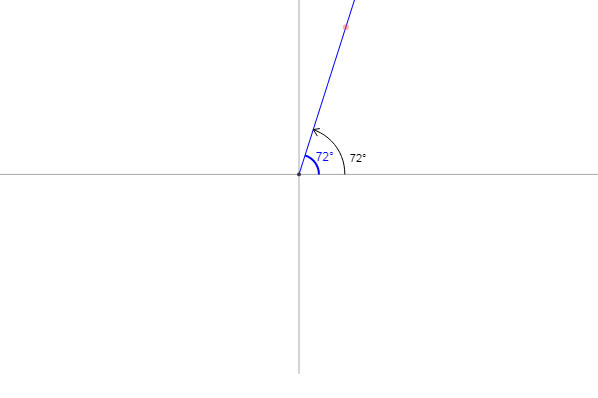
The reference angle θR=72
The value of the reference angle and the value of the angle is same if the angle lies on the first quadrant.
Hence,the reference angle for each angle in standard position 72° is 72°.
Page 83 Problem 26 Answer
Given: An angle 215∘
To find: The reference angle for the angle in standard position.
For every, angle in standard position there exist an acute angle called reference angle.
The reference angle is formed between the terminal angle and x-axis.
First, let us sketch the angle in standard position.
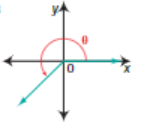
The reference angle θR=215∘−180∘
θR=35∘
Hence,the reference angle for an angle 215∘ in standard position is 35∘
Page 83 Problem 27 Answer
Given: θR=45∘
On adding and subtracting the reference angle from 180∘or 360∘
we get the required standard angles.
First angle is 180∘−45∘=135∘
Second angle is 180∘+45∘=225∘
Third angle is 360∘−45∘=315∘
Hence the three other angles in standard position of the given reference angle are 135∘,255∘,315∘
Page 83 Problem 28 Answer
Given : θR=60∘
On adding and subtracting the reference angle from 180∘or 360∘
we get the required standard angles.
First angle is 180∘−60∘=120∘
Second angle is 180∘+60∘=240∘
Third angle is 360∘−60∘=300∘
Hence the three other angles in standard position of the given reference angle are 120∘.240∘,300∘
Page 83 Problem 29 Answer
Given : θR=30∘
On adding and subtracting the reference angle from 180∘or 360∘
we get the required standard angles.
First angle is 180∘−30∘=150∘
Second angle is 180∘+30∘=210∘
Third angle is 360∘−30∘=330∘
Hence the three other angles in standard position of the given reference angle are 150∘,210∘,330∘.
Page 83 Problem 30 Answer
Given : θR=75∘
On adding and subtracting the reference angle from 180∘or 360∘
we get the required standard angles.
First angle is 180∘−75∘=105∘
Second angle is 180∘+75∘=255∘
Third angle is 360∘−75∘=285∘
Hence the three other angles in standard position of the given reference angle are 105∘,255∘,285∘
McGraw Hill Pre Calculus 11 Student Edition Chapter 1 Practice Test Exercise Sequences and Series
Pre Calculus 11 Student Edition Chapter 1 Sequences and Series
Page 69 Problem 1 Answer
From the given incomplete arithmetic series, we see that the common difference is
d=9−3⇒d=6
So, the first term of the series will be a=3−6
⇒a=−3
The term after 9 will be 9+d=15
Similarly, the term after 15 will be 15+d=21
Hence, the sequence will be −3,3,9,15,21
Therefore, D.−3,15,21 will be the correct option.
We need to find the missing terms of the following arithmetic sequence:
The other options are not matching with the correct series.
Hence, D.−3,15,21 will be the correct option.
Mcgraw Hill Precalculus Textbook Answers
Page 69 Problem 2 Answer
According to the given question, the number of cans in a row follows an arithmetic sequence with the first term a=1 and the common difference d=3.
Read and Learn More Precalculus Textbook Mcgraw Hill Answers
So, the number of cans in row n will be 1+(n−1)×3=3n−2
Hence, B.tn=3n−2 will be the correct option.
The grocery store display cans are arranged in the following order:

The first row contains 1 can and each successive row has 3 more cans than the previous row.
We need to find the correct option that would represent the number of cans in a row n.
Options A and D showed the total number of cans which is not correct.
Option C is not correct because the series do not satisfy the number of cans.
Hence, B.tn=3n−2 will be the correct option.
Page 69 Problem 3 Answer
To find sum of the geometric series 16807 − 2401 + 343 −…
t1 = 16807
n = 5
r = −2401/ 16807= − 1/7
Hence,
Sn =S5 = t1
( (r5 − 1 )/r − 1
S5 = 16807 ( (− 1/7 )5 − 1 )/(−1/7 − 1 )
S5 = 16807 (−1/16807 − 1 )/−1−7/7
S5 = 16807 (− 1 − 16807 )/16807/−8 /7
S5 = −16808 × 7/− 8
S5 = 2101 × 7
S5 = 14707
We have to find the sum of first five terms of geometric series 16807 − 2401 + 343
For option A. 19607 the sum we calculate does not match this option.
For option C. 16807.29 the sum we calculate does not match this option.
For option D. 14706.25 the sum we calculate does not match this option.
Hence the sum of first five terms of geometric series is 14707 which is
Option B 14707
Mcgraw Hill Precalculus Textbook Answers
Page 69 Problem 4 Answer
Given sequence is arithmetic sequence whose first three terms are a,b and c.
We have to find third term i.e. c in terms of a and b.
For that we use formula for general term .
Given sequence is arithmetic sequence whose first three terms are a,b and c.
We have to find third term i.e. c in terms of a and b.
For that we use formula for general term .
For option A. a + b, it does not match answer calculated by general term formula.
For option C. a + ( n − 1 ) b, it does not match answer calculated by general term formula.
For option D. 2 a + b, it does not match answer calculated by general term formula.
Hence the third term c in terms of a and b is 2b −a which is Option B 2b − a
Page 69 Problem 5 Answer
We have to find the third term of the series and 20th term is given as 524288 and 14th term is 8192.
We apply the general term formula for 20th and 14th term and find the values of r and t1 and then we get the value of third term.
Given that 20th term i.e. t20 = 524288
14th term i.e. t14 = 8192
We use the formula for general term
For 20th term, n = 20
tn =t1 /rn−1
524288 =t1/r20−1
524288 =t1/r19
solve for t1
we get t1 = 524288
r19…………..(1)
For 14th term, n = 14
tn =t1 /rn−1
8192 = t1 /r14−1
8192 =t1/r13 ……………(2)
put the value of t1
from ( 1 ) in ( 2 )
8192 = 524288
Mcgraw Hill Precalculus Textbook Answers
r19 ×r13
8192 = 524288/r6
r6 = 524288/8192
r6 = 64
r = 6/√64
r = 2
Substitute value of r in equation (1)
t1 = 524288/219
t 1 =524288/524288
t1 = 1
Hence for finding third term we put n= 3, t1 =1 and r =2 in general term we get,
t3 =t1
r3−1
t3 = 1 ×22
t3 = 4
We have to find third term of the geometric sequence whose 20th term is 524288 and 14th term is 8192.
We find 3rd term by applying general term formula.
For option B. 8 only , it does not match the answer calculated by general term formula.
For option C. + 4 or − 4, it does not match the answer calculated by general term formula.
For option D. + 8 or − 8, it does not match the answer calculated by general term formula.
Hence 3rd term of the sequence is 4 which is Option A. 4 only
Page 69 Problem 6 Answer
We have given the radius of the largest bowl i.e. 30 cm and for each successive bowl radius decreases by 90% and we have to find the radius of tenth bowl.
So we use formula for general term for n = 10 and r =0.90 and find the value of t10
i.e. radius of tenth bowl.
To find radius of tenth bowl, we use formula for general term.
Mcgraw Hill Precalculus Textbook Answers
We have n = 10 , r =0.90,t1 = 30
tn =t1/rn−1
∴ t10
=30 × (0.90)10−1
t10 = 30 × (0.90)9
t10 = 30 × 0.3874
t10 = 11.62
Radius of tenth bowl is 11.62
Page 69 Problem 7 Answer
We have to compare the graph of arithmetic and geometric sequence.
Graphs are given to us and we have to find difference between two graphs.
By seeing above graphs
In the graph of arithmetic sequence all points are equally spaced while in geometric progression distance between two points is not same.
The difference between arithmetic and geometric sequence is that an arithmetic sequence has the difference between its two consecutive terms remains constant while a geometric sequence has the ratio between its two consecutive terms remains constant.
In the graph of arithmetic sequence all points are equally spaced while in geometric progression distance between two points is not same.
The difference between arithmetic and geometric sequence is that an arithmetic sequence has the difference between its two consecutive terms remains constant while a geometric sequence has the ratio between its two consecutive terms remains constant.
Page 70 Problem 8 Answer
Given: An arithmetic sequence,3, A,27.
A geometric sequence,3,B,27.
And, B>0.
To find: the values of A and B.
Since3, A,27 is an arithmetic sequence.
Mcgraw Hill Precalculus Textbook Answers
Then,27−A=A−3
27+3=A+A
30=2A
2A=30
A=30/2
A=15
And,
When3,B,27 is a geometric sequence.
Then,27/B=B/3
By cross multiplication.
B2=27×3
B2=81
B=√81
B=±9
But,B>0
So,B=9
A=15,B=9
Page 70 Problem 9 Answer
Given that she walked 1700 km in 6 years and the percentage increase in the number of kilometers walked every week was 2%.
To find how many kilometeres does she walked in the first week.
Formula for sum of finite series is Sn=a1(rn−1)/r−1
Now, there are 52 weeks in a year this means there are312
weeks in 6 years.
Therefore, a1=?;r=100%+2%=1.02;n=312
17000=a1(1.02312−1)/1.02−1
17000⋅0.02=a1(1.02312−1)/340
(1.02312−1)=a1⋅(1.02312−1)/(1.02312−1)
a1=0.7065=0.71
Therefore, she walked around 0.71 km in the first week.
Page 70 Problem 10 Answer
Given: An arithmetic sequence,5,_, _, _,_,160.
To find: the unknown terms of the sequence.
From the sequence, it is obtained that.
n=6
a6=160
a1=5
Then,
an=a1+(n−1)d
a6=5+(6−1)d
160=5+5d
5d=160−5
5d=155
d=155/5
d=31
Hence,
Mcgraw Hill Precalculus Textbook Answers
a2=a1+(2−1)31=5+(1×31)=5+31=36
a3=a1+(3−1)31=5+(2×31)=5+62=67
a4=a1+(4−1)31=5+(3×31)=5+93=98
a5=a1+(5−1)31=5+(4×31)=5+124=129
The complete sequence is 5,36,67,98,129,160.
Page 70 Problem 11 Answer
Given: An arithmetic sequence,5,_,_,_,_,160.
To find: the general term of the arithmetic sequence.
Note: From the solution of10(a),
the difference of the given sequence,d=31.
From the given sequence it is obtained that.
a1=5
Also,d=31
Then, the general terms of the given sequence are.
an=a1+(n−1)d=5+(n−1)31
The general terms of the given sequence are,an=5+(n−1)31.
Page 70 Problem 12 Answer
Given: a geometric sequence,5,_,_,_,_,160.
To find: the unknown terms of the sequence.
From the sequence, it is obtained that.
n=6
a6=160
a1=5
Then, an=a1.rn−1
a6=a1.r6−1
160=5×(r)5
r5=160/5
r5=32
r5=25
r=2
Hence,
a2=a1.(2)2−1
=5×(2)1
=5×2=10
a3=a1.(2)3−1
=5×(2)2
=5×4=20
a4=a1.(2)4−1
=5×(2)3
=5×8=40
a5=a1.(2)5−1
=5×(2)4
=5×16=80
The complete sequence is5,10,20,40,80,160.
Precalculus Textbook Mcgraw Hill Answers
Page 70 Problem 13 Answer
the Given: First and last term of the geometric sequence is 5 and 160 respectively.
The first term of the geometric sequence is 5, so the value of a is 5.
From part d, the value of the common ratio, r is 2.
Determine the general term of the given geometric sequence.
an=5⋅2n−1
The general term of the geometric sequence is an=5⋅2n−1.
Page 70 Problem 14 Answer
Since the exposure time has a constant increment, the given problem can be solved by Arithmetic Progression.
The exposure time for the first day is 30s, therefore the first term of the series is a=30
The exposure increases by 30s each day. Therefore, the common difference of the terms is d=30.
Obtain first five terms by following the mentioned formula.
The second term is 30+30=60
The third term is 60+30=90
The fourth term is 90+30=120
The fifth term is 120+30=150.
Therefore the first five term of the sequence are 30,60,90,120,150.
The first five terms of the sequence are 30,60,90,120,150.
Page 70 Problem 15 Answer
For the given problem, the exposure increases at a constant rate of 30s each day.
Since the increment is constant, the given problem follows the Arithmetic progression.
The given sequence is Arithmetic.
Page 70 Problem 16 Answer
To reach the goal of 30 minutes, that is of 30×60=1800 seconds means to obtain the term with the term 1800.
For this problem, the first term a is 30
The common difference d is 30 the nth term tn is 1800
Substitute these values in the mentioned formula and simplify to obtain the value of the number of days a patient take to reach the goal that is the value of n
1800=30+(n−1)30
1800=30+30n−30
30n=1800
n=60
Therefore, on the 60 th day, the goal will be reached.
60 days are required to reach the goal.
Precalculus Textbook Mcgraw Hill Answers
Page 70 Problem 17 Answer
To find the total number of minutes of the Sun exposure we have to find the sum of the sequence converted in seconds.
The first element is a=30
The common difference is d=30
The number of days are n=60
Substitute these values in the mentioned formula to obtain the final sum.
Sn=60/2(2⋅30+(60−1)30)
Sn=30(60+59⋅30)
Sn=30⋅30(2+59)
Sn=900⋅61
Sn=54900
Therefore the patient spends total 54900 seconds to reach the goal.
54900 seconds = 54900/60
=915minutes
The total number of Sun exposure is 915 when a patient reaches the goal.
Page 71 Problem 18 Answer
Gold can be an interesting natural resource that can be researched on.
In 1850’s British Columbia had a discovery of Gold. Later in 1896 the Klondike district of now known Yukon territory had a discovery of Gold which created a world wide rush in the demand and the industry of Gold.
The sequence of times when gold mines were discovered had a gap of on and average of 40 years.
The first term of this sequence can be assumed as 1856.
As the difference of the first and the second discoveries were about 40 years, assuming the discoveries in an Arithmetic Progression, we can assume that in next ten years, there might not be a great inventory of the production of Gold.Production of Gold has a big effect on the community as well as on the business, specially on the jewellery industry.
Gold is used in a huge amount to make fine ornaments as well as in recent days in clothings also.
Gold can be an interesting natural resource that can be researched on. In 1850’s British Columbia had a discovery of Gold.
Later in 1896 the Klondike district of now known Yukon territory had a discovery of Gold which created a world wide rush in the demand and the industry of Gold.
The sequence of times when gold mines were discovered had a gap of on and average of 40 years.
The first term of this sequence can be assumed as 1856.
As the difference of the first and the second discoveries were about 40 years, assuming the discoveries in an Arithmetic Progression, we can assume that in next ten years, there might not be a great inventory of the production of Gold.
Production of Gold has a big effect on the community as well as on the business, specially on the jewellery industry.
Gold is used in a huge amount to make fine ornaments as well as in recent days in clothings also.
